SWOT Analysis: SME Lending at Doha Bank 9
VerifiedAdded on 2020/12/23
|61
|15795
|307
AI Summary
REPORT FORMATTING TABLE OF CONTENTS ACKNOWLEDGEMENTS vi EXECUTIVE SUMMARY CHAPTER 1 1 INTRODUCTION 1 1.1 Background 1 1.2 Project 2 1.3 Significance of the study 3 1.4 Methodology 3 1.5 Limitation 4 1.6 Chapter Framework 5 CHAPTER 2 6 PROBLEM IDENTIFICATION 6 2.1 Introduction 6 2.2 Organization Profile 6 2.3 Organizational Analysis: SME Lending at Doha Bank 9 2.3.1 SWOT Analysis: SME Lending at Doha Bank 9 2.3.1.1 Strengths 10 2.3.1.2 Weakness
Contribute Materials
Your contribution can guide someone’s learning journey. Share your
documents today.
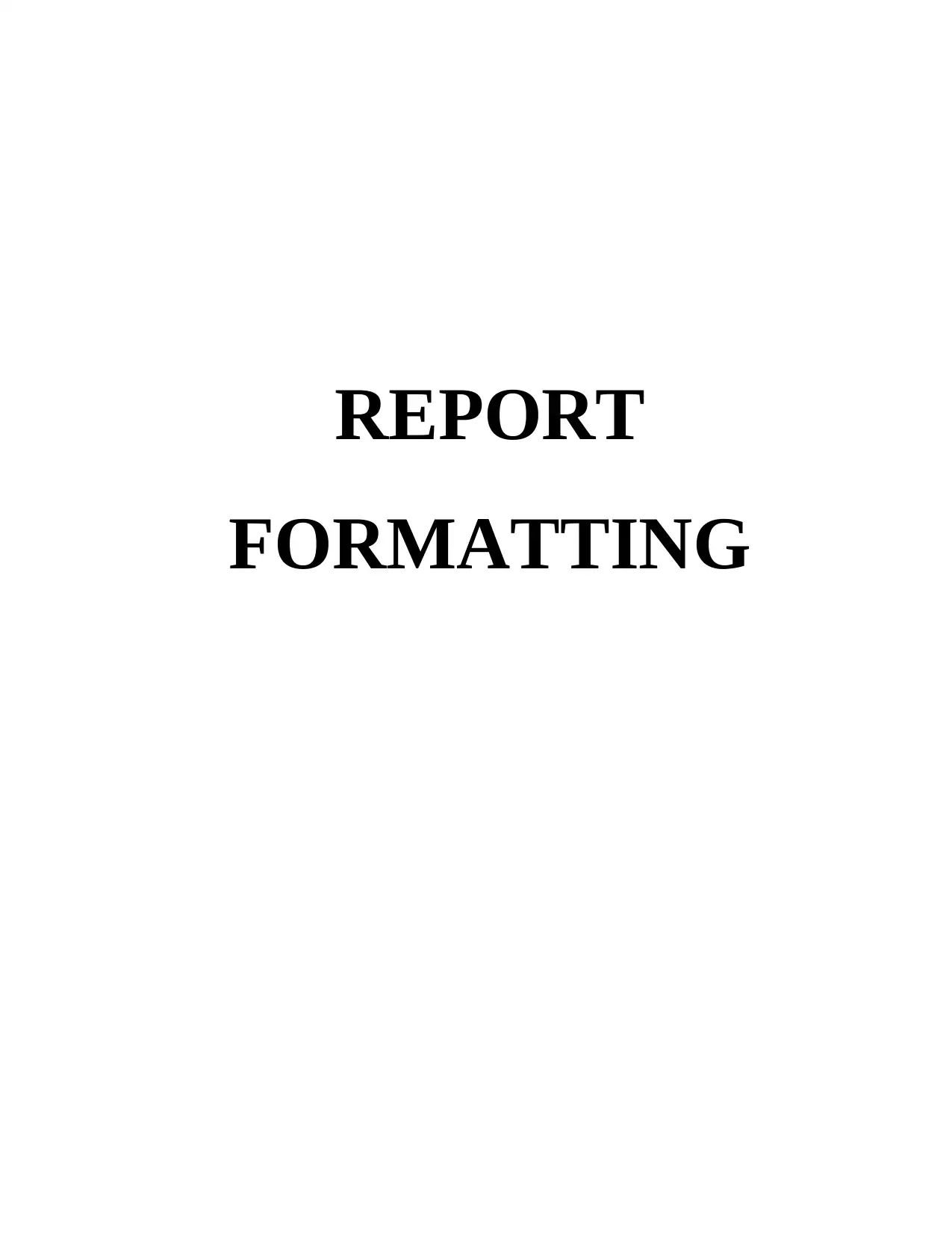
REPORT
FORMATTING
FORMATTING
Secure Best Marks with AI Grader
Need help grading? Try our AI Grader for instant feedback on your assignments.
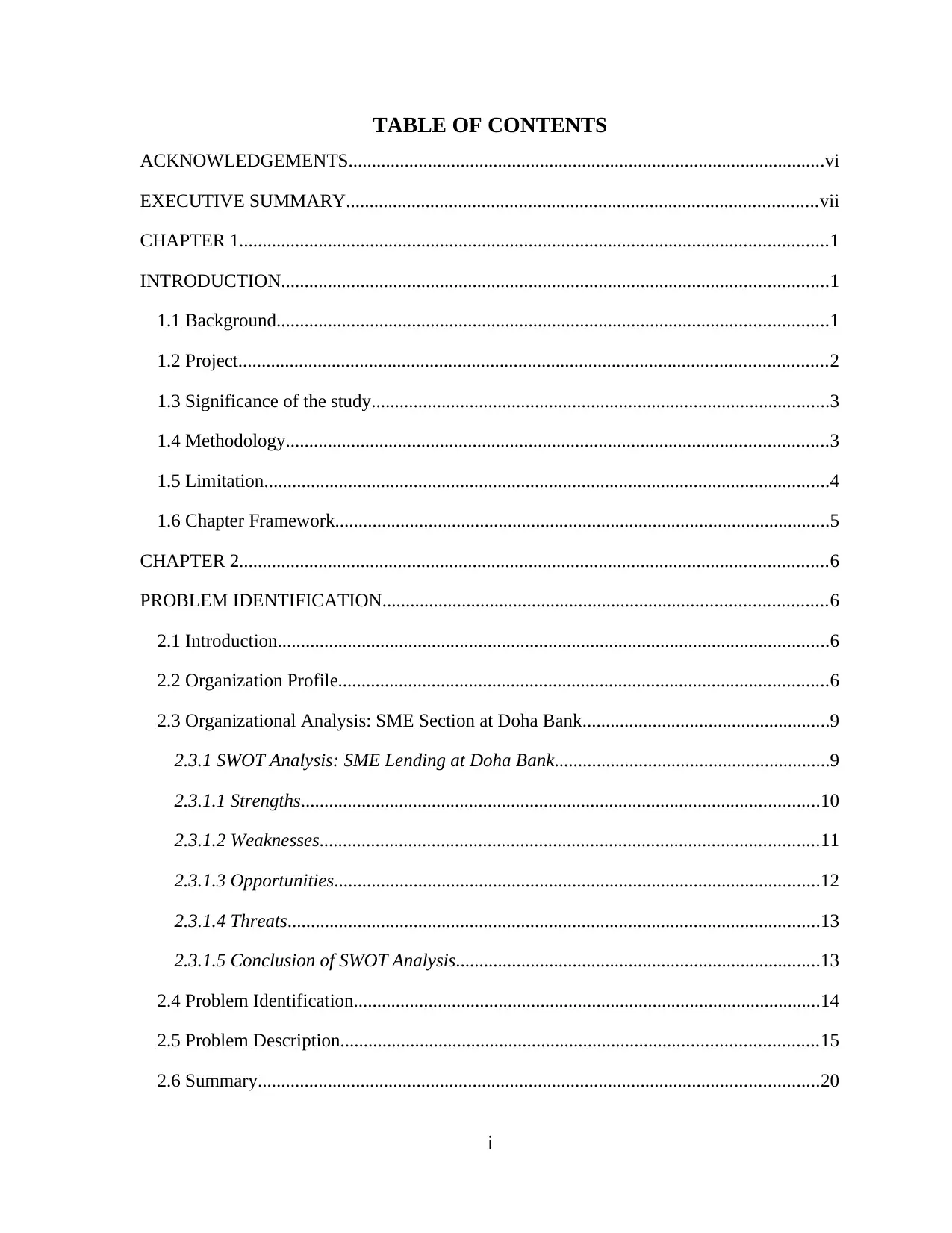
TABLE OF CONTENTS
ACKNOWLEDGEMENTS......................................................................................................vi
EXECUTIVE SUMMARY.....................................................................................................vii
CHAPTER 1..............................................................................................................................1
INTRODUCTION.....................................................................................................................1
1.1 Background......................................................................................................................1
1.2 Project..............................................................................................................................2
1.3 Significance of the study..................................................................................................3
1.4 Methodology....................................................................................................................3
1.5 Limitation.........................................................................................................................4
1.6 Chapter Framework..........................................................................................................5
CHAPTER 2..............................................................................................................................6
PROBLEM IDENTIFICATION...............................................................................................6
2.1 Introduction......................................................................................................................6
2.2 Organization Profile.........................................................................................................6
2.3 Organizational Analysis: SME Section at Doha Bank.....................................................9
2.3.1 SWOT Analysis: SME Lending at Doha Bank...........................................................9
2.3.1.1 Strengths...............................................................................................................10
2.3.1.2 Weaknesses...........................................................................................................11
2.3.1.3 Opportunities........................................................................................................12
2.3.1.4 Threats..................................................................................................................13
2.3.1.5 Conclusion of SWOT Analysis..............................................................................13
2.4 Problem Identification....................................................................................................14
2.5 Problem Description......................................................................................................15
2.6 Summary........................................................................................................................20
i
ACKNOWLEDGEMENTS......................................................................................................vi
EXECUTIVE SUMMARY.....................................................................................................vii
CHAPTER 1..............................................................................................................................1
INTRODUCTION.....................................................................................................................1
1.1 Background......................................................................................................................1
1.2 Project..............................................................................................................................2
1.3 Significance of the study..................................................................................................3
1.4 Methodology....................................................................................................................3
1.5 Limitation.........................................................................................................................4
1.6 Chapter Framework..........................................................................................................5
CHAPTER 2..............................................................................................................................6
PROBLEM IDENTIFICATION...............................................................................................6
2.1 Introduction......................................................................................................................6
2.2 Organization Profile.........................................................................................................6
2.3 Organizational Analysis: SME Section at Doha Bank.....................................................9
2.3.1 SWOT Analysis: SME Lending at Doha Bank...........................................................9
2.3.1.1 Strengths...............................................................................................................10
2.3.1.2 Weaknesses...........................................................................................................11
2.3.1.3 Opportunities........................................................................................................12
2.3.1.4 Threats..................................................................................................................13
2.3.1.5 Conclusion of SWOT Analysis..............................................................................13
2.4 Problem Identification....................................................................................................14
2.5 Problem Description......................................................................................................15
2.6 Summary........................................................................................................................20
i
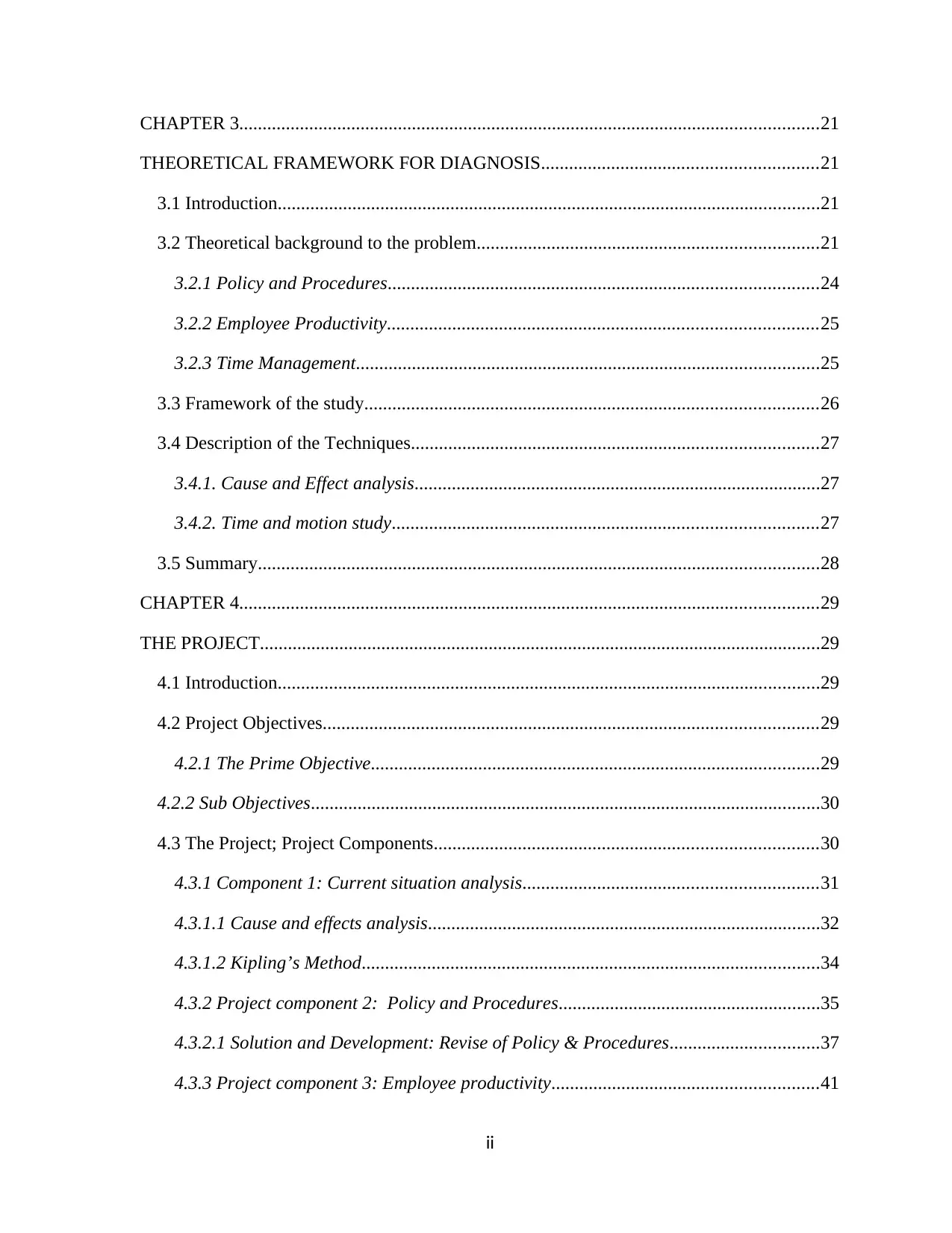
CHAPTER 3............................................................................................................................21
THEORETICAL FRAMEWORK FOR DIAGNOSIS...........................................................21
3.1 Introduction....................................................................................................................21
3.2 Theoretical background to the problem.........................................................................21
3.2.1 Policy and Procedures............................................................................................24
3.2.2 Employee Productivity............................................................................................25
3.2.3 Time Management...................................................................................................25
3.3 Framework of the study.................................................................................................26
3.4 Description of the Techniques.......................................................................................27
3.4.1. Cause and Effect analysis.......................................................................................27
3.4.2. Time and motion study...........................................................................................27
3.5 Summary........................................................................................................................28
CHAPTER 4............................................................................................................................29
THE PROJECT........................................................................................................................29
4.1 Introduction....................................................................................................................29
4.2 Project Objectives..........................................................................................................29
4.2.1 The Prime Objective................................................................................................29
4.2.2 Sub Objectives.............................................................................................................30
4.3 The Project; Project Components..................................................................................30
4.3.1 Component 1: Current situation analysis...............................................................31
4.3.1.1 Cause and effects analysis....................................................................................32
4.3.1.2 Kipling’s Method..................................................................................................34
4.3.2 Project component 2: Policy and Procedures........................................................35
4.3.2.1 Solution and Development: Revise of Policy & Procedures................................37
4.3.3 Project component 3: Employee productivity.........................................................41
ii
THEORETICAL FRAMEWORK FOR DIAGNOSIS...........................................................21
3.1 Introduction....................................................................................................................21
3.2 Theoretical background to the problem.........................................................................21
3.2.1 Policy and Procedures............................................................................................24
3.2.2 Employee Productivity............................................................................................25
3.2.3 Time Management...................................................................................................25
3.3 Framework of the study.................................................................................................26
3.4 Description of the Techniques.......................................................................................27
3.4.1. Cause and Effect analysis.......................................................................................27
3.4.2. Time and motion study...........................................................................................27
3.5 Summary........................................................................................................................28
CHAPTER 4............................................................................................................................29
THE PROJECT........................................................................................................................29
4.1 Introduction....................................................................................................................29
4.2 Project Objectives..........................................................................................................29
4.2.1 The Prime Objective................................................................................................29
4.2.2 Sub Objectives.............................................................................................................30
4.3 The Project; Project Components..................................................................................30
4.3.1 Component 1: Current situation analysis...............................................................31
4.3.1.1 Cause and effects analysis....................................................................................32
4.3.1.2 Kipling’s Method..................................................................................................34
4.3.2 Project component 2: Policy and Procedures........................................................35
4.3.2.1 Solution and Development: Revise of Policy & Procedures................................37
4.3.3 Project component 3: Employee productivity.........................................................41
ii
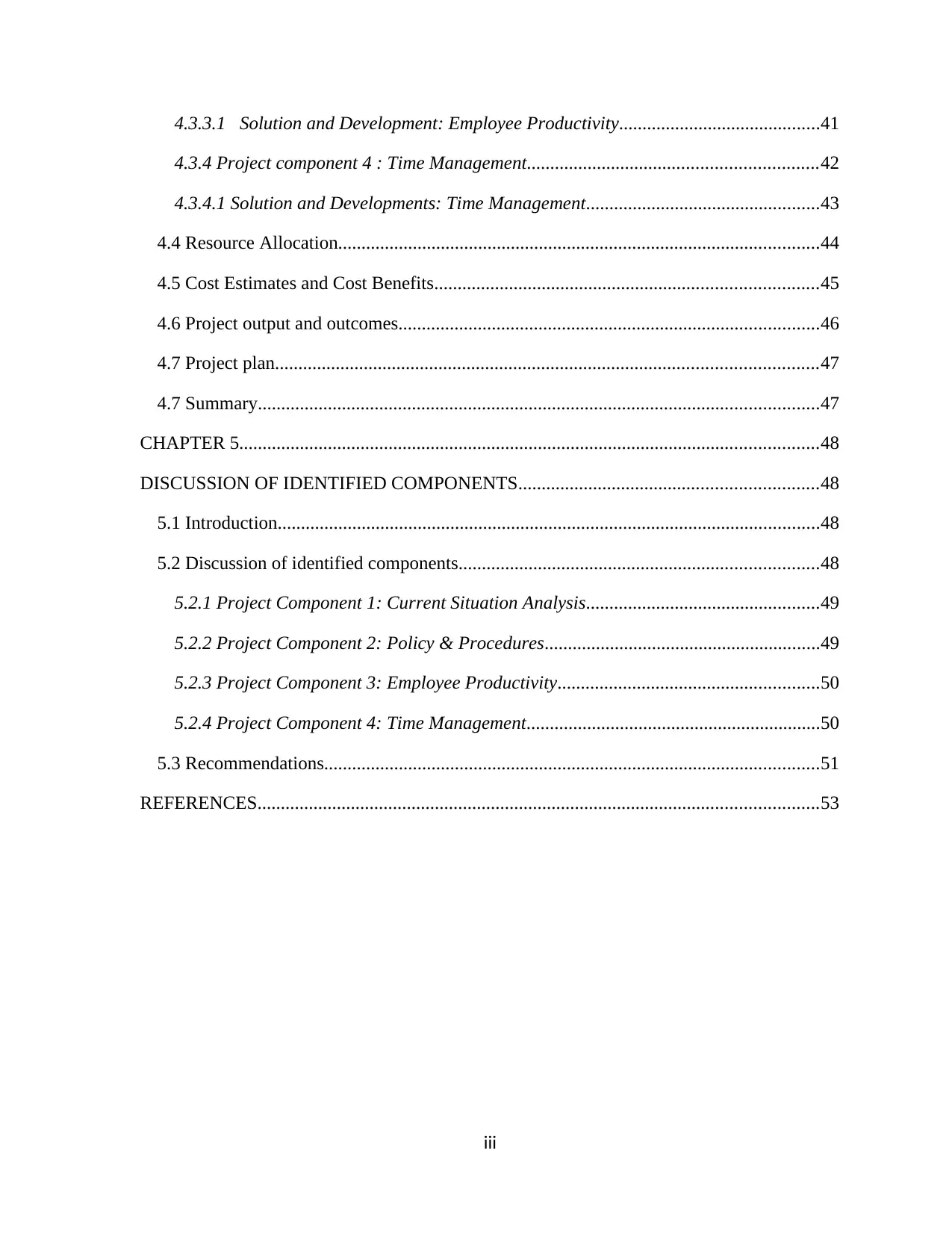
4.3.3.1 Solution and Development: Employee Productivity...........................................41
4.3.4 Project component 4 : Time Management..............................................................42
4.3.4.1 Solution and Developments: Time Management..................................................43
4.4 Resource Allocation.......................................................................................................44
4.5 Cost Estimates and Cost Benefits..................................................................................45
4.6 Project output and outcomes..........................................................................................46
4.7 Project plan....................................................................................................................47
4.7 Summary........................................................................................................................47
CHAPTER 5............................................................................................................................48
DISCUSSION OF IDENTIFIED COMPONENTS................................................................48
5.1 Introduction....................................................................................................................48
5.2 Discussion of identified components.............................................................................48
5.2.1 Project Component 1: Current Situation Analysis..................................................49
5.2.2 Project Component 2: Policy & Procedures...........................................................49
5.2.3 Project Component 3: Employee Productivity........................................................50
5.2.4 Project Component 4: Time Management...............................................................50
5.3 Recommendations..........................................................................................................51
REFERENCES........................................................................................................................53
iii
4.3.4 Project component 4 : Time Management..............................................................42
4.3.4.1 Solution and Developments: Time Management..................................................43
4.4 Resource Allocation.......................................................................................................44
4.5 Cost Estimates and Cost Benefits..................................................................................45
4.6 Project output and outcomes..........................................................................................46
4.7 Project plan....................................................................................................................47
4.7 Summary........................................................................................................................47
CHAPTER 5............................................................................................................................48
DISCUSSION OF IDENTIFIED COMPONENTS................................................................48
5.1 Introduction....................................................................................................................48
5.2 Discussion of identified components.............................................................................48
5.2.1 Project Component 1: Current Situation Analysis..................................................49
5.2.2 Project Component 2: Policy & Procedures...........................................................49
5.2.3 Project Component 3: Employee Productivity........................................................50
5.2.4 Project Component 4: Time Management...............................................................50
5.3 Recommendations..........................................................................................................51
REFERENCES........................................................................................................................53
iii
Secure Best Marks with AI Grader
Need help grading? Try our AI Grader for instant feedback on your assignments.

LIST OF TABLES
TABLE 2. 1: FINANCIAL HIGHLIGHTS...............................................................................7
TABLE 2. 2: RATIO ANALYSIS............................................................................................8
TABLE 2. 3 SWOT ANALYSIS..............................................................................................9
TABLE 2. 4 APPLICATION PROCESSING.........................................................................16
TABLE 2. 5 DB KEY PERFORMANCE AREAS.................................................................17
TABLE 2. 6 NUMBER OF COMPLAINTS...........................................................................18
TABLE 2. 7 SME COMPLAINTS AND IMPACT................................................................19
P
TABLE 4. 1 PROJECT COMPONENTS AND TECHNIQUES............................................30
TABLE 4. 2 CURRENT SITUATION ANALYSIS TOOLS.................................................32
TABLE 4. 3: KIPLING’S METHOD......................................................................................34
TABLE 4. 4: LOAN PROCESS- WORKFLOW CHART.....................................................37
TABLE 4. 5: POLICY AND PROCEDURE AMENDMENTS.............................................37
TABLE 4. 6: TURNAROUND TIME VS LOAN PROCESS STAGES................................42
TABLE 4. 7: TIME AND MOTION STUDY LOAN PROCESS WORKFLOW..................43
TABLE 4. 8: RESOURCE ALLOCATION OF PROJECT....................................................44
TABLE 4. 9: COST ESTIMATES..........................................................................................45
TABLE 4. 10: COST BENEFITS...........................................................................................46
TABLE 4. 11: PROJECT OUTPUT /OUTCOMES................................................................46
TABLE 4. 12: PROJECT TIME PLANNERS........................................................................47
iv
TABLE 2. 1: FINANCIAL HIGHLIGHTS...............................................................................7
TABLE 2. 2: RATIO ANALYSIS............................................................................................8
TABLE 2. 3 SWOT ANALYSIS..............................................................................................9
TABLE 2. 4 APPLICATION PROCESSING.........................................................................16
TABLE 2. 5 DB KEY PERFORMANCE AREAS.................................................................17
TABLE 2. 6 NUMBER OF COMPLAINTS...........................................................................18
TABLE 2. 7 SME COMPLAINTS AND IMPACT................................................................19
P
TABLE 4. 1 PROJECT COMPONENTS AND TECHNIQUES............................................30
TABLE 4. 2 CURRENT SITUATION ANALYSIS TOOLS.................................................32
TABLE 4. 3: KIPLING’S METHOD......................................................................................34
TABLE 4. 4: LOAN PROCESS- WORKFLOW CHART.....................................................37
TABLE 4. 5: POLICY AND PROCEDURE AMENDMENTS.............................................37
TABLE 4. 6: TURNAROUND TIME VS LOAN PROCESS STAGES................................42
TABLE 4. 7: TIME AND MOTION STUDY LOAN PROCESS WORKFLOW..................43
TABLE 4. 8: RESOURCE ALLOCATION OF PROJECT....................................................44
TABLE 4. 9: COST ESTIMATES..........................................................................................45
TABLE 4. 10: COST BENEFITS...........................................................................................46
TABLE 4. 11: PROJECT OUTPUT /OUTCOMES................................................................46
TABLE 4. 12: PROJECT TIME PLANNERS........................................................................47
iv
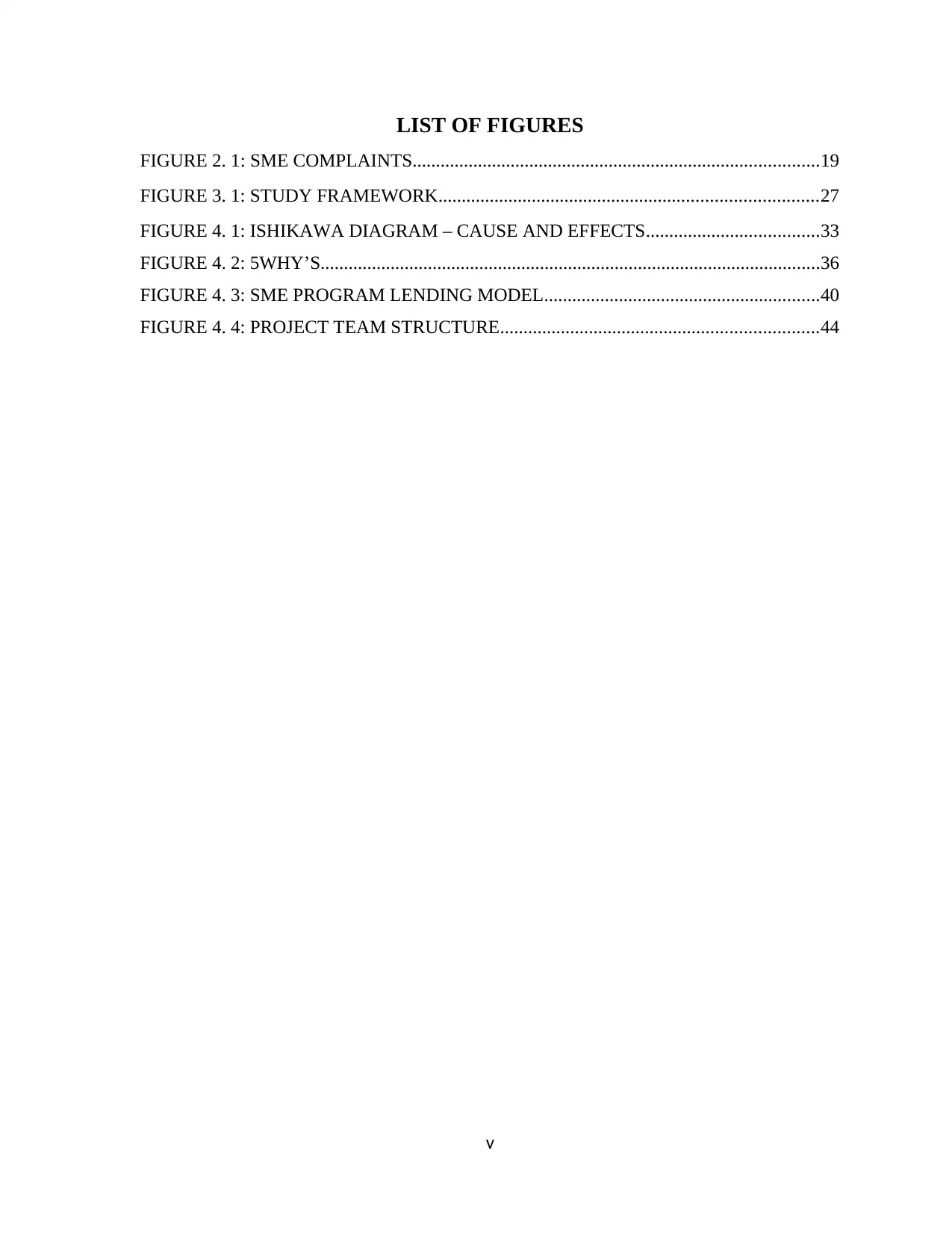
LIST OF FIGURES
FIGURE 2. 1: SME COMPLAINTS.......................................................................................19
a
FIGURE 3. 1: STUDY FRAMEWORK.................................................................................27
b
FIGURE 4. 1: ISHIKAWA DIAGRAM – CAUSE AND EFFECTS.....................................33
FIGURE 4. 2: 5WHY’S...........................................................................................................36
FIGURE 4. 3: SME PROGRAM LENDING MODEL...........................................................40
FIGURE 4. 4: PROJECT TEAM STRUCTURE....................................................................44
v
FIGURE 2. 1: SME COMPLAINTS.......................................................................................19
a
FIGURE 3. 1: STUDY FRAMEWORK.................................................................................27
b
FIGURE 4. 1: ISHIKAWA DIAGRAM – CAUSE AND EFFECTS.....................................33
FIGURE 4. 2: 5WHY’S...........................................................................................................36
FIGURE 4. 3: SME PROGRAM LENDING MODEL...........................................................40
FIGURE 4. 4: PROJECT TEAM STRUCTURE....................................................................44
v
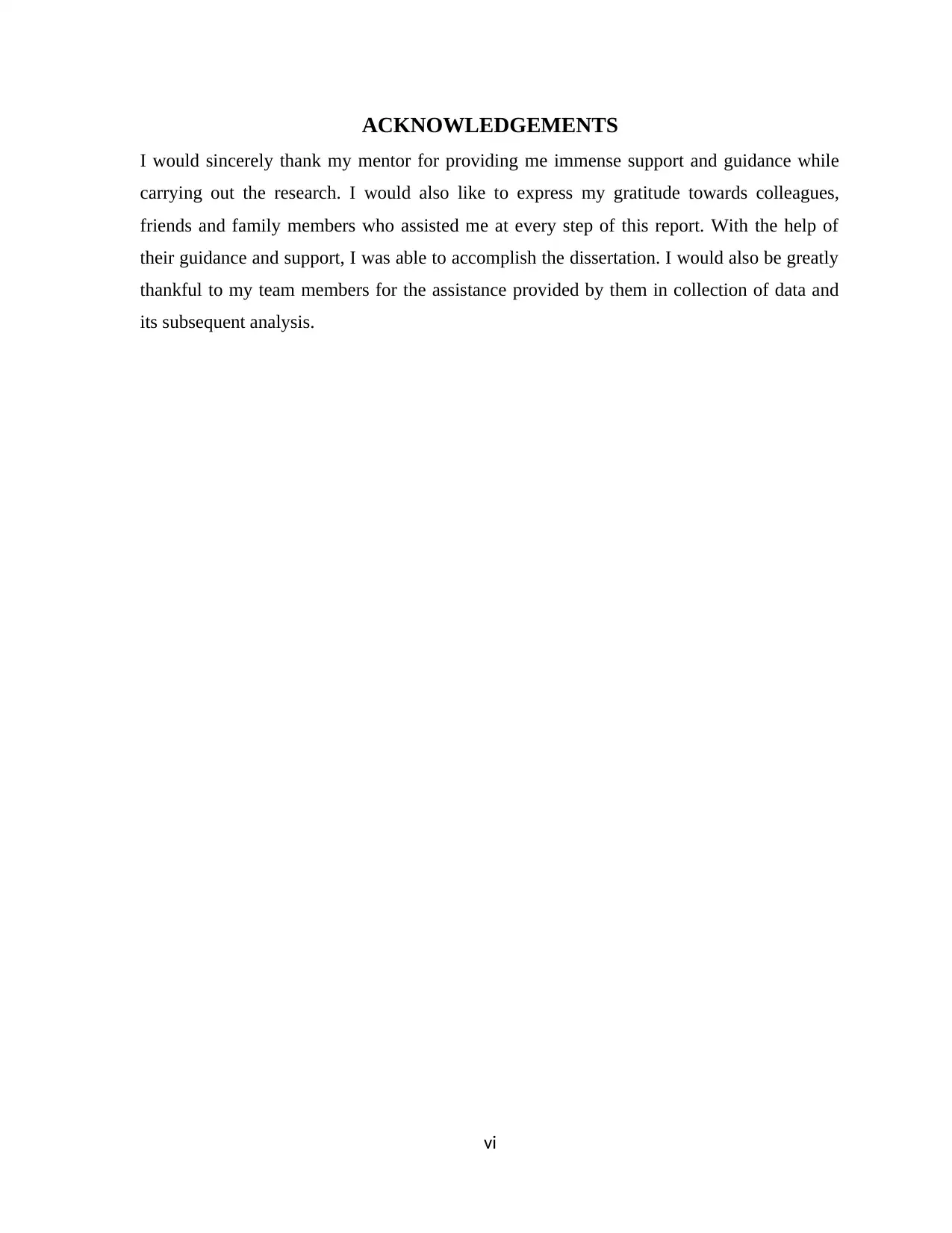
ACKNOWLEDGEMENTS
I would sincerely thank my mentor for providing me immense support and guidance while
carrying out the research. I would also like to express my gratitude towards colleagues,
friends and family members who assisted me at every step of this report. With the help of
their guidance and support, I was able to accomplish the dissertation. I would also be greatly
thankful to my team members for the assistance provided by them in collection of data and
its subsequent analysis.
vi
I would sincerely thank my mentor for providing me immense support and guidance while
carrying out the research. I would also like to express my gratitude towards colleagues,
friends and family members who assisted me at every step of this report. With the help of
their guidance and support, I was able to accomplish the dissertation. I would also be greatly
thankful to my team members for the assistance provided by them in collection of data and
its subsequent analysis.
vi
Paraphrase This Document
Need a fresh take? Get an instant paraphrase of this document with our AI Paraphraser
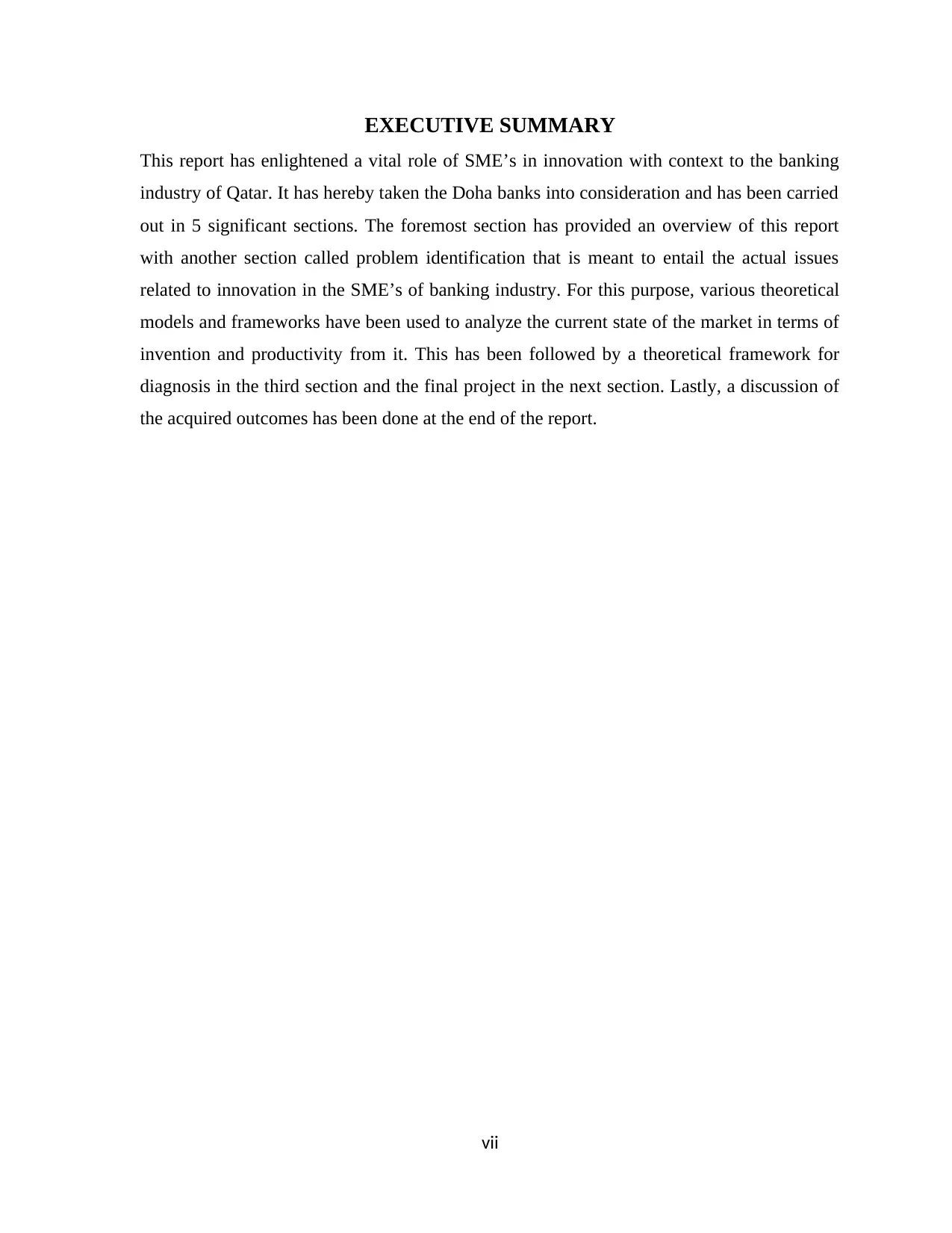
EXECUTIVE SUMMARY
This report has enlightened a vital role of SME’s in innovation with context to the banking
industry of Qatar. It has hereby taken the Doha banks into consideration and has been carried
out in 5 significant sections. The foremost section has provided an overview of this report
with another section called problem identification that is meant to entail the actual issues
related to innovation in the SME’s of banking industry. For this purpose, various theoretical
models and frameworks have been used to analyze the current state of the market in terms of
invention and productivity from it. This has been followed by a theoretical framework for
diagnosis in the third section and the final project in the next section. Lastly, a discussion of
the acquired outcomes has been done at the end of the report.
vii
This report has enlightened a vital role of SME’s in innovation with context to the banking
industry of Qatar. It has hereby taken the Doha banks into consideration and has been carried
out in 5 significant sections. The foremost section has provided an overview of this report
with another section called problem identification that is meant to entail the actual issues
related to innovation in the SME’s of banking industry. For this purpose, various theoretical
models and frameworks have been used to analyze the current state of the market in terms of
invention and productivity from it. This has been followed by a theoretical framework for
diagnosis in the third section and the final project in the next section. Lastly, a discussion of
the acquired outcomes has been done at the end of the report.
vii
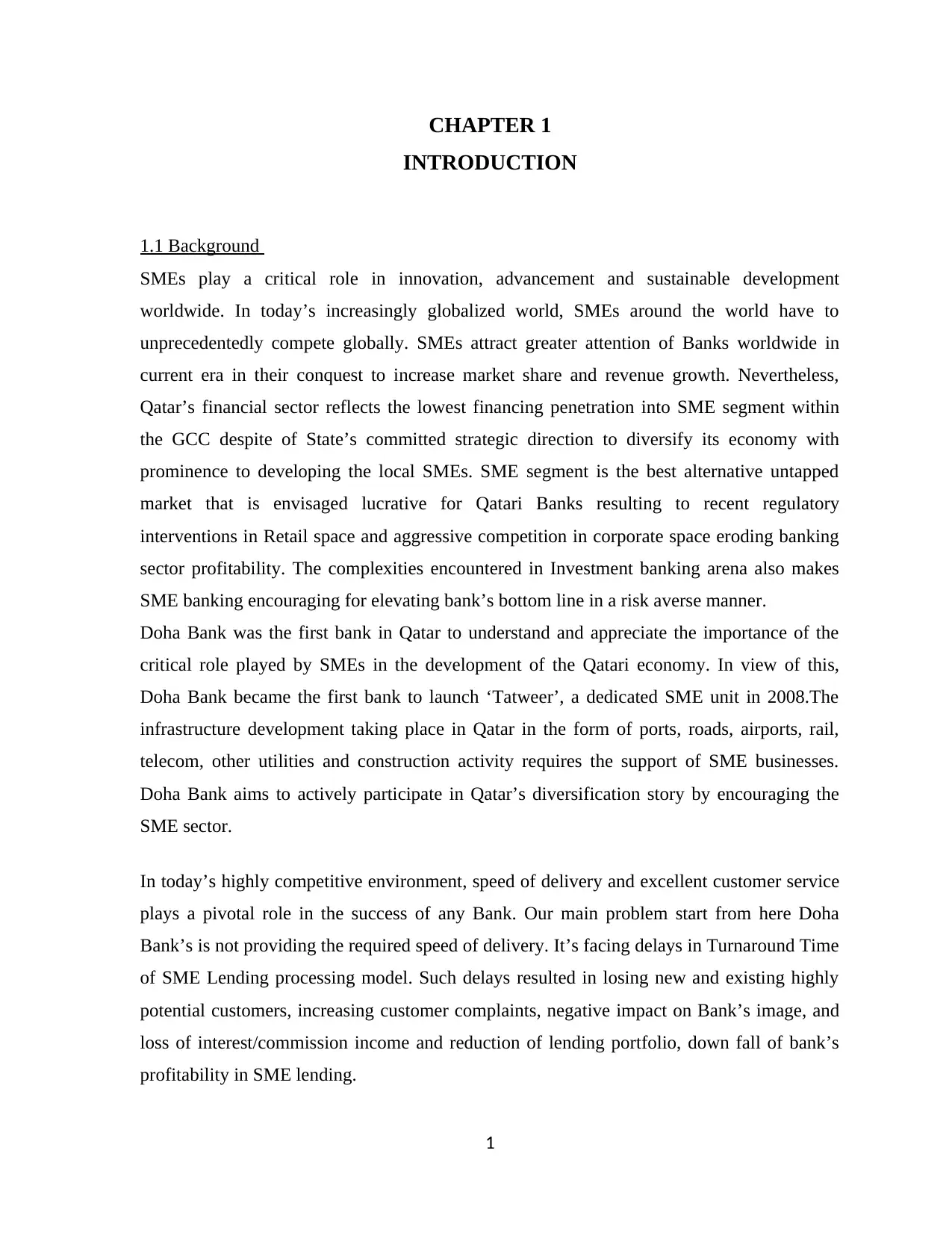
CHAPTER 1
INTRODUCTION
1.1 Background
SMEs play a critical role in innovation, advancement and sustainable development
worldwide. In today’s increasingly globalized world, SMEs around the world have to
unprecedentedly compete globally. SMEs attract greater attention of Banks worldwide in
current era in their conquest to increase market share and revenue growth. Nevertheless,
Qatar’s financial sector reflects the lowest financing penetration into SME segment within
the GCC despite of State’s committed strategic direction to diversify its economy with
prominence to developing the local SMEs. SME segment is the best alternative untapped
market that is envisaged lucrative for Qatari Banks resulting to recent regulatory
interventions in Retail space and aggressive competition in corporate space eroding banking
sector profitability. The complexities encountered in Investment banking arena also makes
SME banking encouraging for elevating bank’s bottom line in a risk averse manner.
Doha Bank was the first bank in Qatar to understand and appreciate the importance of the
critical role played by SMEs in the development of the Qatari economy. In view of this,
Doha Bank became the first bank to launch ‘Tatweer’, a dedicated SME unit in 2008.The
infrastructure development taking place in Qatar in the form of ports, roads, airports, rail,
telecom, other utilities and construction activity requires the support of SME businesses.
Doha Bank aims to actively participate in Qatar’s diversification story by encouraging the
SME sector.
In today’s highly competitive environment, speed of delivery and excellent customer service
plays a pivotal role in the success of any Bank. Our main problem start from here Doha
Bank’s is not providing the required speed of delivery. It’s facing delays in Turnaround Time
of SME Lending processing model. Such delays resulted in losing new and existing highly
potential customers, increasing customer complaints, negative impact on Bank’s image, and
loss of interest/commission income and reduction of lending portfolio, down fall of bank’s
profitability in SME lending.
1
INTRODUCTION
1.1 Background
SMEs play a critical role in innovation, advancement and sustainable development
worldwide. In today’s increasingly globalized world, SMEs around the world have to
unprecedentedly compete globally. SMEs attract greater attention of Banks worldwide in
current era in their conquest to increase market share and revenue growth. Nevertheless,
Qatar’s financial sector reflects the lowest financing penetration into SME segment within
the GCC despite of State’s committed strategic direction to diversify its economy with
prominence to developing the local SMEs. SME segment is the best alternative untapped
market that is envisaged lucrative for Qatari Banks resulting to recent regulatory
interventions in Retail space and aggressive competition in corporate space eroding banking
sector profitability. The complexities encountered in Investment banking arena also makes
SME banking encouraging for elevating bank’s bottom line in a risk averse manner.
Doha Bank was the first bank in Qatar to understand and appreciate the importance of the
critical role played by SMEs in the development of the Qatari economy. In view of this,
Doha Bank became the first bank to launch ‘Tatweer’, a dedicated SME unit in 2008.The
infrastructure development taking place in Qatar in the form of ports, roads, airports, rail,
telecom, other utilities and construction activity requires the support of SME businesses.
Doha Bank aims to actively participate in Qatar’s diversification story by encouraging the
SME sector.
In today’s highly competitive environment, speed of delivery and excellent customer service
plays a pivotal role in the success of any Bank. Our main problem start from here Doha
Bank’s is not providing the required speed of delivery. It’s facing delays in Turnaround Time
of SME Lending processing model. Such delays resulted in losing new and existing highly
potential customers, increasing customer complaints, negative impact on Bank’s image, and
loss of interest/commission income and reduction of lending portfolio, down fall of bank’s
profitability in SME lending.
1
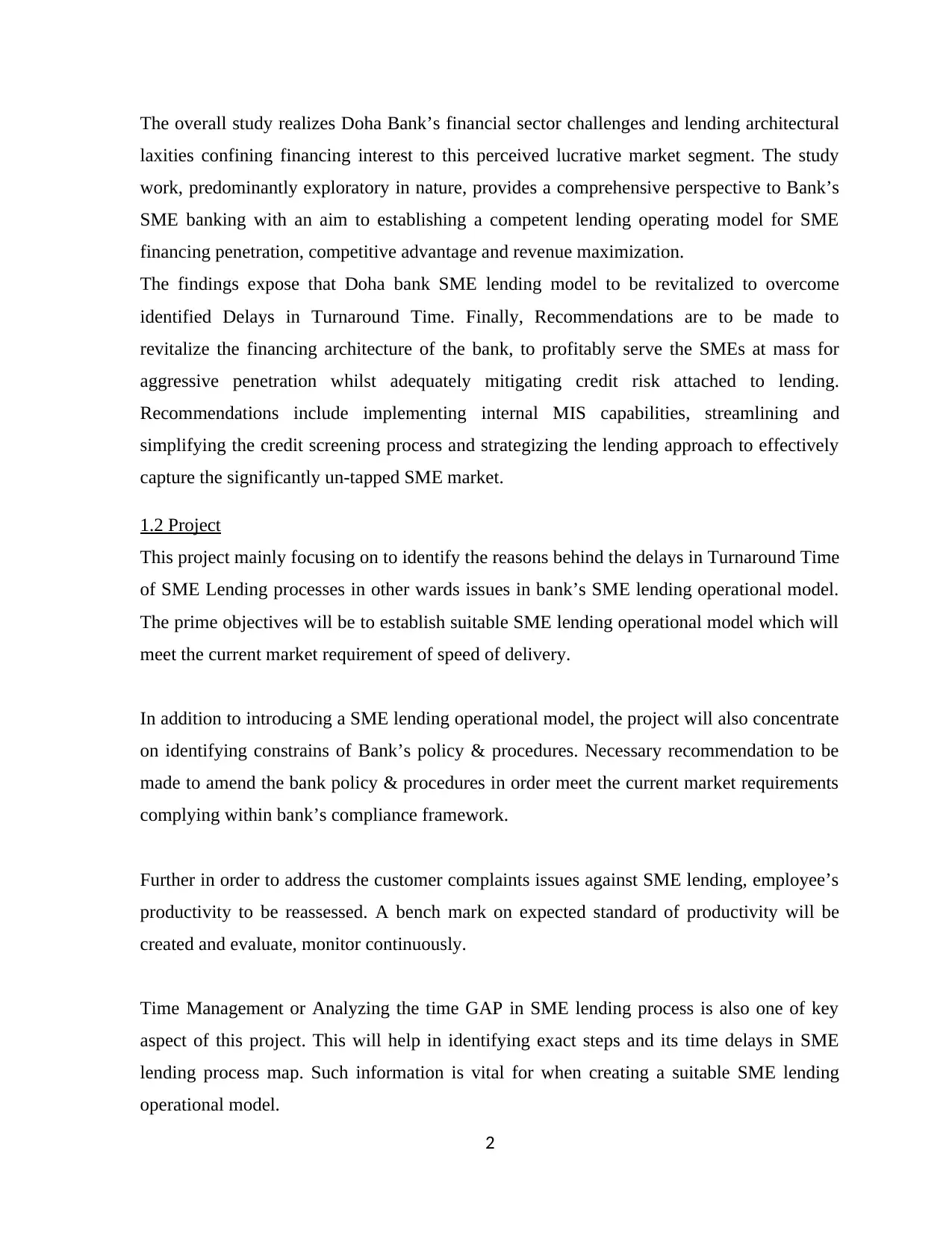
The overall study realizes Doha Bank’s financial sector challenges and lending architectural
laxities confining financing interest to this perceived lucrative market segment. The study
work, predominantly exploratory in nature, provides a comprehensive perspective to Bank’s
SME banking with an aim to establishing a competent lending operating model for SME
financing penetration, competitive advantage and revenue maximization.
The findings expose that Doha bank SME lending model to be revitalized to overcome
identified Delays in Turnaround Time. Finally, Recommendations are to be made to
revitalize the financing architecture of the bank, to profitably serve the SMEs at mass for
aggressive penetration whilst adequately mitigating credit risk attached to lending.
Recommendations include implementing internal MIS capabilities, streamlining and
simplifying the credit screening process and strategizing the lending approach to effectively
capture the significantly un-tapped SME market.
1.2 Project
This project mainly focusing on to identify the reasons behind the delays in Turnaround Time
of SME Lending processes in other wards issues in bank’s SME lending operational model.
The prime objectives will be to establish suitable SME lending operational model which will
meet the current market requirement of speed of delivery.
In addition to introducing a SME lending operational model, the project will also concentrate
on identifying constrains of Bank’s policy & procedures. Necessary recommendation to be
made to amend the bank policy & procedures in order meet the current market requirements
complying within bank’s compliance framework.
Further in order to address the customer complaints issues against SME lending, employee’s
productivity to be reassessed. A bench mark on expected standard of productivity will be
created and evaluate, monitor continuously.
Time Management or Analyzing the time GAP in SME lending process is also one of key
aspect of this project. This will help in identifying exact steps and its time delays in SME
lending process map. Such information is vital for when creating a suitable SME lending
operational model.
2
laxities confining financing interest to this perceived lucrative market segment. The study
work, predominantly exploratory in nature, provides a comprehensive perspective to Bank’s
SME banking with an aim to establishing a competent lending operating model for SME
financing penetration, competitive advantage and revenue maximization.
The findings expose that Doha bank SME lending model to be revitalized to overcome
identified Delays in Turnaround Time. Finally, Recommendations are to be made to
revitalize the financing architecture of the bank, to profitably serve the SMEs at mass for
aggressive penetration whilst adequately mitigating credit risk attached to lending.
Recommendations include implementing internal MIS capabilities, streamlining and
simplifying the credit screening process and strategizing the lending approach to effectively
capture the significantly un-tapped SME market.
1.2 Project
This project mainly focusing on to identify the reasons behind the delays in Turnaround Time
of SME Lending processes in other wards issues in bank’s SME lending operational model.
The prime objectives will be to establish suitable SME lending operational model which will
meet the current market requirement of speed of delivery.
In addition to introducing a SME lending operational model, the project will also concentrate
on identifying constrains of Bank’s policy & procedures. Necessary recommendation to be
made to amend the bank policy & procedures in order meet the current market requirements
complying within bank’s compliance framework.
Further in order to address the customer complaints issues against SME lending, employee’s
productivity to be reassessed. A bench mark on expected standard of productivity will be
created and evaluate, monitor continuously.
Time Management or Analyzing the time GAP in SME lending process is also one of key
aspect of this project. This will help in identifying exact steps and its time delays in SME
lending process map. Such information is vital for when creating a suitable SME lending
operational model.
2
Secure Best Marks with AI Grader
Need help grading? Try our AI Grader for instant feedback on your assignments.
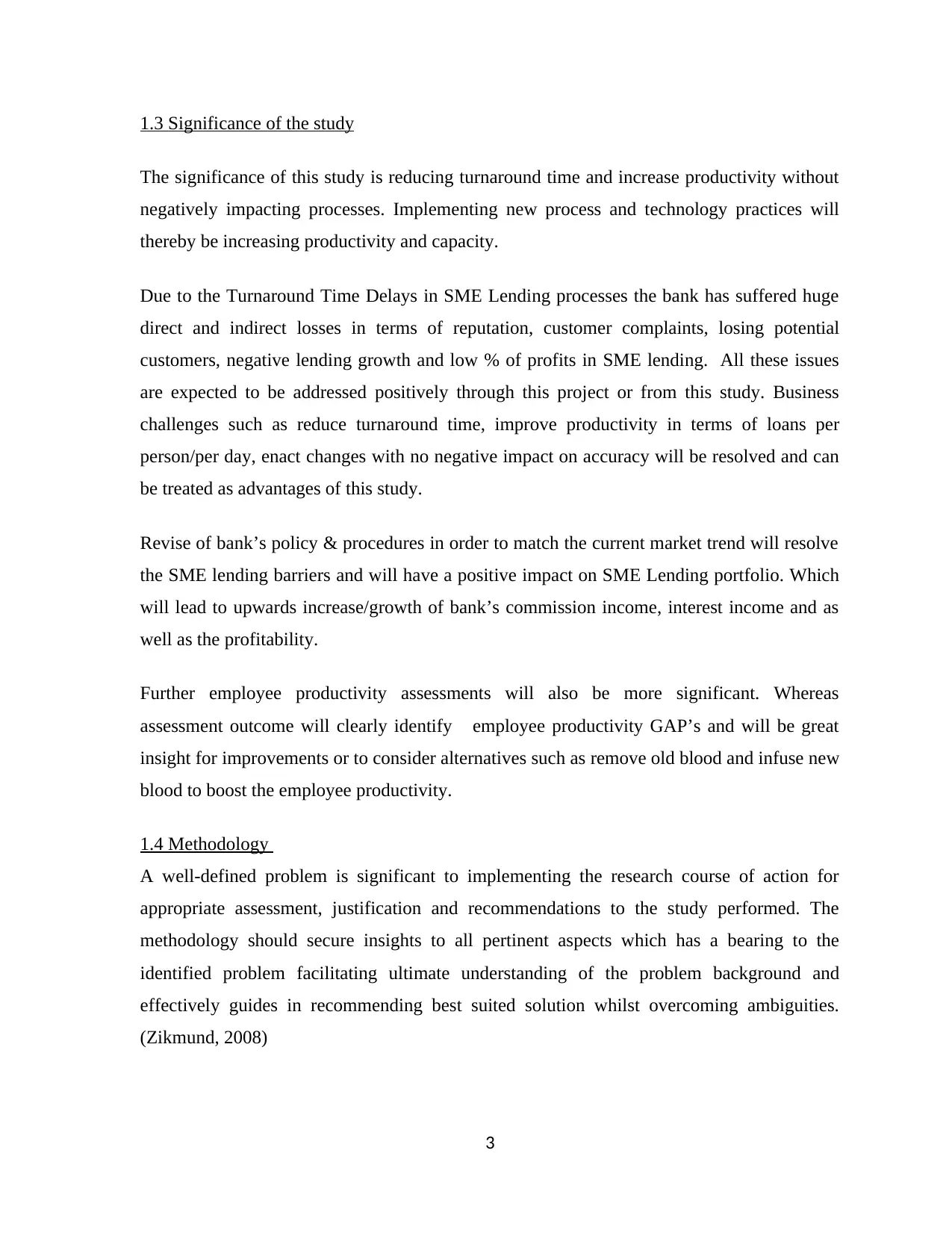
1.3 Significance of the study
The significance of this study is reducing turnaround time and increase productivity without
negatively impacting processes. Implementing new process and technology practices will
thereby be increasing productivity and capacity.
Due to the Turnaround Time Delays in SME Lending processes the bank has suffered huge
direct and indirect losses in terms of reputation, customer complaints, losing potential
customers, negative lending growth and low % of profits in SME lending. All these issues
are expected to be addressed positively through this project or from this study. Business
challenges such as reduce turnaround time, improve productivity in terms of loans per
person/per day, enact changes with no negative impact on accuracy will be resolved and can
be treated as advantages of this study.
Revise of bank’s policy & procedures in order to match the current market trend will resolve
the SME lending barriers and will have a positive impact on SME Lending portfolio. Which
will lead to upwards increase/growth of bank’s commission income, interest income and as
well as the profitability.
Further employee productivity assessments will also be more significant. Whereas
assessment outcome will clearly identify employee productivity GAP’s and will be great
insight for improvements or to consider alternatives such as remove old blood and infuse new
blood to boost the employee productivity.
1.4 Methodology
A well-defined problem is significant to implementing the research course of action for
appropriate assessment, justification and recommendations to the study performed. The
methodology should secure insights to all pertinent aspects which has a bearing to the
identified problem facilitating ultimate understanding of the problem background and
effectively guides in recommending best suited solution whilst overcoming ambiguities.
(Zikmund, 2008)
3
The significance of this study is reducing turnaround time and increase productivity without
negatively impacting processes. Implementing new process and technology practices will
thereby be increasing productivity and capacity.
Due to the Turnaround Time Delays in SME Lending processes the bank has suffered huge
direct and indirect losses in terms of reputation, customer complaints, losing potential
customers, negative lending growth and low % of profits in SME lending. All these issues
are expected to be addressed positively through this project or from this study. Business
challenges such as reduce turnaround time, improve productivity in terms of loans per
person/per day, enact changes with no negative impact on accuracy will be resolved and can
be treated as advantages of this study.
Revise of bank’s policy & procedures in order to match the current market trend will resolve
the SME lending barriers and will have a positive impact on SME Lending portfolio. Which
will lead to upwards increase/growth of bank’s commission income, interest income and as
well as the profitability.
Further employee productivity assessments will also be more significant. Whereas
assessment outcome will clearly identify employee productivity GAP’s and will be great
insight for improvements or to consider alternatives such as remove old blood and infuse new
blood to boost the employee productivity.
1.4 Methodology
A well-defined problem is significant to implementing the research course of action for
appropriate assessment, justification and recommendations to the study performed. The
methodology should secure insights to all pertinent aspects which has a bearing to the
identified problem facilitating ultimate understanding of the problem background and
effectively guides in recommending best suited solution whilst overcoming ambiguities.
(Zikmund, 2008)
3
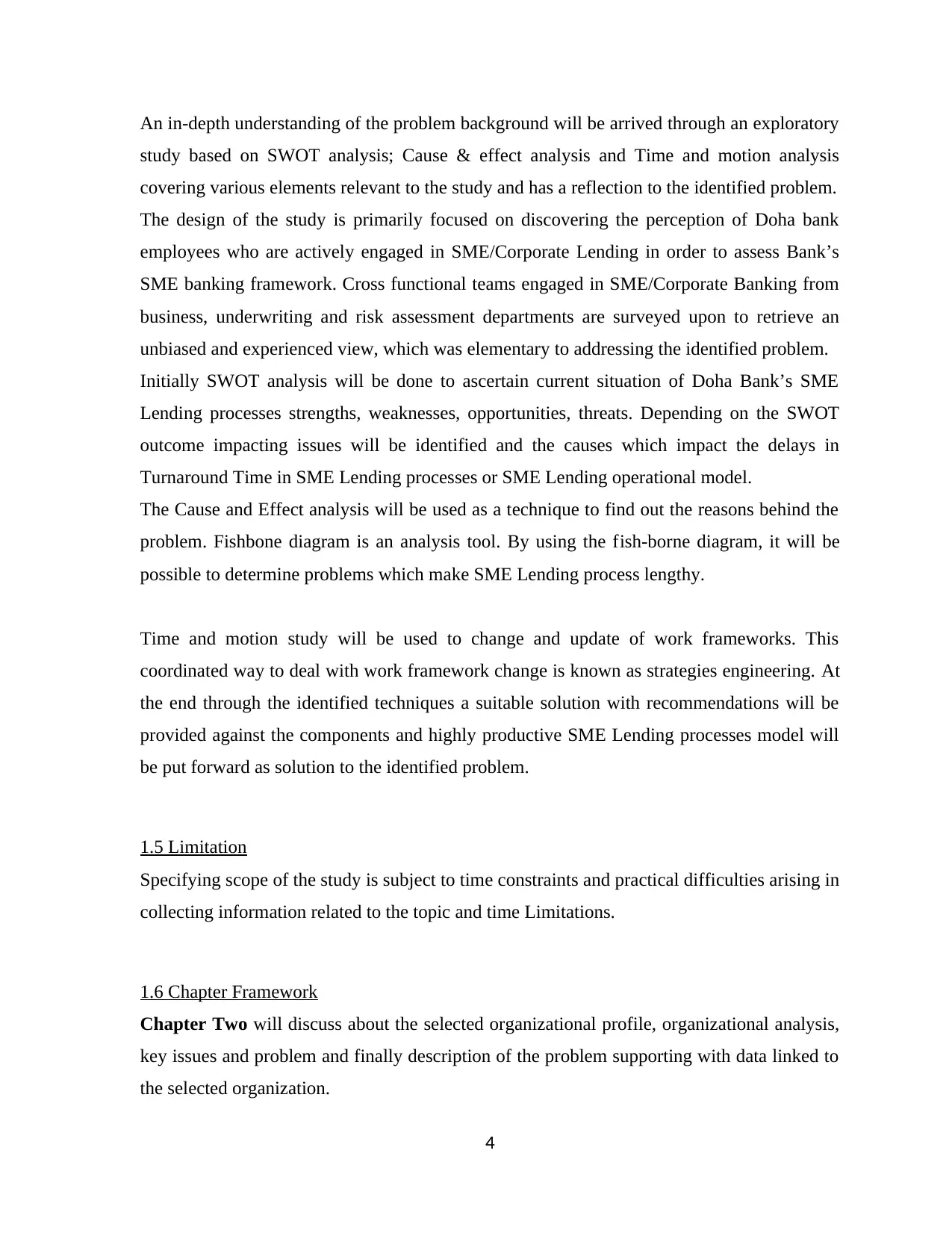
An in-depth understanding of the problem background will be arrived through an exploratory
study based on SWOT analysis; Cause & effect analysis and Time and motion analysis
covering various elements relevant to the study and has a reflection to the identified problem.
The design of the study is primarily focused on discovering the perception of Doha bank
employees who are actively engaged in SME/Corporate Lending in order to assess Bank’s
SME banking framework. Cross functional teams engaged in SME/Corporate Banking from
business, underwriting and risk assessment departments are surveyed upon to retrieve an
unbiased and experienced view, which was elementary to addressing the identified problem.
Initially SWOT analysis will be done to ascertain current situation of Doha Bank’s SME
Lending processes strengths, weaknesses, opportunities, threats. Depending on the SWOT
outcome impacting issues will be identified and the causes which impact the delays in
Turnaround Time in SME Lending processes or SME Lending operational model.
The Cause and Effect analysis will be used as a technique to find out the reasons behind the
problem. Fishbone diagram is an analysis tool. By using the fish-borne diagram, it will be
possible to determine problems which make SME Lending process lengthy.
Time and motion study will be used to change and update of work frameworks. This
coordinated way to deal with work framework change is known as strategies engineering. At
the end through the identified techniques a suitable solution with recommendations will be
provided against the components and highly productive SME Lending processes model will
be put forward as solution to the identified problem.
1.5 Limitation
Specifying scope of the study is subject to time constraints and practical difficulties arising in
collecting information related to the topic and time Limitations.
1.6 Chapter Framework
Chapter Two will discuss about the selected organizational profile, organizational analysis,
key issues and problem and finally description of the problem supporting with data linked to
the selected organization.
4
study based on SWOT analysis; Cause & effect analysis and Time and motion analysis
covering various elements relevant to the study and has a reflection to the identified problem.
The design of the study is primarily focused on discovering the perception of Doha bank
employees who are actively engaged in SME/Corporate Lending in order to assess Bank’s
SME banking framework. Cross functional teams engaged in SME/Corporate Banking from
business, underwriting and risk assessment departments are surveyed upon to retrieve an
unbiased and experienced view, which was elementary to addressing the identified problem.
Initially SWOT analysis will be done to ascertain current situation of Doha Bank’s SME
Lending processes strengths, weaknesses, opportunities, threats. Depending on the SWOT
outcome impacting issues will be identified and the causes which impact the delays in
Turnaround Time in SME Lending processes or SME Lending operational model.
The Cause and Effect analysis will be used as a technique to find out the reasons behind the
problem. Fishbone diagram is an analysis tool. By using the fish-borne diagram, it will be
possible to determine problems which make SME Lending process lengthy.
Time and motion study will be used to change and update of work frameworks. This
coordinated way to deal with work framework change is known as strategies engineering. At
the end through the identified techniques a suitable solution with recommendations will be
provided against the components and highly productive SME Lending processes model will
be put forward as solution to the identified problem.
1.5 Limitation
Specifying scope of the study is subject to time constraints and practical difficulties arising in
collecting information related to the topic and time Limitations.
1.6 Chapter Framework
Chapter Two will discuss about the selected organizational profile, organizational analysis,
key issues and problem and finally description of the problem supporting with data linked to
the selected organization.
4
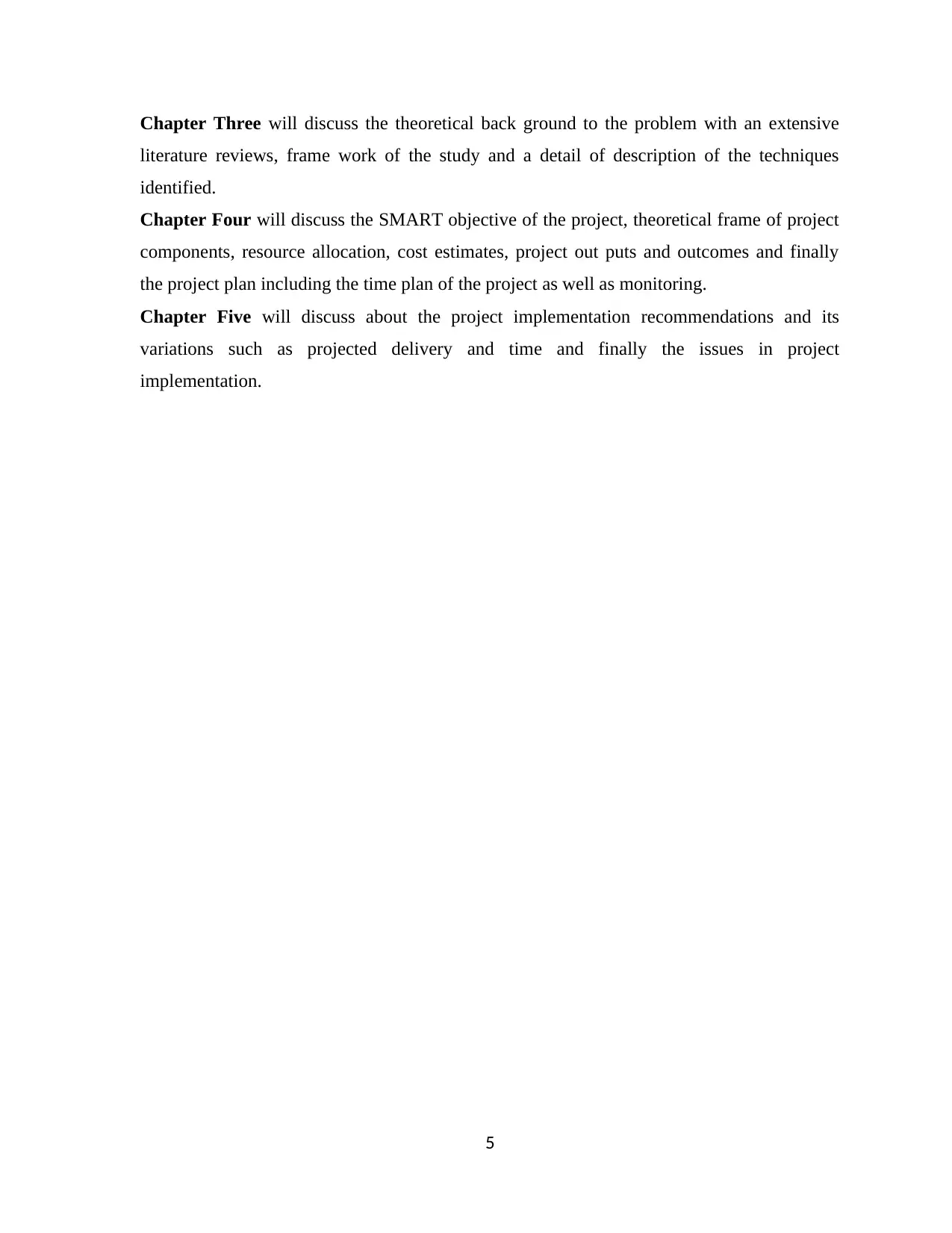
Chapter Three will discuss the theoretical back ground to the problem with an extensive
literature reviews, frame work of the study and a detail of description of the techniques
identified.
Chapter Four will discuss the SMART objective of the project, theoretical frame of project
components, resource allocation, cost estimates, project out puts and outcomes and finally
the project plan including the time plan of the project as well as monitoring.
Chapter Five will discuss about the project implementation recommendations and its
variations such as projected delivery and time and finally the issues in project
implementation.
5
literature reviews, frame work of the study and a detail of description of the techniques
identified.
Chapter Four will discuss the SMART objective of the project, theoretical frame of project
components, resource allocation, cost estimates, project out puts and outcomes and finally
the project plan including the time plan of the project as well as monitoring.
Chapter Five will discuss about the project implementation recommendations and its
variations such as projected delivery and time and finally the issues in project
implementation.
5
Paraphrase This Document
Need a fresh take? Get an instant paraphrase of this document with our AI Paraphraser
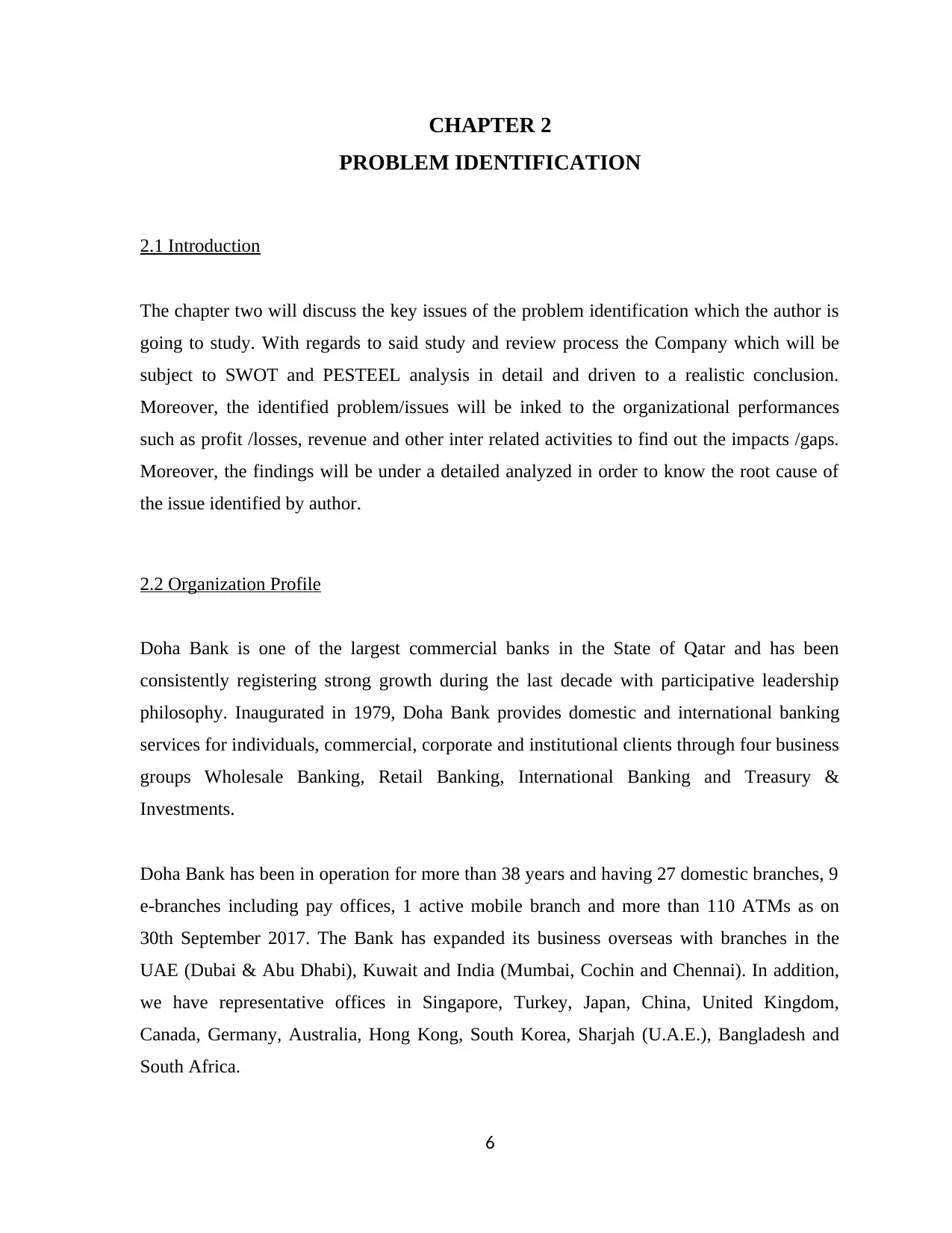
CHAPTER 2
PROBLEM IDENTIFICATION
2.1 Introduction
The chapter two will discuss the key issues of the problem identification which the author is
going to study. With regards to said study and review process the Company which will be
subject to SWOT and PESTEEL analysis in detail and driven to a realistic conclusion.
Moreover, the identified problem/issues will be inked to the organizational performances
such as profit /losses, revenue and other inter related activities to find out the impacts /gaps.
Moreover, the findings will be under a detailed analyzed in order to know the root cause of
the issue identified by author.
2.2 Organization Profile
Doha Bank is one of the largest commercial banks in the State of Qatar and has been
consistently registering strong growth during the last decade with participative leadership
philosophy. Inaugurated in 1979, Doha Bank provides domestic and international banking
services for individuals, commercial, corporate and institutional clients through four business
groups Wholesale Banking, Retail Banking, International Banking and Treasury &
Investments.
Doha Bank has been in operation for more than 38 years and having 27 domestic branches, 9
e-branches including pay offices, 1 active mobile branch and more than 110 ATMs as on
30th September 2017. The Bank has expanded its business overseas with branches in the
UAE (Dubai & Abu Dhabi), Kuwait and India (Mumbai, Cochin and Chennai). In addition,
we have representative offices in Singapore, Turkey, Japan, China, United Kingdom,
Canada, Germany, Australia, Hong Kong, South Korea, Sharjah (U.A.E.), Bangladesh and
South Africa.
6
PROBLEM IDENTIFICATION
2.1 Introduction
The chapter two will discuss the key issues of the problem identification which the author is
going to study. With regards to said study and review process the Company which will be
subject to SWOT and PESTEEL analysis in detail and driven to a realistic conclusion.
Moreover, the identified problem/issues will be inked to the organizational performances
such as profit /losses, revenue and other inter related activities to find out the impacts /gaps.
Moreover, the findings will be under a detailed analyzed in order to know the root cause of
the issue identified by author.
2.2 Organization Profile
Doha Bank is one of the largest commercial banks in the State of Qatar and has been
consistently registering strong growth during the last decade with participative leadership
philosophy. Inaugurated in 1979, Doha Bank provides domestic and international banking
services for individuals, commercial, corporate and institutional clients through four business
groups Wholesale Banking, Retail Banking, International Banking and Treasury &
Investments.
Doha Bank has been in operation for more than 38 years and having 27 domestic branches, 9
e-branches including pay offices, 1 active mobile branch and more than 110 ATMs as on
30th September 2017. The Bank has expanded its business overseas with branches in the
UAE (Dubai & Abu Dhabi), Kuwait and India (Mumbai, Cochin and Chennai). In addition,
we have representative offices in Singapore, Turkey, Japan, China, United Kingdom,
Canada, Germany, Australia, Hong Kong, South Korea, Sharjah (U.A.E.), Bangladesh and
South Africa.
6

Doha Bank has received numerous awards in recognition of its achievements. Doha Bank
was adjudged as the ‘Best Regional Commercial Bank’ – The Banker Middle East for the 5th
straight year. Doha Bank was recently awarded as ‘Bank of the Year – Qatar Domestic Trade
Finance’ by Asian Banking & Finance. Additionally, Doha Bank has in the past claimed
various other awards such as, ‘Bank of the Year’ – The Banker, ‘Best Commercial Bank in
the Middle East’ – Global Banking & Finance, ‘Bank of the Year’ – ITP Group, ‘Best Bank
in Qatar’ – IAIR Award and ‘Best Bank in Qatar’ – EMEA Finance.
In recognition of being one of the most active advocates of Corporate Social Responsibility
(CSR) through initiatives such as ‘ECO-School Program ‘Al Dana Green Run’, beach
cleaning, tree planting etc., Doha Bank has won the ‘Environmental Award’ from The Arab
Organization for Social Responsibility as well as ‘Golden Peacock – Global Award for
Sustainability’ from the Institute of Directors. Doha Bank is rated A by Fitch, A2 by
Moody’s and A- by Standard & Poor’s for its long-term local and foreign currency.
The Bank’s sustainability in terms of financial performance is well proven in past results
which have evidenced strong year on year growth of the balance sheet and profit & loss
account. Such performance, of course, relies heavily on all of Doha Bank’s sustainability
measures in creating long term opportunity for all stakeholders whilst delivering superior
returns to shareholders. Table 2.1 provides the financial highlights and Table 2.2 gives ratio
analysis of Doha Bank.
Table 2. 1: Financial Highlights
Key Figures 2015 (QAR Mn) 2016 (QAR Mn) 2017 (QAR Mn)
Total Assets 83,289 90,365 93,495
Net Loans & Advances 55,595 59,186 59,804
Customer Deposits 52,767 55,730 59,468
Total Equity 13,187 13,381 14,807
Net Profit 1,354 1,054 1,110
Source: Doha Bank Sustainability Report 2017
7
was adjudged as the ‘Best Regional Commercial Bank’ – The Banker Middle East for the 5th
straight year. Doha Bank was recently awarded as ‘Bank of the Year – Qatar Domestic Trade
Finance’ by Asian Banking & Finance. Additionally, Doha Bank has in the past claimed
various other awards such as, ‘Bank of the Year’ – The Banker, ‘Best Commercial Bank in
the Middle East’ – Global Banking & Finance, ‘Bank of the Year’ – ITP Group, ‘Best Bank
in Qatar’ – IAIR Award and ‘Best Bank in Qatar’ – EMEA Finance.
In recognition of being one of the most active advocates of Corporate Social Responsibility
(CSR) through initiatives such as ‘ECO-School Program ‘Al Dana Green Run’, beach
cleaning, tree planting etc., Doha Bank has won the ‘Environmental Award’ from The Arab
Organization for Social Responsibility as well as ‘Golden Peacock – Global Award for
Sustainability’ from the Institute of Directors. Doha Bank is rated A by Fitch, A2 by
Moody’s and A- by Standard & Poor’s for its long-term local and foreign currency.
The Bank’s sustainability in terms of financial performance is well proven in past results
which have evidenced strong year on year growth of the balance sheet and profit & loss
account. Such performance, of course, relies heavily on all of Doha Bank’s sustainability
measures in creating long term opportunity for all stakeholders whilst delivering superior
returns to shareholders. Table 2.1 provides the financial highlights and Table 2.2 gives ratio
analysis of Doha Bank.
Table 2. 1: Financial Highlights
Key Figures 2015 (QAR Mn) 2016 (QAR Mn) 2017 (QAR Mn)
Total Assets 83,289 90,365 93,495
Net Loans & Advances 55,595 59,186 59,804
Customer Deposits 52,767 55,730 59,468
Total Equity 13,187 13,381 14,807
Net Profit 1,354 1,054 1,110
Source: Doha Bank Sustainability Report 2017
7
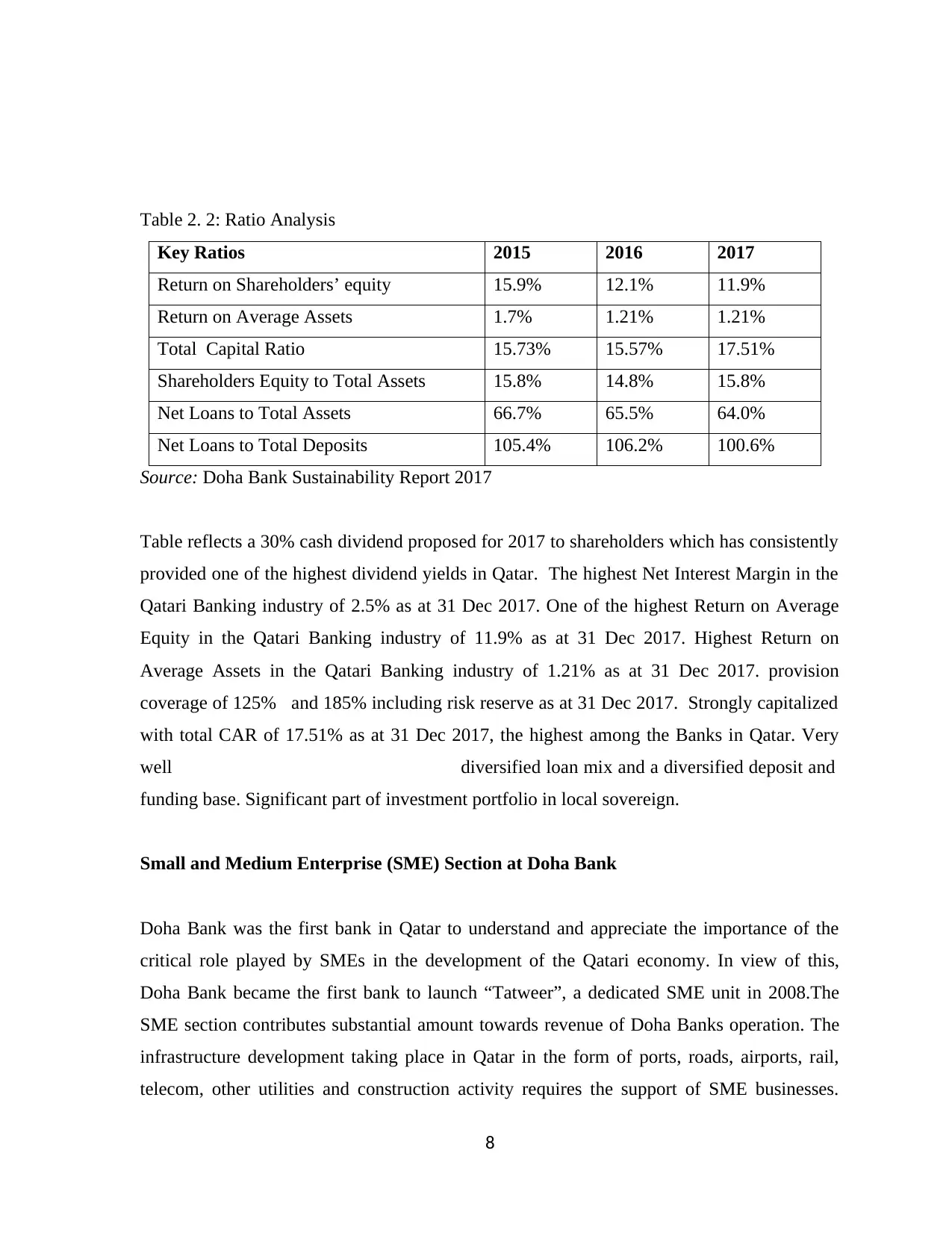
Table 2. 2: Ratio Analysis
Key Ratios 2015 2016 2017
Return on Shareholders’ equity 15.9% 12.1% 11.9%
Return on Average Assets 1.7% 1.21% 1.21%
Total Capital Ratio 15.73% 15.57% 17.51%
Shareholders Equity to Total Assets 15.8% 14.8% 15.8%
Net Loans to Total Assets 66.7% 65.5% 64.0%
Net Loans to Total Deposits 105.4% 106.2% 100.6%
Source: Doha Bank Sustainability Report 2017
Table reflects a 30% cash dividend proposed for 2017 to shareholders which has consistently
provided one of the highest dividend yields in Qatar. The highest Net Interest Margin in the
Qatari Banking industry of 2.5% as at 31 Dec 2017. One of the highest Return on Average
Equity in the Qatari Banking industry of 11.9% as at 31 Dec 2017. Highest Return on
Average Assets in the Qatari Banking industry of 1.21% as at 31 Dec 2017. provision
coverage of 125% and 185% including risk reserve as at 31 Dec 2017. Strongly capitalized
with total CAR of 17.51% as at 31 Dec 2017, the highest among the Banks in Qatar. Very
well diversified loan mix and a diversified deposit and
funding base. Significant part of investment portfolio in local sovereign.
Small and Medium Enterprise (SME) Section at Doha Bank
Doha Bank was the first bank in Qatar to understand and appreciate the importance of the
critical role played by SMEs in the development of the Qatari economy. In view of this,
Doha Bank became the first bank to launch “Tatweer”, a dedicated SME unit in 2008.The
SME section contributes substantial amount towards revenue of Doha Banks operation. The
infrastructure development taking place in Qatar in the form of ports, roads, airports, rail,
telecom, other utilities and construction activity requires the support of SME businesses.
8
Key Ratios 2015 2016 2017
Return on Shareholders’ equity 15.9% 12.1% 11.9%
Return on Average Assets 1.7% 1.21% 1.21%
Total Capital Ratio 15.73% 15.57% 17.51%
Shareholders Equity to Total Assets 15.8% 14.8% 15.8%
Net Loans to Total Assets 66.7% 65.5% 64.0%
Net Loans to Total Deposits 105.4% 106.2% 100.6%
Source: Doha Bank Sustainability Report 2017
Table reflects a 30% cash dividend proposed for 2017 to shareholders which has consistently
provided one of the highest dividend yields in Qatar. The highest Net Interest Margin in the
Qatari Banking industry of 2.5% as at 31 Dec 2017. One of the highest Return on Average
Equity in the Qatari Banking industry of 11.9% as at 31 Dec 2017. Highest Return on
Average Assets in the Qatari Banking industry of 1.21% as at 31 Dec 2017. provision
coverage of 125% and 185% including risk reserve as at 31 Dec 2017. Strongly capitalized
with total CAR of 17.51% as at 31 Dec 2017, the highest among the Banks in Qatar. Very
well diversified loan mix and a diversified deposit and
funding base. Significant part of investment portfolio in local sovereign.
Small and Medium Enterprise (SME) Section at Doha Bank
Doha Bank was the first bank in Qatar to understand and appreciate the importance of the
critical role played by SMEs in the development of the Qatari economy. In view of this,
Doha Bank became the first bank to launch “Tatweer”, a dedicated SME unit in 2008.The
SME section contributes substantial amount towards revenue of Doha Banks operation. The
infrastructure development taking place in Qatar in the form of ports, roads, airports, rail,
telecom, other utilities and construction activity requires the support of SME businesses.
8
Secure Best Marks with AI Grader
Need help grading? Try our AI Grader for instant feedback on your assignments.

Doha Bank aims to actively participate in Qatar’s diversification story by encouraging the
SME sector.
Doha Bank has already assisted over 500 SME customers with credit lines more than QAR
1.5 billion to date. Doha Bank firmly believes that today’s SMEs are the emerging large-cap
companies and already have several success stories to boast of. The success stories created
by Doha Bank have encouraged other SME customers to approach Doha Bank for various
financing solutions.
Despite new entrants in the market and stiff competition from local and international players,
Doha Bank continues to be the Banker of First choice for SME customers. These customers
hold Doha Bank in high esteem which speaks volume of their satisfaction levels as the
complete range of products and services are available under one roof along with a team of
dedicated Relationship Managers and Credit & Risk Management team.
2.3 Organizational Analysis: SME Section at Doha Bank
2.3.1 SWOT Analysis: SME Lending at Doha Bank
Small and Medium Enterprise (SME) lending is Author’s focus of study, Table 2.3 shows
SWOT analysis restrict to the Bank’s Small and Medium Enterprise Unit.
Table 2. 3 SWOT Analysis
Strengths First Private Bank to Introduce SME banking
Broad range of Product offerings
Dedicated Relationship Managers
Largest Branch Network country wide
One of the biggest Lender in Qatar by market value
Already served more than 1000 SME customers
Awarded the Golden Peacock Global Award for Sustainability
9
SME sector.
Doha Bank has already assisted over 500 SME customers with credit lines more than QAR
1.5 billion to date. Doha Bank firmly believes that today’s SMEs are the emerging large-cap
companies and already have several success stories to boast of. The success stories created
by Doha Bank have encouraged other SME customers to approach Doha Bank for various
financing solutions.
Despite new entrants in the market and stiff competition from local and international players,
Doha Bank continues to be the Banker of First choice for SME customers. These customers
hold Doha Bank in high esteem which speaks volume of their satisfaction levels as the
complete range of products and services are available under one roof along with a team of
dedicated Relationship Managers and Credit & Risk Management team.
2.3 Organizational Analysis: SME Section at Doha Bank
2.3.1 SWOT Analysis: SME Lending at Doha Bank
Small and Medium Enterprise (SME) lending is Author’s focus of study, Table 2.3 shows
SWOT analysis restrict to the Bank’s Small and Medium Enterprise Unit.
Table 2. 3 SWOT Analysis
Strengths First Private Bank to Introduce SME banking
Broad range of Product offerings
Dedicated Relationship Managers
Largest Branch Network country wide
One of the biggest Lender in Qatar by market value
Already served more than 1000 SME customers
Awarded the Golden Peacock Global Award for Sustainability
9
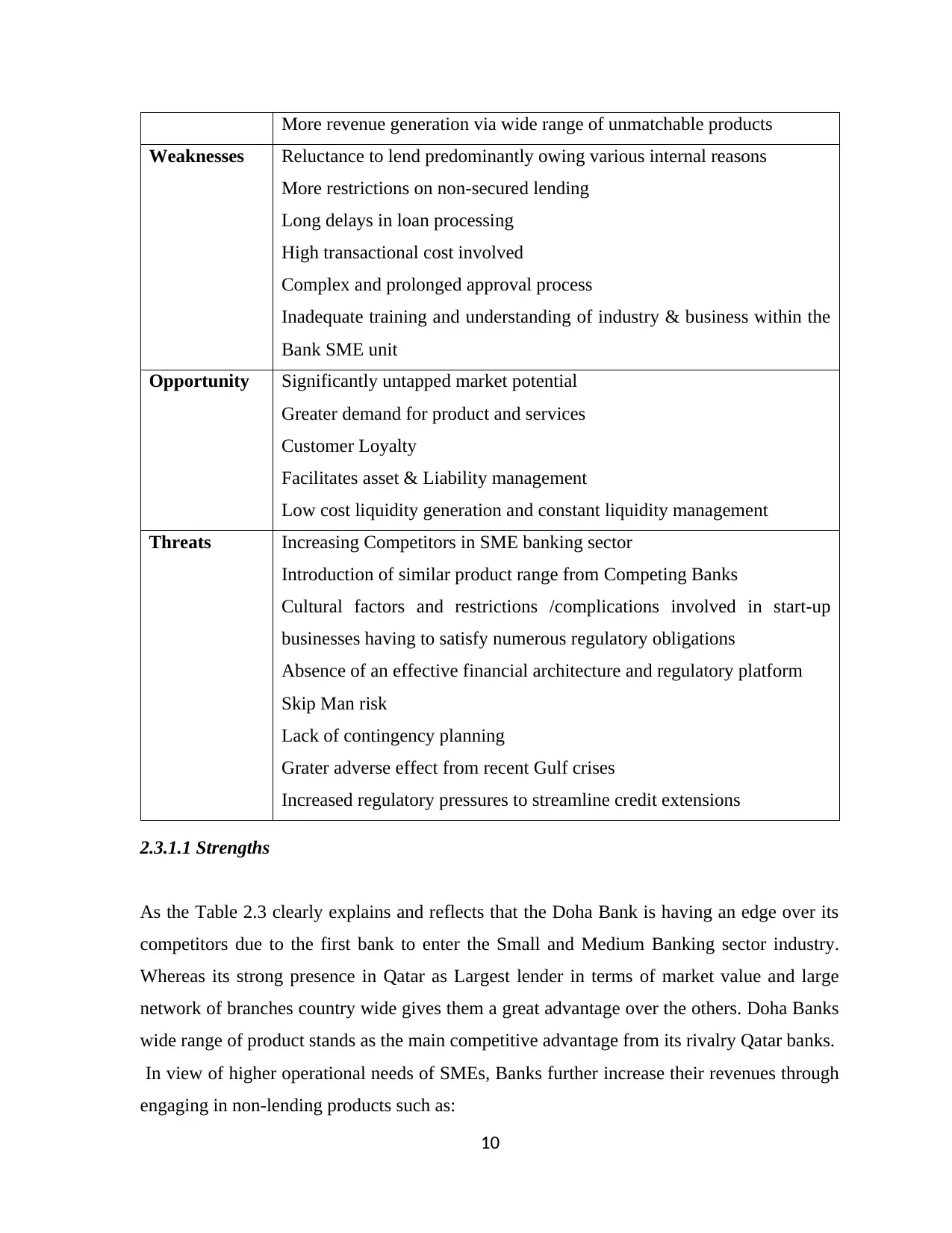
More revenue generation via wide range of unmatchable products
Weaknesses Reluctance to lend predominantly owing various internal reasons
More restrictions on non-secured lending
Long delays in loan processing
High transactional cost involved
Complex and prolonged approval process
Inadequate training and understanding of industry & business within the
Bank SME unit
Opportunity Significantly untapped market potential
Greater demand for product and services
Customer Loyalty
Facilitates asset & Liability management
Low cost liquidity generation and constant liquidity management
Threats Increasing Competitors in SME banking sector
Introduction of similar product range from Competing Banks
Cultural factors and restrictions /complications involved in start-up
businesses having to satisfy numerous regulatory obligations
Absence of an effective financial architecture and regulatory platform
Skip Man risk
Lack of contingency planning
Grater adverse effect from recent Gulf crises
Increased regulatory pressures to streamline credit extensions
2.3.1.1 Strengths
As the Table 2.3 clearly explains and reflects that the Doha Bank is having an edge over its
competitors due to the first bank to enter the Small and Medium Banking sector industry.
Whereas its strong presence in Qatar as Largest lender in terms of market value and large
network of branches country wide gives them a great advantage over the others. Doha Banks
wide range of product stands as the main competitive advantage from its rivalry Qatar banks.
In view of higher operational needs of SMEs, Banks further increase their revenues through
engaging in non-lending products such as:
10
Weaknesses Reluctance to lend predominantly owing various internal reasons
More restrictions on non-secured lending
Long delays in loan processing
High transactional cost involved
Complex and prolonged approval process
Inadequate training and understanding of industry & business within the
Bank SME unit
Opportunity Significantly untapped market potential
Greater demand for product and services
Customer Loyalty
Facilitates asset & Liability management
Low cost liquidity generation and constant liquidity management
Threats Increasing Competitors in SME banking sector
Introduction of similar product range from Competing Banks
Cultural factors and restrictions /complications involved in start-up
businesses having to satisfy numerous regulatory obligations
Absence of an effective financial architecture and regulatory platform
Skip Man risk
Lack of contingency planning
Grater adverse effect from recent Gulf crises
Increased regulatory pressures to streamline credit extensions
2.3.1.1 Strengths
As the Table 2.3 clearly explains and reflects that the Doha Bank is having an edge over its
competitors due to the first bank to enter the Small and Medium Banking sector industry.
Whereas its strong presence in Qatar as Largest lender in terms of market value and large
network of branches country wide gives them a great advantage over the others. Doha Banks
wide range of product stands as the main competitive advantage from its rivalry Qatar banks.
In view of higher operational needs of SMEs, Banks further increase their revenues through
engaging in non-lending products such as:
10
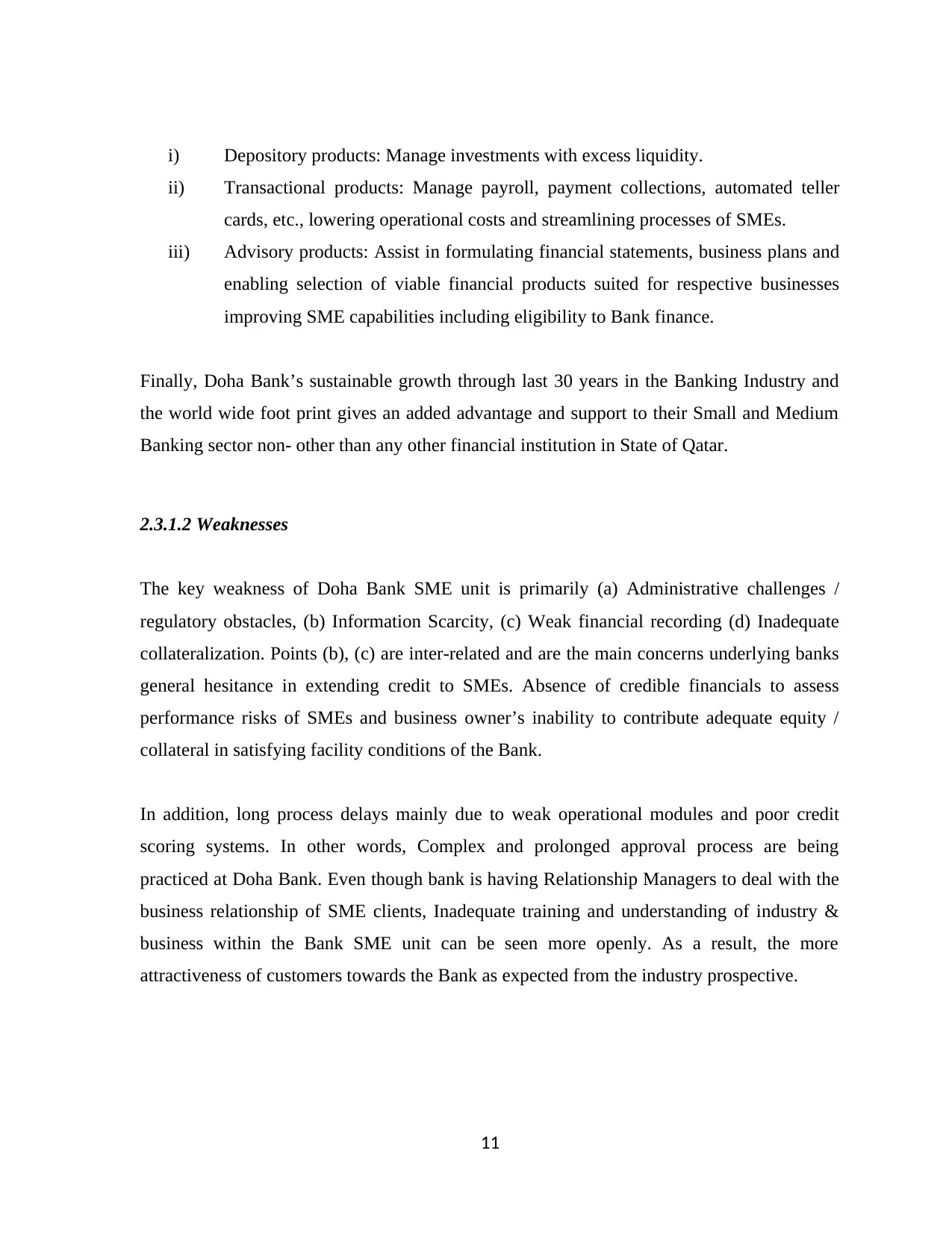
i) Depository products: Manage investments with excess liquidity.
ii) Transactional products: Manage payroll, payment collections, automated teller
cards, etc., lowering operational costs and streamlining processes of SMEs.
iii) Advisory products: Assist in formulating financial statements, business plans and
enabling selection of viable financial products suited for respective businesses
improving SME capabilities including eligibility to Bank finance.
Finally, Doha Bank’s sustainable growth through last 30 years in the Banking Industry and
the world wide foot print gives an added advantage and support to their Small and Medium
Banking sector non- other than any other financial institution in State of Qatar.
2.3.1.2 Weaknesses
The key weakness of Doha Bank SME unit is primarily (a) Administrative challenges /
regulatory obstacles, (b) Information Scarcity, (c) Weak financial recording (d) Inadequate
collateralization. Points (b), (c) are inter-related and are the main concerns underlying banks
general hesitance in extending credit to SMEs. Absence of credible financials to assess
performance risks of SMEs and business owner’s inability to contribute adequate equity /
collateral in satisfying facility conditions of the Bank.
In addition, long process delays mainly due to weak operational modules and poor credit
scoring systems. In other words, Complex and prolonged approval process are being
practiced at Doha Bank. Even though bank is having Relationship Managers to deal with the
business relationship of SME clients, Inadequate training and understanding of industry &
business within the Bank SME unit can be seen more openly. As a result, the more
attractiveness of customers towards the Bank as expected from the industry prospective.
11
ii) Transactional products: Manage payroll, payment collections, automated teller
cards, etc., lowering operational costs and streamlining processes of SMEs.
iii) Advisory products: Assist in formulating financial statements, business plans and
enabling selection of viable financial products suited for respective businesses
improving SME capabilities including eligibility to Bank finance.
Finally, Doha Bank’s sustainable growth through last 30 years in the Banking Industry and
the world wide foot print gives an added advantage and support to their Small and Medium
Banking sector non- other than any other financial institution in State of Qatar.
2.3.1.2 Weaknesses
The key weakness of Doha Bank SME unit is primarily (a) Administrative challenges /
regulatory obstacles, (b) Information Scarcity, (c) Weak financial recording (d) Inadequate
collateralization. Points (b), (c) are inter-related and are the main concerns underlying banks
general hesitance in extending credit to SMEs. Absence of credible financials to assess
performance risks of SMEs and business owner’s inability to contribute adequate equity /
collateral in satisfying facility conditions of the Bank.
In addition, long process delays mainly due to weak operational modules and poor credit
scoring systems. In other words, Complex and prolonged approval process are being
practiced at Doha Bank. Even though bank is having Relationship Managers to deal with the
business relationship of SME clients, Inadequate training and understanding of industry &
business within the Bank SME unit can be seen more openly. As a result, the more
attractiveness of customers towards the Bank as expected from the industry prospective.
11
Paraphrase This Document
Need a fresh take? Get an instant paraphrase of this document with our AI Paraphraser
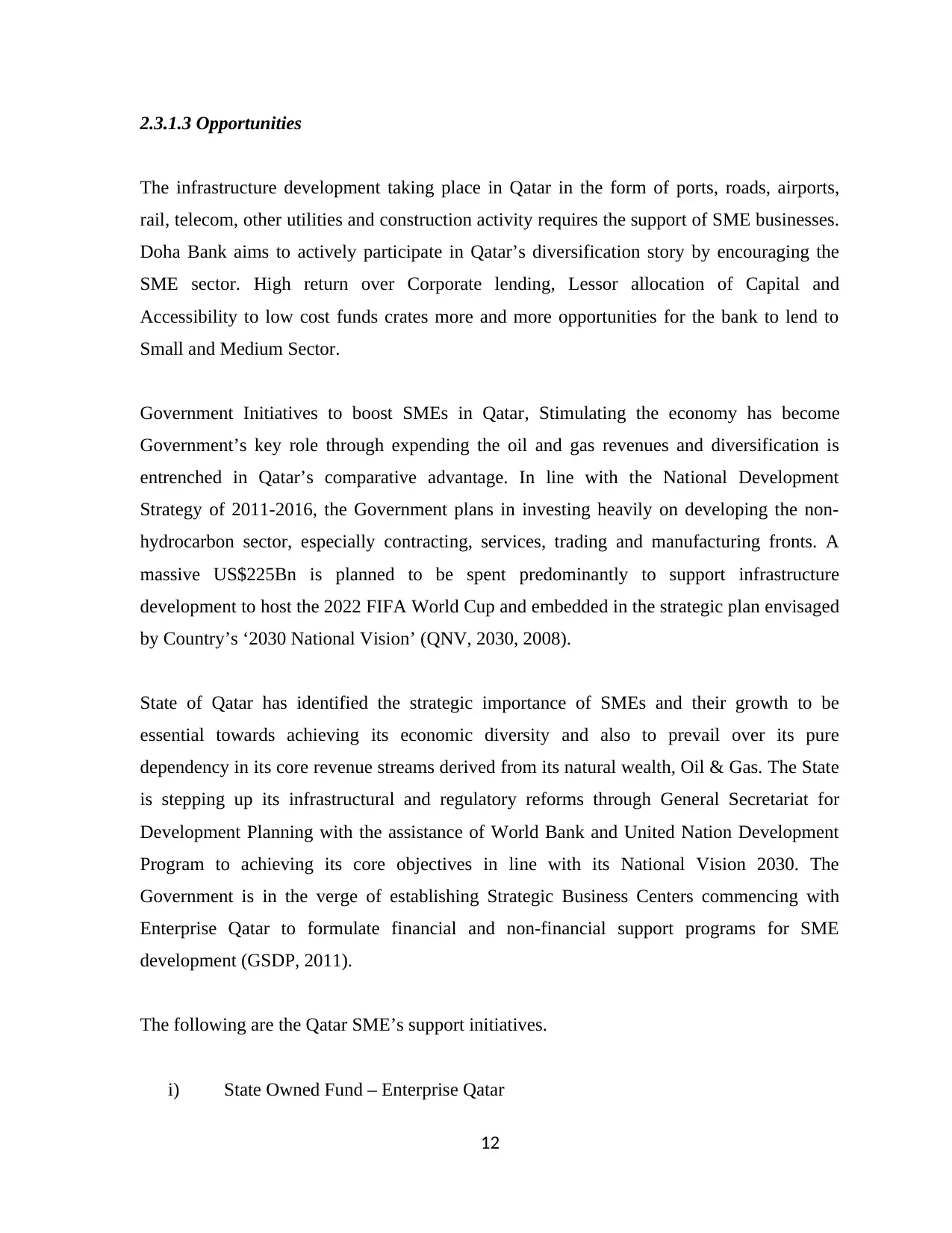
2.3.1.3 Opportunities
The infrastructure development taking place in Qatar in the form of ports, roads, airports,
rail, telecom, other utilities and construction activity requires the support of SME businesses.
Doha Bank aims to actively participate in Qatar’s diversification story by encouraging the
SME sector. High return over Corporate lending, Lessor allocation of Capital and
Accessibility to low cost funds crates more and more opportunities for the bank to lend to
Small and Medium Sector.
Government Initiatives to boost SMEs in Qatar, Stimulating the economy has become
Government’s key role through expending the oil and gas revenues and diversification is
entrenched in Qatar’s comparative advantage. In line with the National Development
Strategy of 2011-2016, the Government plans in investing heavily on developing the non-
hydrocarbon sector, especially contracting, services, trading and manufacturing fronts. A
massive US$225Bn is planned to be spent predominantly to support infrastructure
development to host the 2022 FIFA World Cup and embedded in the strategic plan envisaged
by Country’s ‘2030 National Vision’ (QNV, 2030, 2008).
State of Qatar has identified the strategic importance of SMEs and their growth to be
essential towards achieving its economic diversity and also to prevail over its pure
dependency in its core revenue streams derived from its natural wealth, Oil & Gas. The State
is stepping up its infrastructural and regulatory reforms through General Secretariat for
Development Planning with the assistance of World Bank and United Nation Development
Program to achieving its core objectives in line with its National Vision 2030. The
Government is in the verge of establishing Strategic Business Centers commencing with
Enterprise Qatar to formulate financial and non-financial support programs for SME
development (GSDP, 2011).
The following are the Qatar SME’s support initiatives.
i) State Owned Fund – Enterprise Qatar
12
The infrastructure development taking place in Qatar in the form of ports, roads, airports,
rail, telecom, other utilities and construction activity requires the support of SME businesses.
Doha Bank aims to actively participate in Qatar’s diversification story by encouraging the
SME sector. High return over Corporate lending, Lessor allocation of Capital and
Accessibility to low cost funds crates more and more opportunities for the bank to lend to
Small and Medium Sector.
Government Initiatives to boost SMEs in Qatar, Stimulating the economy has become
Government’s key role through expending the oil and gas revenues and diversification is
entrenched in Qatar’s comparative advantage. In line with the National Development
Strategy of 2011-2016, the Government plans in investing heavily on developing the non-
hydrocarbon sector, especially contracting, services, trading and manufacturing fronts. A
massive US$225Bn is planned to be spent predominantly to support infrastructure
development to host the 2022 FIFA World Cup and embedded in the strategic plan envisaged
by Country’s ‘2030 National Vision’ (QNV, 2030, 2008).
State of Qatar has identified the strategic importance of SMEs and their growth to be
essential towards achieving its economic diversity and also to prevail over its pure
dependency in its core revenue streams derived from its natural wealth, Oil & Gas. The State
is stepping up its infrastructural and regulatory reforms through General Secretariat for
Development Planning with the assistance of World Bank and United Nation Development
Program to achieving its core objectives in line with its National Vision 2030. The
Government is in the verge of establishing Strategic Business Centers commencing with
Enterprise Qatar to formulate financial and non-financial support programs for SME
development (GSDP, 2011).
The following are the Qatar SME’s support initiatives.
i) State Owned Fund – Enterprise Qatar
12
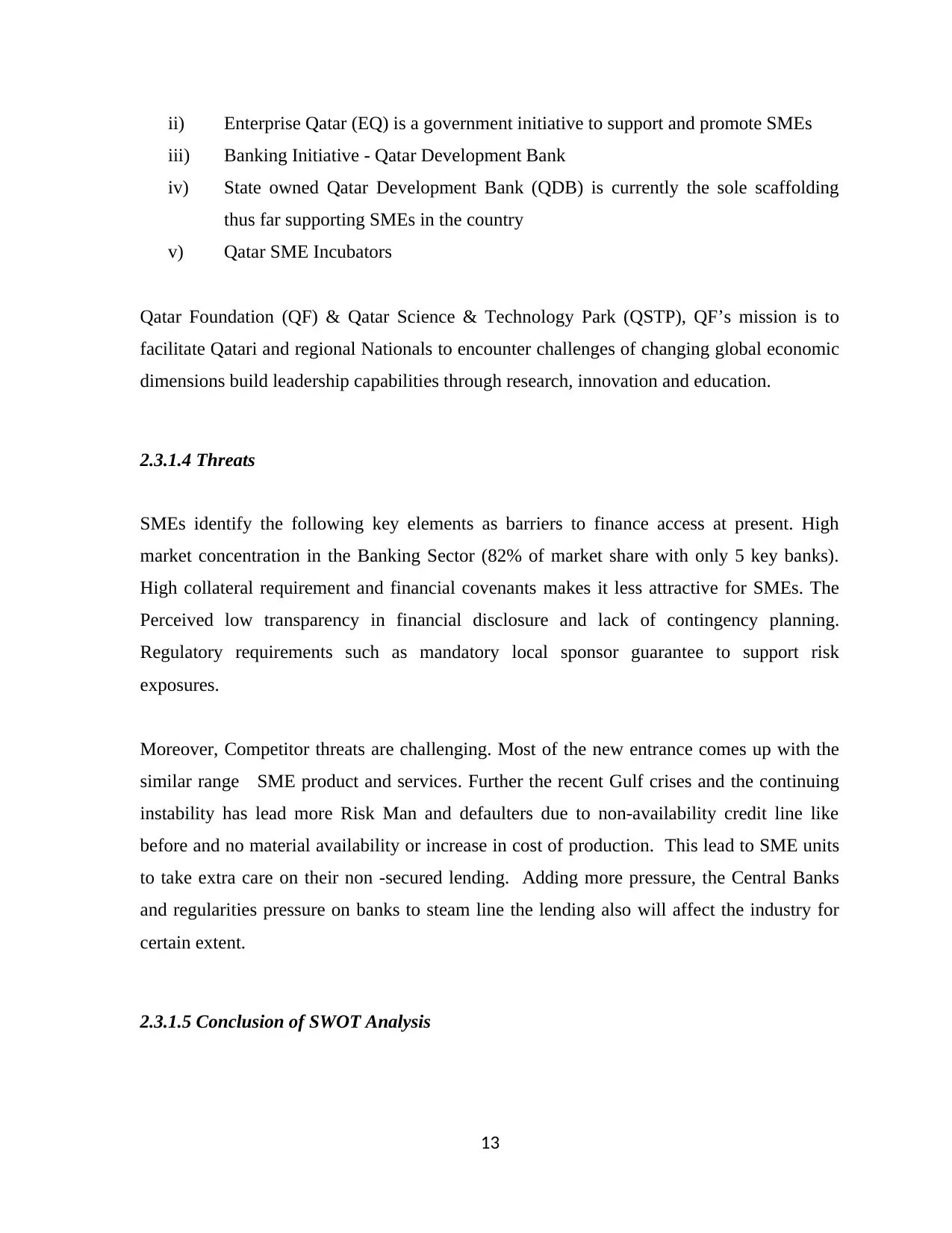
ii) Enterprise Qatar (EQ) is a government initiative to support and promote SMEs
iii) Banking Initiative - Qatar Development Bank
iv) State owned Qatar Development Bank (QDB) is currently the sole scaffolding
thus far supporting SMEs in the country
v) Qatar SME Incubators
Qatar Foundation (QF) & Qatar Science & Technology Park (QSTP), QF’s mission is to
facilitate Qatari and regional Nationals to encounter challenges of changing global economic
dimensions build leadership capabilities through research, innovation and education.
2.3.1.4 Threats
SMEs identify the following key elements as barriers to finance access at present. High
market concentration in the Banking Sector (82% of market share with only 5 key banks).
High collateral requirement and financial covenants makes it less attractive for SMEs. The
Perceived low transparency in financial disclosure and lack of contingency planning.
Regulatory requirements such as mandatory local sponsor guarantee to support risk
exposures.
Moreover, Competitor threats are challenging. Most of the new entrance comes up with the
similar range SME product and services. Further the recent Gulf crises and the continuing
instability has lead more Risk Man and defaulters due to non-availability credit line like
before and no material availability or increase in cost of production. This lead to SME units
to take extra care on their non -secured lending. Adding more pressure, the Central Banks
and regularities pressure on banks to steam line the lending also will affect the industry for
certain extent.
2.3.1.5 Conclusion of SWOT Analysis
13
iii) Banking Initiative - Qatar Development Bank
iv) State owned Qatar Development Bank (QDB) is currently the sole scaffolding
thus far supporting SMEs in the country
v) Qatar SME Incubators
Qatar Foundation (QF) & Qatar Science & Technology Park (QSTP), QF’s mission is to
facilitate Qatari and regional Nationals to encounter challenges of changing global economic
dimensions build leadership capabilities through research, innovation and education.
2.3.1.4 Threats
SMEs identify the following key elements as barriers to finance access at present. High
market concentration in the Banking Sector (82% of market share with only 5 key banks).
High collateral requirement and financial covenants makes it less attractive for SMEs. The
Perceived low transparency in financial disclosure and lack of contingency planning.
Regulatory requirements such as mandatory local sponsor guarantee to support risk
exposures.
Moreover, Competitor threats are challenging. Most of the new entrance comes up with the
similar range SME product and services. Further the recent Gulf crises and the continuing
instability has lead more Risk Man and defaulters due to non-availability credit line like
before and no material availability or increase in cost of production. This lead to SME units
to take extra care on their non -secured lending. Adding more pressure, the Central Banks
and regularities pressure on banks to steam line the lending also will affect the industry for
certain extent.
2.3.1.5 Conclusion of SWOT Analysis
13
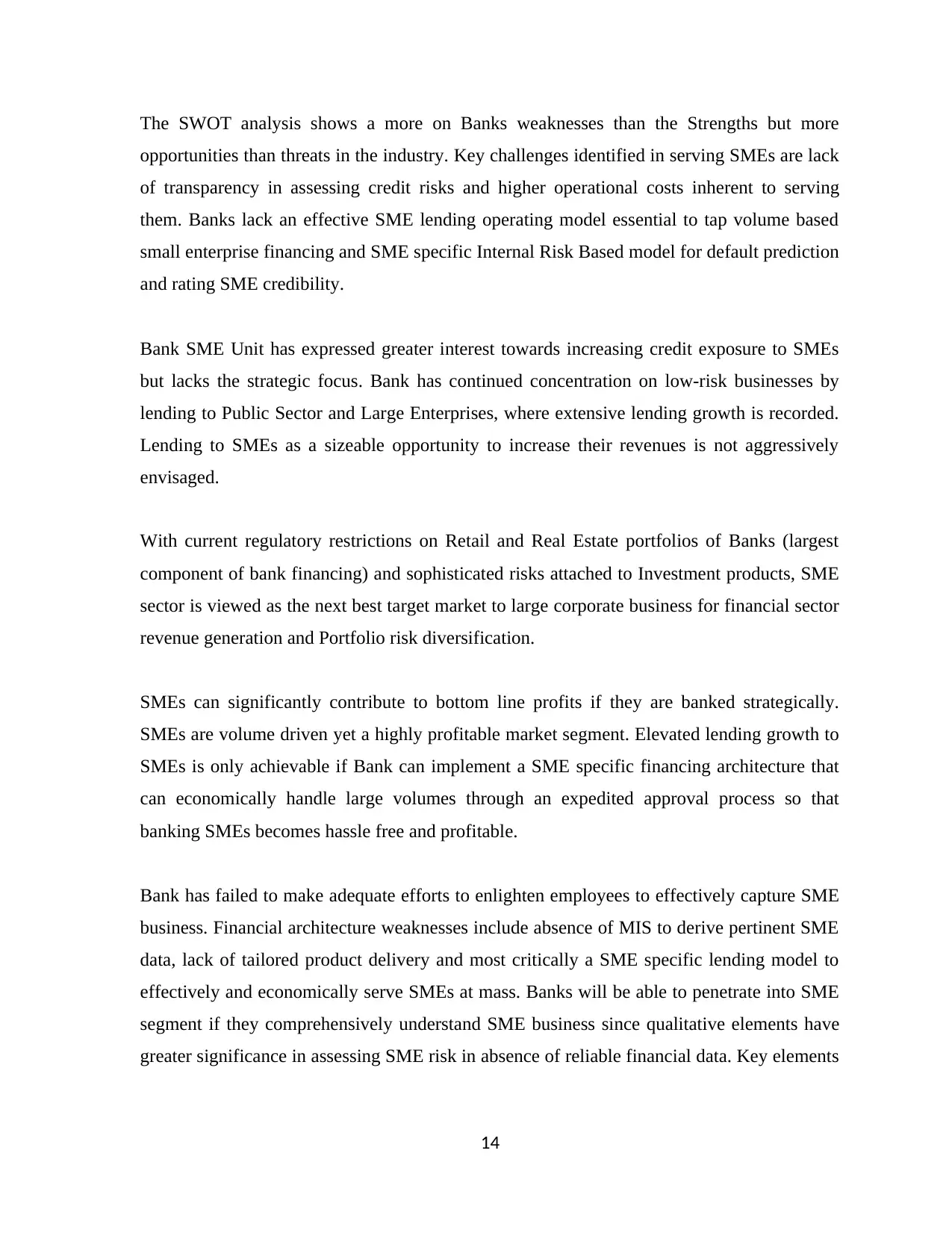
The SWOT analysis shows a more on Banks weaknesses than the Strengths but more
opportunities than threats in the industry. Key challenges identified in serving SMEs are lack
of transparency in assessing credit risks and higher operational costs inherent to serving
them. Banks lack an effective SME lending operating model essential to tap volume based
small enterprise financing and SME specific Internal Risk Based model for default prediction
and rating SME credibility.
Bank SME Unit has expressed greater interest towards increasing credit exposure to SMEs
but lacks the strategic focus. Bank has continued concentration on low-risk businesses by
lending to Public Sector and Large Enterprises, where extensive lending growth is recorded.
Lending to SMEs as a sizeable opportunity to increase their revenues is not aggressively
envisaged.
With current regulatory restrictions on Retail and Real Estate portfolios of Banks (largest
component of bank financing) and sophisticated risks attached to Investment products, SME
sector is viewed as the next best target market to large corporate business for financial sector
revenue generation and Portfolio risk diversification.
SMEs can significantly contribute to bottom line profits if they are banked strategically.
SMEs are volume driven yet a highly profitable market segment. Elevated lending growth to
SMEs is only achievable if Bank can implement a SME specific financing architecture that
can economically handle large volumes through an expedited approval process so that
banking SMEs becomes hassle free and profitable.
Bank has failed to make adequate efforts to enlighten employees to effectively capture SME
business. Financial architecture weaknesses include absence of MIS to derive pertinent SME
data, lack of tailored product delivery and most critically a SME specific lending model to
effectively and economically serve SMEs at mass. Banks will be able to penetrate into SME
segment if they comprehensively understand SME business since qualitative elements have
greater significance in assessing SME risk in absence of reliable financial data. Key elements
14
opportunities than threats in the industry. Key challenges identified in serving SMEs are lack
of transparency in assessing credit risks and higher operational costs inherent to serving
them. Banks lack an effective SME lending operating model essential to tap volume based
small enterprise financing and SME specific Internal Risk Based model for default prediction
and rating SME credibility.
Bank SME Unit has expressed greater interest towards increasing credit exposure to SMEs
but lacks the strategic focus. Bank has continued concentration on low-risk businesses by
lending to Public Sector and Large Enterprises, where extensive lending growth is recorded.
Lending to SMEs as a sizeable opportunity to increase their revenues is not aggressively
envisaged.
With current regulatory restrictions on Retail and Real Estate portfolios of Banks (largest
component of bank financing) and sophisticated risks attached to Investment products, SME
sector is viewed as the next best target market to large corporate business for financial sector
revenue generation and Portfolio risk diversification.
SMEs can significantly contribute to bottom line profits if they are banked strategically.
SMEs are volume driven yet a highly profitable market segment. Elevated lending growth to
SMEs is only achievable if Bank can implement a SME specific financing architecture that
can economically handle large volumes through an expedited approval process so that
banking SMEs becomes hassle free and profitable.
Bank has failed to make adequate efforts to enlighten employees to effectively capture SME
business. Financial architecture weaknesses include absence of MIS to derive pertinent SME
data, lack of tailored product delivery and most critically a SME specific lending model to
effectively and economically serve SMEs at mass. Banks will be able to penetrate into SME
segment if they comprehensively understand SME business since qualitative elements have
greater significance in assessing SME risk in absence of reliable financial data. Key elements
14
Secure Best Marks with AI Grader
Need help grading? Try our AI Grader for instant feedback on your assignments.
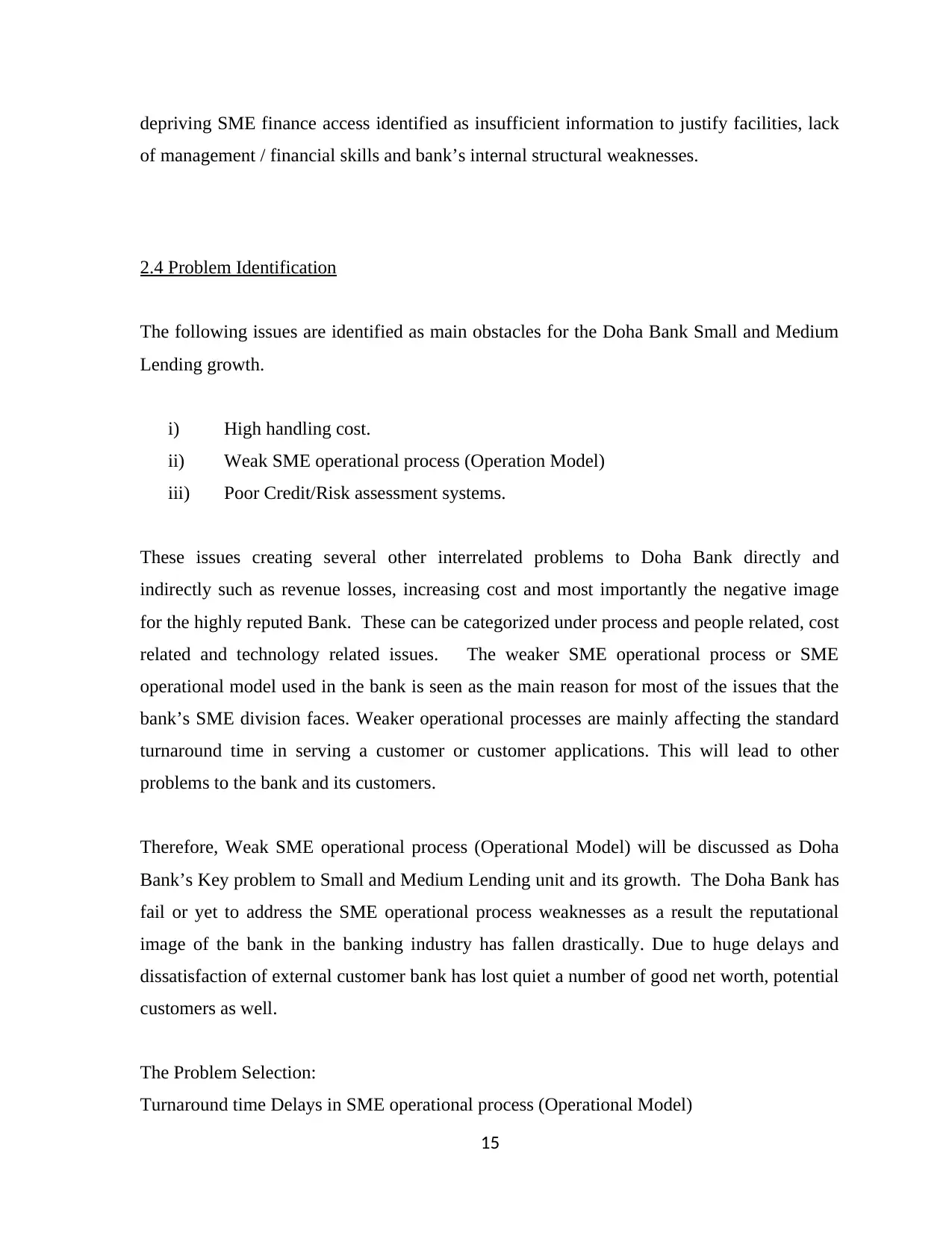
depriving SME finance access identified as insufficient information to justify facilities, lack
of management / financial skills and bank’s internal structural weaknesses.
2.4 Problem Identification
The following issues are identified as main obstacles for the Doha Bank Small and Medium
Lending growth.
i) High handling cost.
ii) Weak SME operational process (Operation Model)
iii) Poor Credit/Risk assessment systems.
These issues creating several other interrelated problems to Doha Bank directly and
indirectly such as revenue losses, increasing cost and most importantly the negative image
for the highly reputed Bank. These can be categorized under process and people related, cost
related and technology related issues. The weaker SME operational process or SME
operational model used in the bank is seen as the main reason for most of the issues that the
bank’s SME division faces. Weaker operational processes are mainly affecting the standard
turnaround time in serving a customer or customer applications. This will lead to other
problems to the bank and its customers.
Therefore, Weak SME operational process (Operational Model) will be discussed as Doha
Bank’s Key problem to Small and Medium Lending unit and its growth. The Doha Bank has
fail or yet to address the SME operational process weaknesses as a result the reputational
image of the bank in the banking industry has fallen drastically. Due to huge delays and
dissatisfaction of external customer bank has lost quiet a number of good net worth, potential
customers as well.
The Problem Selection:
Turnaround time Delays in SME operational process (Operational Model)
15
of management / financial skills and bank’s internal structural weaknesses.
2.4 Problem Identification
The following issues are identified as main obstacles for the Doha Bank Small and Medium
Lending growth.
i) High handling cost.
ii) Weak SME operational process (Operation Model)
iii) Poor Credit/Risk assessment systems.
These issues creating several other interrelated problems to Doha Bank directly and
indirectly such as revenue losses, increasing cost and most importantly the negative image
for the highly reputed Bank. These can be categorized under process and people related, cost
related and technology related issues. The weaker SME operational process or SME
operational model used in the bank is seen as the main reason for most of the issues that the
bank’s SME division faces. Weaker operational processes are mainly affecting the standard
turnaround time in serving a customer or customer applications. This will lead to other
problems to the bank and its customers.
Therefore, Weak SME operational process (Operational Model) will be discussed as Doha
Bank’s Key problem to Small and Medium Lending unit and its growth. The Doha Bank has
fail or yet to address the SME operational process weaknesses as a result the reputational
image of the bank in the banking industry has fallen drastically. Due to huge delays and
dissatisfaction of external customer bank has lost quiet a number of good net worth, potential
customers as well.
The Problem Selection:
Turnaround time Delays in SME operational process (Operational Model)
15
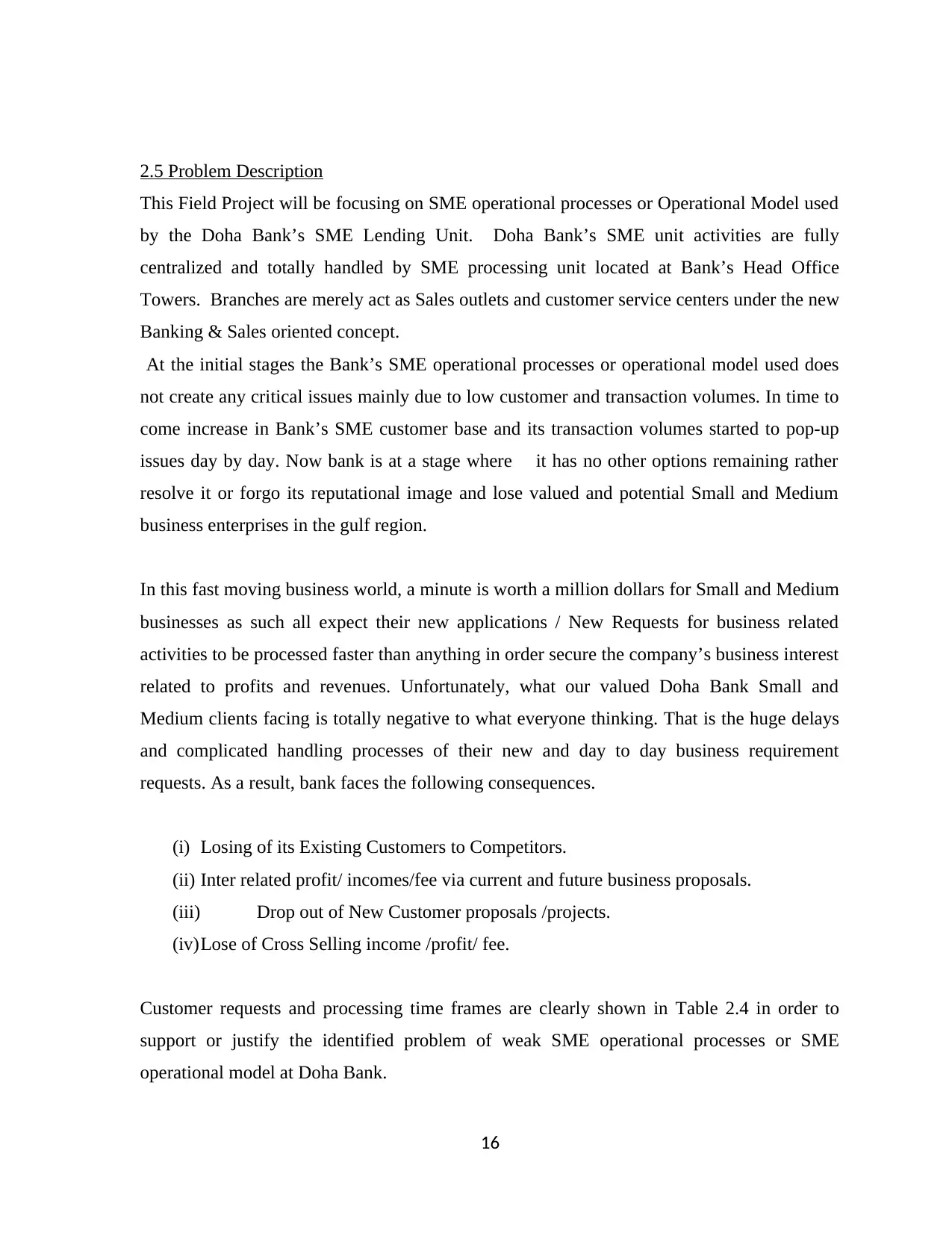
2.5 Problem Description
This Field Project will be focusing on SME operational processes or Operational Model used
by the Doha Bank’s SME Lending Unit. Doha Bank’s SME unit activities are fully
centralized and totally handled by SME processing unit located at Bank’s Head Office
Towers. Branches are merely act as Sales outlets and customer service centers under the new
Banking & Sales oriented concept.
At the initial stages the Bank’s SME operational processes or operational model used does
not create any critical issues mainly due to low customer and transaction volumes. In time to
come increase in Bank’s SME customer base and its transaction volumes started to pop-up
issues day by day. Now bank is at a stage where it has no other options remaining rather
resolve it or forgo its reputational image and lose valued and potential Small and Medium
business enterprises in the gulf region.
In this fast moving business world, a minute is worth a million dollars for Small and Medium
businesses as such all expect their new applications / New Requests for business related
activities to be processed faster than anything in order secure the company’s business interest
related to profits and revenues. Unfortunately, what our valued Doha Bank Small and
Medium clients facing is totally negative to what everyone thinking. That is the huge delays
and complicated handling processes of their new and day to day business requirement
requests. As a result, bank faces the following consequences.
(i) Losing of its Existing Customers to Competitors.
(ii) Inter related profit/ incomes/fee via current and future business proposals.
(iii) Drop out of New Customer proposals /projects.
(iv)Lose of Cross Selling income /profit/ fee.
Customer requests and processing time frames are clearly shown in Table 2.4 in order to
support or justify the identified problem of weak SME operational processes or SME
operational model at Doha Bank.
16
This Field Project will be focusing on SME operational processes or Operational Model used
by the Doha Bank’s SME Lending Unit. Doha Bank’s SME unit activities are fully
centralized and totally handled by SME processing unit located at Bank’s Head Office
Towers. Branches are merely act as Sales outlets and customer service centers under the new
Banking & Sales oriented concept.
At the initial stages the Bank’s SME operational processes or operational model used does
not create any critical issues mainly due to low customer and transaction volumes. In time to
come increase in Bank’s SME customer base and its transaction volumes started to pop-up
issues day by day. Now bank is at a stage where it has no other options remaining rather
resolve it or forgo its reputational image and lose valued and potential Small and Medium
business enterprises in the gulf region.
In this fast moving business world, a minute is worth a million dollars for Small and Medium
businesses as such all expect their new applications / New Requests for business related
activities to be processed faster than anything in order secure the company’s business interest
related to profits and revenues. Unfortunately, what our valued Doha Bank Small and
Medium clients facing is totally negative to what everyone thinking. That is the huge delays
and complicated handling processes of their new and day to day business requirement
requests. As a result, bank faces the following consequences.
(i) Losing of its Existing Customers to Competitors.
(ii) Inter related profit/ incomes/fee via current and future business proposals.
(iii) Drop out of New Customer proposals /projects.
(iv)Lose of Cross Selling income /profit/ fee.
Customer requests and processing time frames are clearly shown in Table 2.4 in order to
support or justify the identified problem of weak SME operational processes or SME
operational model at Doha Bank.
16
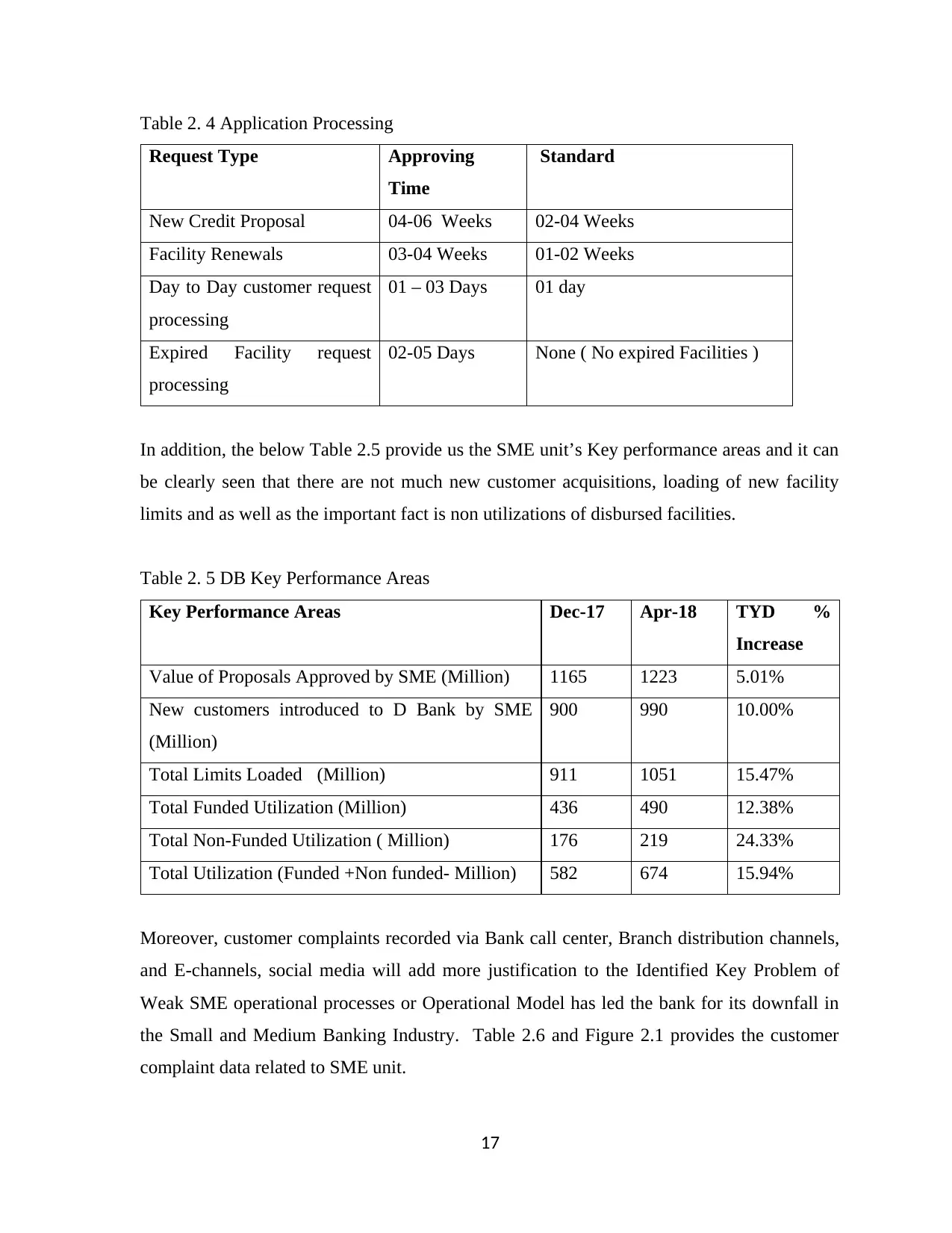
Table 2. 4 Application Processing
Request Type Approving
Time
Standard
New Credit Proposal 04-06 Weeks 02-04 Weeks
Facility Renewals 03-04 Weeks 01-02 Weeks
Day to Day customer request
processing
01 – 03 Days 01 day
Expired Facility request
processing
02-05 Days None ( No expired Facilities )
In addition, the below Table 2.5 provide us the SME unit’s Key performance areas and it can
be clearly seen that there are not much new customer acquisitions, loading of new facility
limits and as well as the important fact is non utilizations of disbursed facilities.
Table 2. 5 DB Key Performance Areas
Key Performance Areas Dec-17 Apr-18 TYD %
Increase
Value of Proposals Approved by SME (Million) 1165 1223 5.01%
New customers introduced to D Bank by SME
(Million)
900 990 10.00%
Total Limits Loaded (Million) 911 1051 15.47%
Total Funded Utilization (Million) 436 490 12.38%
Total Non-Funded Utilization ( Million) 176 219 24.33%
Total Utilization (Funded +Non funded- Million) 582 674 15.94%
Moreover, customer complaints recorded via Bank call center, Branch distribution channels,
and E-channels, social media will add more justification to the Identified Key Problem of
Weak SME operational processes or Operational Model has led the bank for its downfall in
the Small and Medium Banking Industry. Table 2.6 and Figure 2.1 provides the customer
complaint data related to SME unit.
17
Request Type Approving
Time
Standard
New Credit Proposal 04-06 Weeks 02-04 Weeks
Facility Renewals 03-04 Weeks 01-02 Weeks
Day to Day customer request
processing
01 – 03 Days 01 day
Expired Facility request
processing
02-05 Days None ( No expired Facilities )
In addition, the below Table 2.5 provide us the SME unit’s Key performance areas and it can
be clearly seen that there are not much new customer acquisitions, loading of new facility
limits and as well as the important fact is non utilizations of disbursed facilities.
Table 2. 5 DB Key Performance Areas
Key Performance Areas Dec-17 Apr-18 TYD %
Increase
Value of Proposals Approved by SME (Million) 1165 1223 5.01%
New customers introduced to D Bank by SME
(Million)
900 990 10.00%
Total Limits Loaded (Million) 911 1051 15.47%
Total Funded Utilization (Million) 436 490 12.38%
Total Non-Funded Utilization ( Million) 176 219 24.33%
Total Utilization (Funded +Non funded- Million) 582 674 15.94%
Moreover, customer complaints recorded via Bank call center, Branch distribution channels,
and E-channels, social media will add more justification to the Identified Key Problem of
Weak SME operational processes or Operational Model has led the bank for its downfall in
the Small and Medium Banking Industry. Table 2.6 and Figure 2.1 provides the customer
complaint data related to SME unit.
17
Paraphrase This Document
Need a fresh take? Get an instant paraphrase of this document with our AI Paraphraser
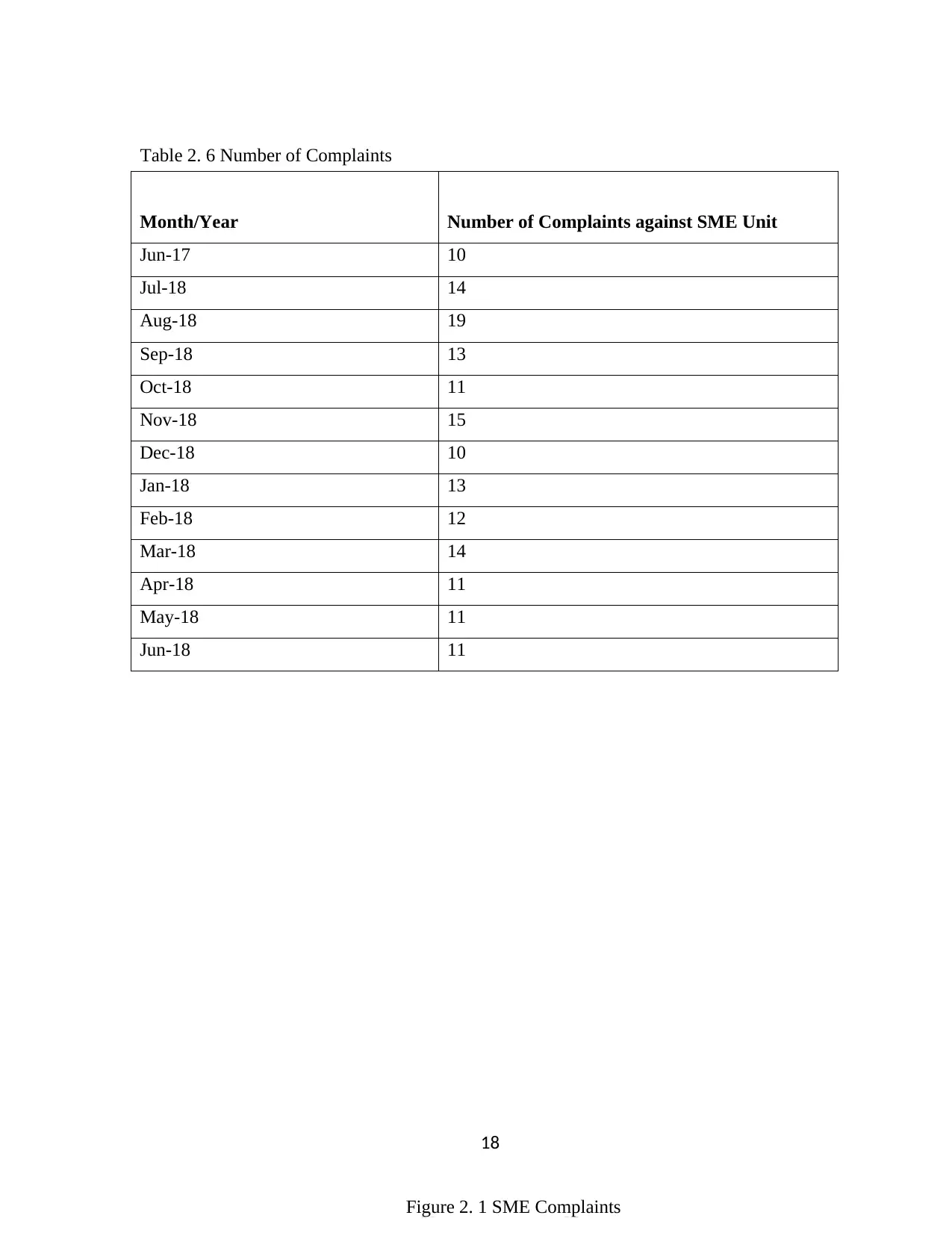
Table 2. 6 Number of Complaints
18
Figure 1: SME ComplaintsFigure 1. 1: SME ComplaintsFigure 2. 1 SME Complaints
Month/Year Number of Complaints against SME Unit
Jun-17 10
Jul-18 14
Aug-18 19
Sep-18 13
Oct-18 11
Nov-18 15
Dec-18 10
Jan-18 13
Feb-18 12
Mar-18 14
Apr-18 11
May-18 11
Jun-18 11
18
Figure 1: SME ComplaintsFigure 1. 1: SME ComplaintsFigure 2. 1 SME Complaints
Month/Year Number of Complaints against SME Unit
Jun-17 10
Jul-18 14
Aug-18 19
Sep-18 13
Oct-18 11
Nov-18 15
Dec-18 10
Jan-18 13
Feb-18 12
Mar-18 14
Apr-18 11
May-18 11
Jun-18 11

Above SME complaints shown in the Figure 2.1 is having following impact towards the
SME unit and the Bank itself. Table 2.7 explains impact in details.
Table 2. 7 SME complaints and impact
SME Complaints Impact towards Bank
Delaying New Proposals Loss of New potential business and bank
negative image
Delay in Security Documentations Customer Disappointment and bank
negative image
Delay in Daily Request approvals Customer Disappointment and losing
Customer to competitors. Customer interest
accumulation may be refunded by bank
Delay in Facility Disbursements Losing customer to Competitors, write off
of bank charges incurred due to delays.
Delay in Facility Renewals Losing of Interest income and commissions
Delay in Settlement of Facilities Losing of Interest income and commissions
19
18%
15%
12%24%
18%
12%
SME Complaints
New Proposal Security Doumentations Facility Disbursement
Facility Renewals Daily Business Requets Facility Settlements
SME unit and the Bank itself. Table 2.7 explains impact in details.
Table 2. 7 SME complaints and impact
SME Complaints Impact towards Bank
Delaying New Proposals Loss of New potential business and bank
negative image
Delay in Security Documentations Customer Disappointment and bank
negative image
Delay in Daily Request approvals Customer Disappointment and losing
Customer to competitors. Customer interest
accumulation may be refunded by bank
Delay in Facility Disbursements Losing customer to Competitors, write off
of bank charges incurred due to delays.
Delay in Facility Renewals Losing of Interest income and commissions
Delay in Settlement of Facilities Losing of Interest income and commissions
19
18%
15%
12%24%
18%
12%
SME Complaints
New Proposal Security Doumentations Facility Disbursement
Facility Renewals Daily Business Requets Facility Settlements
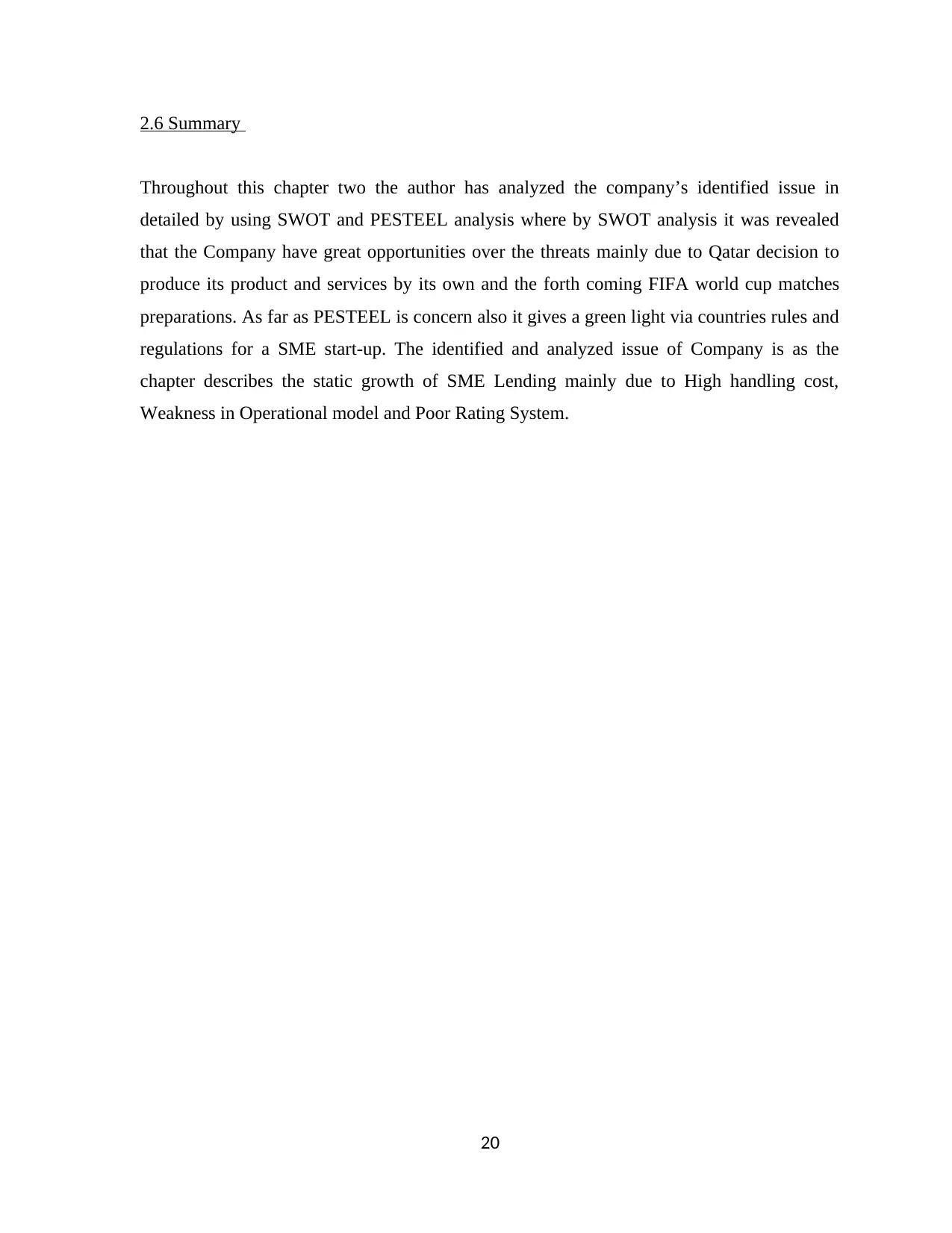
2.6 Summary
Throughout this chapter two the author has analyzed the company’s identified issue in
detailed by using SWOT and PESTEEL analysis where by SWOT analysis it was revealed
that the Company have great opportunities over the threats mainly due to Qatar decision to
produce its product and services by its own and the forth coming FIFA world cup matches
preparations. As far as PESTEEL is concern also it gives a green light via countries rules and
regulations for a SME start-up. The identified and analyzed issue of Company is as the
chapter describes the static growth of SME Lending mainly due to High handling cost,
Weakness in Operational model and Poor Rating System.
20
Throughout this chapter two the author has analyzed the company’s identified issue in
detailed by using SWOT and PESTEEL analysis where by SWOT analysis it was revealed
that the Company have great opportunities over the threats mainly due to Qatar decision to
produce its product and services by its own and the forth coming FIFA world cup matches
preparations. As far as PESTEEL is concern also it gives a green light via countries rules and
regulations for a SME start-up. The identified and analyzed issue of Company is as the
chapter describes the static growth of SME Lending mainly due to High handling cost,
Weakness in Operational model and Poor Rating System.
20
Secure Best Marks with AI Grader
Need help grading? Try our AI Grader for instant feedback on your assignments.
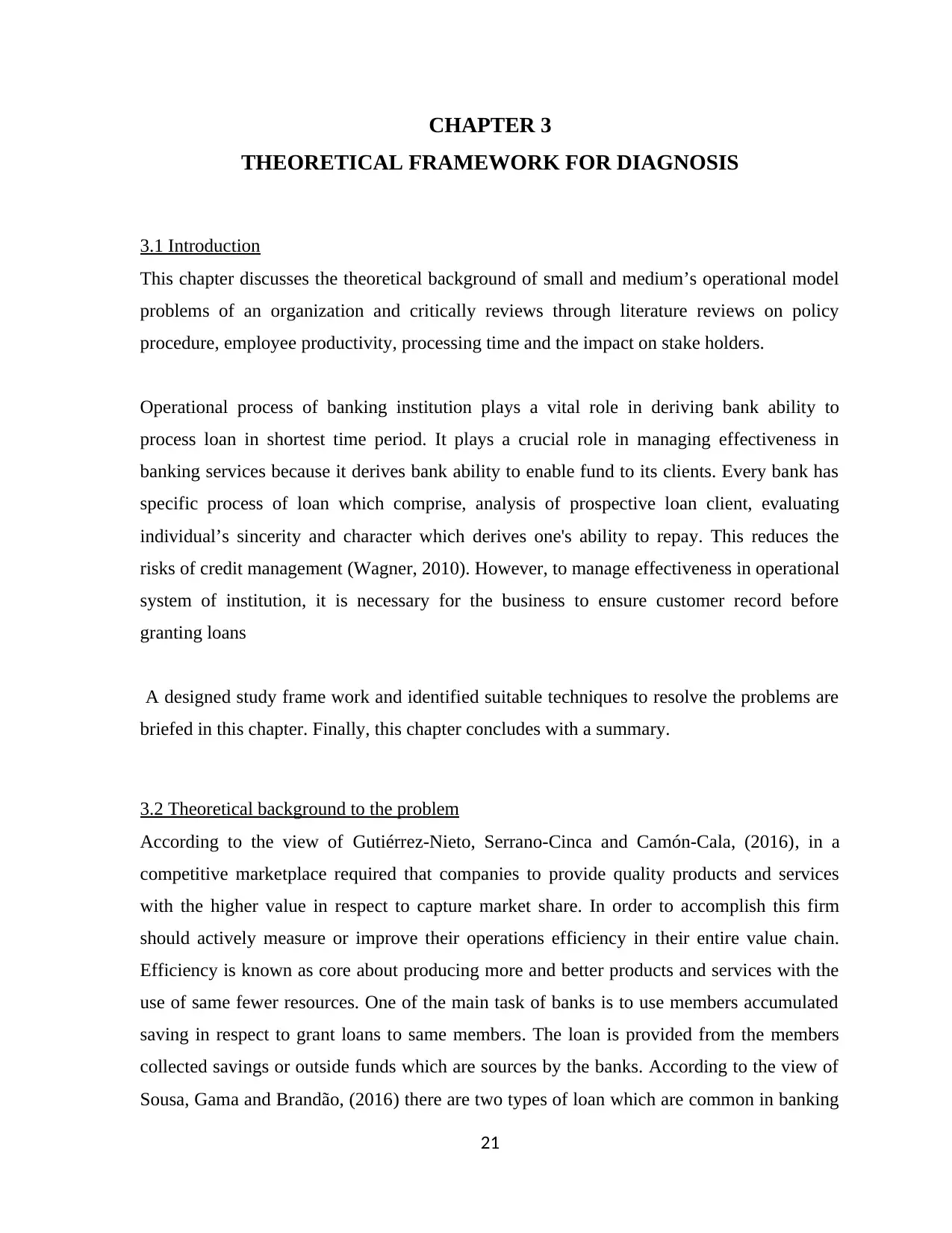
CHAPTER 3
THEORETICAL FRAMEWORK FOR DIAGNOSIS
3.1 Introduction
This chapter discusses the theoretical background of small and medium’s operational model
problems of an organization and critically reviews through literature reviews on policy
procedure, employee productivity, processing time and the impact on stake holders.
Operational process of banking institution plays a vital role in deriving bank ability to
process loan in shortest time period. It plays a crucial role in managing effectiveness in
banking services because it derives bank ability to enable fund to its clients. Every bank has
specific process of loan which comprise, analysis of prospective loan client, evaluating
individual’s sincerity and character which derives one's ability to repay. This reduces the
risks of credit management (Wagner, 2010). However, to manage effectiveness in operational
system of institution, it is necessary for the business to ensure customer record before
granting loans
A designed study frame work and identified suitable techniques to resolve the problems are
briefed in this chapter. Finally, this chapter concludes with a summary.
3.2 Theoretical background to the problem
According to the view of Gutiérrez-Nieto, Serrano-Cinca and Camón-Cala, (2016), in a
competitive marketplace required that companies to provide quality products and services
with the higher value in respect to capture market share. In order to accomplish this firm
should actively measure or improve their operations efficiency in their entire value chain.
Efficiency is known as core about producing more and better products and services with the
use of same fewer resources. One of the main task of banks is to use members accumulated
saving in respect to grant loans to same members. The loan is provided from the members
collected savings or outside funds which are sources by the banks. According to the view of
Sousa, Gama and Brandão, (2016) there are two types of loan which are common in banking
21
THEORETICAL FRAMEWORK FOR DIAGNOSIS
3.1 Introduction
This chapter discusses the theoretical background of small and medium’s operational model
problems of an organization and critically reviews through literature reviews on policy
procedure, employee productivity, processing time and the impact on stake holders.
Operational process of banking institution plays a vital role in deriving bank ability to
process loan in shortest time period. It plays a crucial role in managing effectiveness in
banking services because it derives bank ability to enable fund to its clients. Every bank has
specific process of loan which comprise, analysis of prospective loan client, evaluating
individual’s sincerity and character which derives one's ability to repay. This reduces the
risks of credit management (Wagner, 2010). However, to manage effectiveness in operational
system of institution, it is necessary for the business to ensure customer record before
granting loans
A designed study frame work and identified suitable techniques to resolve the problems are
briefed in this chapter. Finally, this chapter concludes with a summary.
3.2 Theoretical background to the problem
According to the view of Gutiérrez-Nieto, Serrano-Cinca and Camón-Cala, (2016), in a
competitive marketplace required that companies to provide quality products and services
with the higher value in respect to capture market share. In order to accomplish this firm
should actively measure or improve their operations efficiency in their entire value chain.
Efficiency is known as core about producing more and better products and services with the
use of same fewer resources. One of the main task of banks is to use members accumulated
saving in respect to grant loans to same members. The loan is provided from the members
collected savings or outside funds which are sources by the banks. According to the view of
Sousa, Gama and Brandão, (2016) there are two types of loan which are common in banking
21
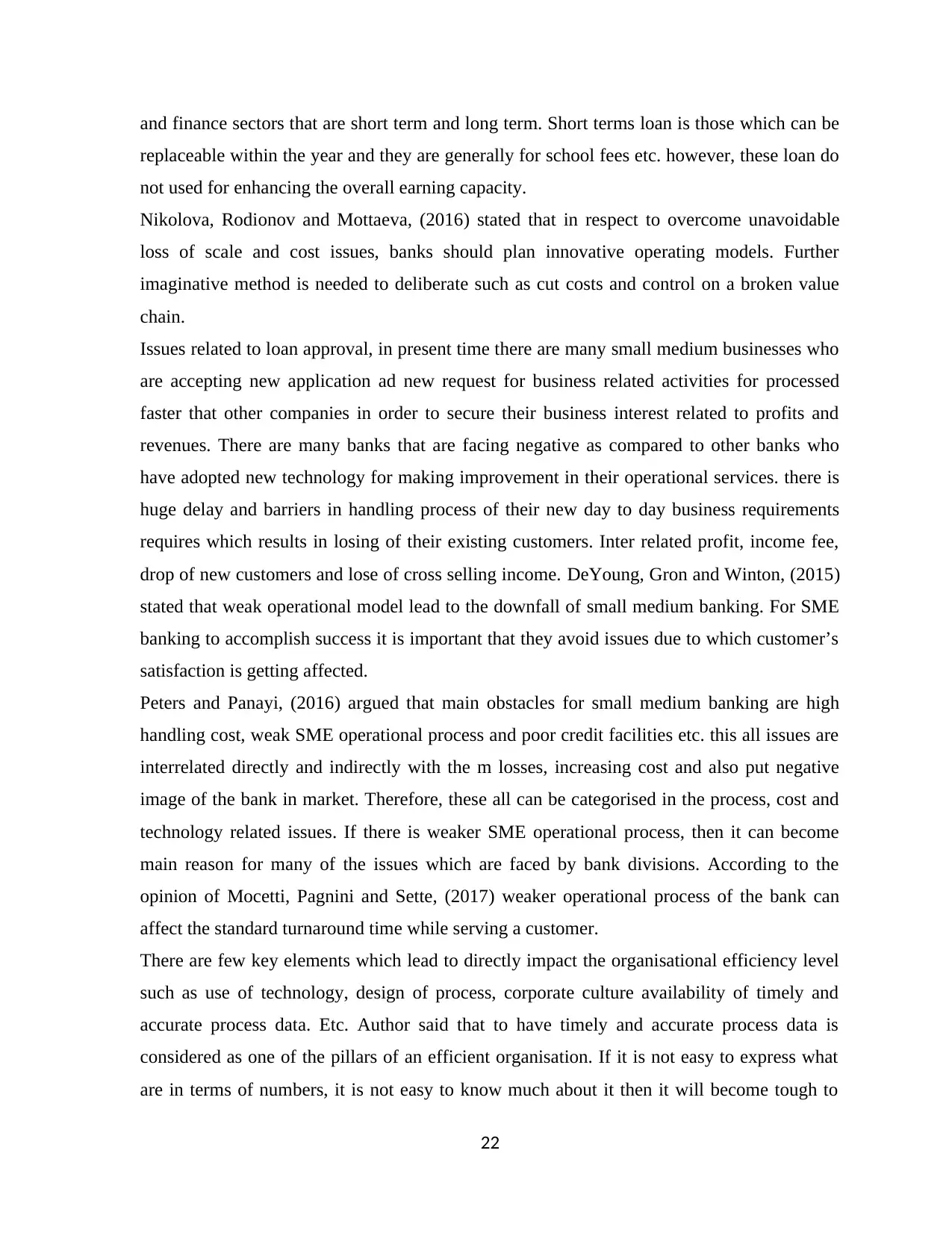
and finance sectors that are short term and long term. Short terms loan is those which can be
replaceable within the year and they are generally for school fees etc. however, these loan do
not used for enhancing the overall earning capacity.
Nikolova, Rodionov and Mottaeva, (2016) stated that in respect to overcome unavoidable
loss of scale and cost issues, banks should plan innovative operating models. Further
imaginative method is needed to deliberate such as cut costs and control on a broken value
chain.
Issues related to loan approval, in present time there are many small medium businesses who
are accepting new application ad new request for business related activities for processed
faster that other companies in order to secure their business interest related to profits and
revenues. There are many banks that are facing negative as compared to other banks who
have adopted new technology for making improvement in their operational services. there is
huge delay and barriers in handling process of their new day to day business requirements
requires which results in losing of their existing customers. Inter related profit, income fee,
drop of new customers and lose of cross selling income. DeYoung, Gron and Winton, (2015)
stated that weak operational model lead to the downfall of small medium banking. For SME
banking to accomplish success it is important that they avoid issues due to which customer’s
satisfaction is getting affected.
Peters and Panayi, (2016) argued that main obstacles for small medium banking are high
handling cost, weak SME operational process and poor credit facilities etc. this all issues are
interrelated directly and indirectly with the m losses, increasing cost and also put negative
image of the bank in market. Therefore, these all can be categorised in the process, cost and
technology related issues. If there is weaker SME operational process, then it can become
main reason for many of the issues which are faced by bank divisions. According to the
opinion of Mocetti, Pagnini and Sette, (2017) weaker operational process of the bank can
affect the standard turnaround time while serving a customer.
There are few key elements which lead to directly impact the organisational efficiency level
such as use of technology, design of process, corporate culture availability of timely and
accurate process data. Etc. Author said that to have timely and accurate process data is
considered as one of the pillars of an efficient organisation. If it is not easy to express what
are in terms of numbers, it is not easy to know much about it then it will become tough to
22
replaceable within the year and they are generally for school fees etc. however, these loan do
not used for enhancing the overall earning capacity.
Nikolova, Rodionov and Mottaeva, (2016) stated that in respect to overcome unavoidable
loss of scale and cost issues, banks should plan innovative operating models. Further
imaginative method is needed to deliberate such as cut costs and control on a broken value
chain.
Issues related to loan approval, in present time there are many small medium businesses who
are accepting new application ad new request for business related activities for processed
faster that other companies in order to secure their business interest related to profits and
revenues. There are many banks that are facing negative as compared to other banks who
have adopted new technology for making improvement in their operational services. there is
huge delay and barriers in handling process of their new day to day business requirements
requires which results in losing of their existing customers. Inter related profit, income fee,
drop of new customers and lose of cross selling income. DeYoung, Gron and Winton, (2015)
stated that weak operational model lead to the downfall of small medium banking. For SME
banking to accomplish success it is important that they avoid issues due to which customer’s
satisfaction is getting affected.
Peters and Panayi, (2016) argued that main obstacles for small medium banking are high
handling cost, weak SME operational process and poor credit facilities etc. this all issues are
interrelated directly and indirectly with the m losses, increasing cost and also put negative
image of the bank in market. Therefore, these all can be categorised in the process, cost and
technology related issues. If there is weaker SME operational process, then it can become
main reason for many of the issues which are faced by bank divisions. According to the
opinion of Mocetti, Pagnini and Sette, (2017) weaker operational process of the bank can
affect the standard turnaround time while serving a customer.
There are few key elements which lead to directly impact the organisational efficiency level
such as use of technology, design of process, corporate culture availability of timely and
accurate process data. Etc. Author said that to have timely and accurate process data is
considered as one of the pillars of an efficient organisation. If it is not easy to express what
are in terms of numbers, it is not easy to know much about it then it will become tough to
22
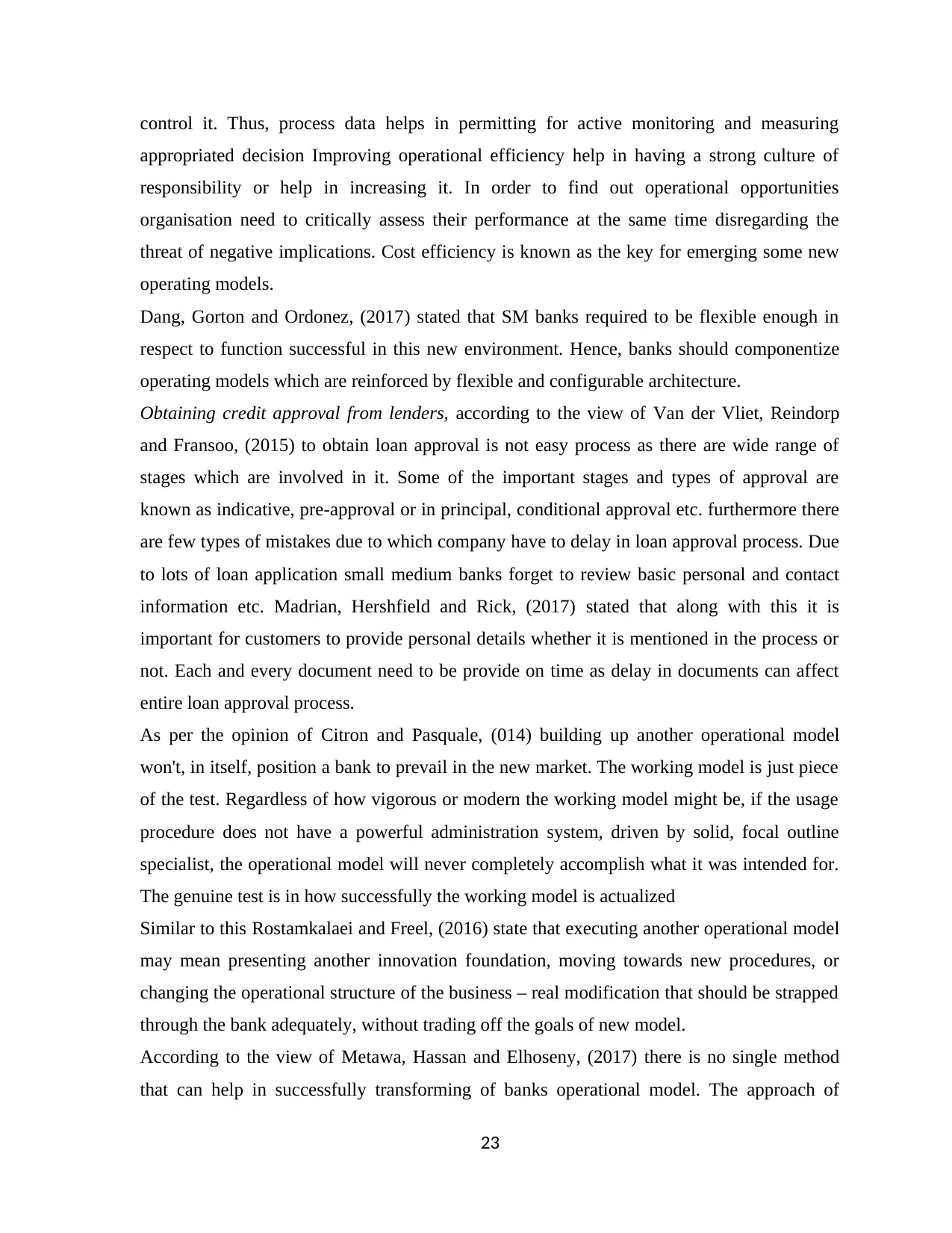
control it. Thus, process data helps in permitting for active monitoring and measuring
appropriated decision Improving operational efficiency help in having a strong culture of
responsibility or help in increasing it. In order to find out operational opportunities
organisation need to critically assess their performance at the same time disregarding the
threat of negative implications. Cost efficiency is known as the key for emerging some new
operating models.
Dang, Gorton and Ordonez, (2017) stated that SM banks required to be flexible enough in
respect to function successful in this new environment. Hence, banks should componentize
operating models which are reinforced by flexible and configurable architecture.
Obtaining credit approval from lenders, according to the view of Van der Vliet, Reindorp
and Fransoo, (2015) to obtain loan approval is not easy process as there are wide range of
stages which are involved in it. Some of the important stages and types of approval are
known as indicative, pre-approval or in principal, conditional approval etc. furthermore there
are few types of mistakes due to which company have to delay in loan approval process. Due
to lots of loan application small medium banks forget to review basic personal and contact
information etc. Madrian, Hershfield and Rick, (2017) stated that along with this it is
important for customers to provide personal details whether it is mentioned in the process or
not. Each and every document need to be provide on time as delay in documents can affect
entire loan approval process.
As per the opinion of Citron and Pasquale, (014) building up another operational model
won't, in itself, position a bank to prevail in the new market. The working model is just piece
of the test. Regardless of how vigorous or modern the working model might be, if the usage
procedure does not have a powerful administration system, driven by solid, focal outline
specialist, the operational model will never completely accomplish what it was intended for.
The genuine test is in how successfully the working model is actualized
Similar to this Rostamkalaei and Freel, (2016) state that executing another operational model
may mean presenting another innovation foundation, moving towards new procedures, or
changing the operational structure of the business – real modification that should be strapped
through the bank adequately, without trading off the goals of new model.
According to the view of Metawa, Hassan and Elhoseny, (2017) there is no single method
that can help in successfully transforming of banks operational model. The approach of
23
appropriated decision Improving operational efficiency help in having a strong culture of
responsibility or help in increasing it. In order to find out operational opportunities
organisation need to critically assess their performance at the same time disregarding the
threat of negative implications. Cost efficiency is known as the key for emerging some new
operating models.
Dang, Gorton and Ordonez, (2017) stated that SM banks required to be flexible enough in
respect to function successful in this new environment. Hence, banks should componentize
operating models which are reinforced by flexible and configurable architecture.
Obtaining credit approval from lenders, according to the view of Van der Vliet, Reindorp
and Fransoo, (2015) to obtain loan approval is not easy process as there are wide range of
stages which are involved in it. Some of the important stages and types of approval are
known as indicative, pre-approval or in principal, conditional approval etc. furthermore there
are few types of mistakes due to which company have to delay in loan approval process. Due
to lots of loan application small medium banks forget to review basic personal and contact
information etc. Madrian, Hershfield and Rick, (2017) stated that along with this it is
important for customers to provide personal details whether it is mentioned in the process or
not. Each and every document need to be provide on time as delay in documents can affect
entire loan approval process.
As per the opinion of Citron and Pasquale, (014) building up another operational model
won't, in itself, position a bank to prevail in the new market. The working model is just piece
of the test. Regardless of how vigorous or modern the working model might be, if the usage
procedure does not have a powerful administration system, driven by solid, focal outline
specialist, the operational model will never completely accomplish what it was intended for.
The genuine test is in how successfully the working model is actualized
Similar to this Rostamkalaei and Freel, (2016) state that executing another operational model
may mean presenting another innovation foundation, moving towards new procedures, or
changing the operational structure of the business – real modification that should be strapped
through the bank adequately, without trading off the goals of new model.
According to the view of Metawa, Hassan and Elhoseny, (2017) there is no single method
that can help in successfully transforming of banks operational model. The approach of
23
Paraphrase This Document
Need a fresh take? Get an instant paraphrase of this document with our AI Paraphraser
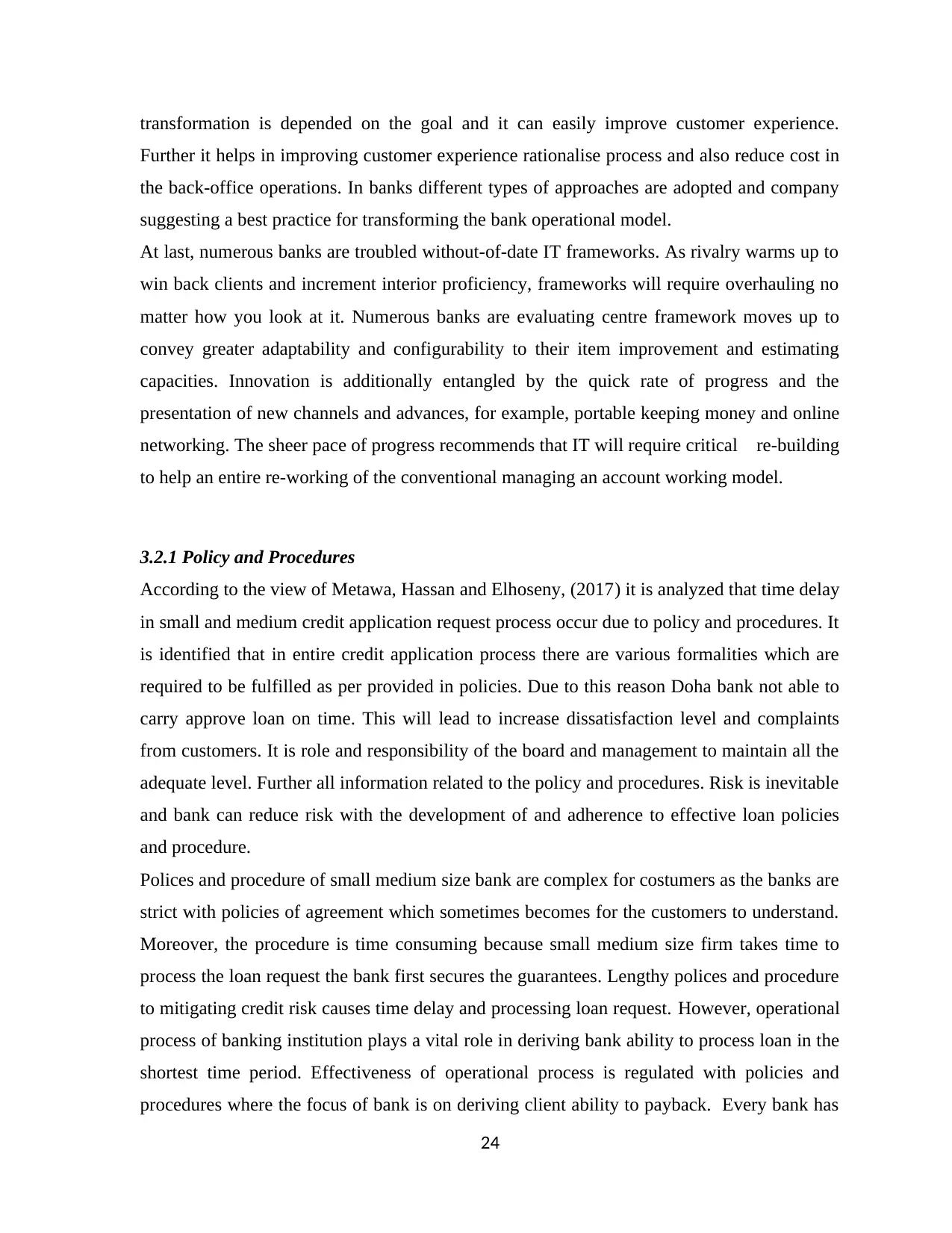
transformation is depended on the goal and it can easily improve customer experience.
Further it helps in improving customer experience rationalise process and also reduce cost in
the back-office operations. In banks different types of approaches are adopted and company
suggesting a best practice for transforming the bank operational model.
At last, numerous banks are troubled without-of-date IT frameworks. As rivalry warms up to
win back clients and increment interior proficiency, frameworks will require overhauling no
matter how you look at it. Numerous banks are evaluating centre framework moves up to
convey greater adaptability and configurability to their item improvement and estimating
capacities. Innovation is additionally entangled by the quick rate of progress and the
presentation of new channels and advances, for example, portable keeping money and online
networking. The sheer pace of progress recommends that IT will require critical re-building
to help an entire re-working of the conventional managing an account working model.
3.2.1 Policy and Procedures
According to the view of Metawa, Hassan and Elhoseny, (2017) it is analyzed that time delay
in small and medium credit application request process occur due to policy and procedures. It
is identified that in entire credit application process there are various formalities which are
required to be fulfilled as per provided in policies. Due to this reason Doha bank not able to
carry approve loan on time. This will lead to increase dissatisfaction level and complaints
from customers. It is role and responsibility of the board and management to maintain all the
adequate level. Further all information related to the policy and procedures. Risk is inevitable
and bank can reduce risk with the development of and adherence to effective loan policies
and procedure.
Polices and procedure of small medium size bank are complex for costumers as the banks are
strict with policies of agreement which sometimes becomes for the customers to understand.
Moreover, the procedure is time consuming because small medium size firm takes time to
process the loan request the bank first secures the guarantees. Lengthy polices and procedure
to mitigating credit risk causes time delay and processing loan request. However, operational
process of banking institution plays a vital role in deriving bank ability to process loan in the
shortest time period. Effectiveness of operational process is regulated with policies and
procedures where the focus of bank is on deriving client ability to payback. Every bank has
24
Further it helps in improving customer experience rationalise process and also reduce cost in
the back-office operations. In banks different types of approaches are adopted and company
suggesting a best practice for transforming the bank operational model.
At last, numerous banks are troubled without-of-date IT frameworks. As rivalry warms up to
win back clients and increment interior proficiency, frameworks will require overhauling no
matter how you look at it. Numerous banks are evaluating centre framework moves up to
convey greater adaptability and configurability to their item improvement and estimating
capacities. Innovation is additionally entangled by the quick rate of progress and the
presentation of new channels and advances, for example, portable keeping money and online
networking. The sheer pace of progress recommends that IT will require critical re-building
to help an entire re-working of the conventional managing an account working model.
3.2.1 Policy and Procedures
According to the view of Metawa, Hassan and Elhoseny, (2017) it is analyzed that time delay
in small and medium credit application request process occur due to policy and procedures. It
is identified that in entire credit application process there are various formalities which are
required to be fulfilled as per provided in policies. Due to this reason Doha bank not able to
carry approve loan on time. This will lead to increase dissatisfaction level and complaints
from customers. It is role and responsibility of the board and management to maintain all the
adequate level. Further all information related to the policy and procedures. Risk is inevitable
and bank can reduce risk with the development of and adherence to effective loan policies
and procedure.
Polices and procedure of small medium size bank are complex for costumers as the banks are
strict with policies of agreement which sometimes becomes for the customers to understand.
Moreover, the procedure is time consuming because small medium size firm takes time to
process the loan request the bank first secures the guarantees. Lengthy polices and procedure
to mitigating credit risk causes time delay and processing loan request. However, operational
process of banking institution plays a vital role in deriving bank ability to process loan in the
shortest time period. Effectiveness of operational process is regulated with policies and
procedures where the focus of bank is on deriving client ability to payback. Every bank has
24
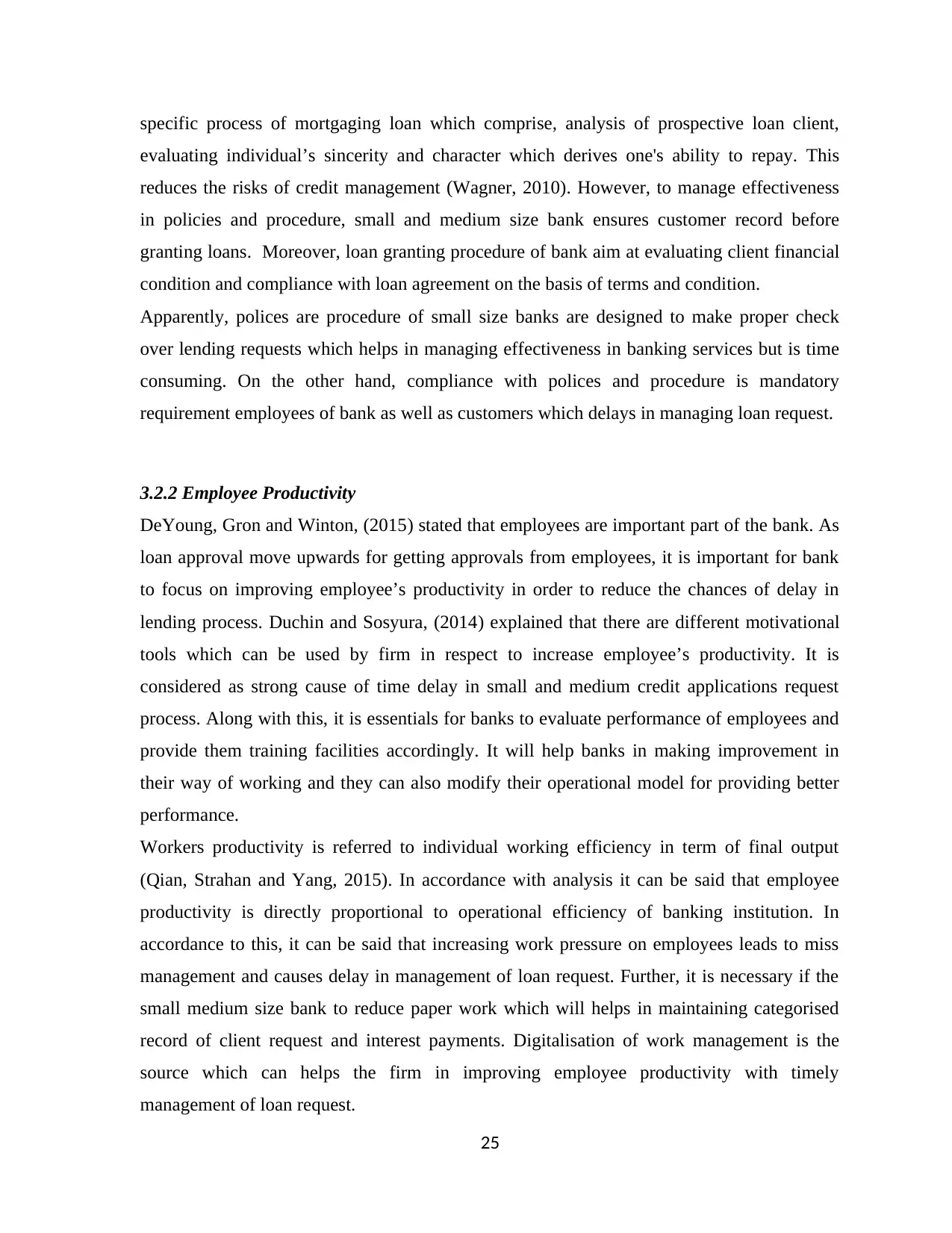
specific process of mortgaging loan which comprise, analysis of prospective loan client,
evaluating individual’s sincerity and character which derives one's ability to repay. This
reduces the risks of credit management (Wagner, 2010). However, to manage effectiveness
in policies and procedure, small and medium size bank ensures customer record before
granting loans. Moreover, loan granting procedure of bank aim at evaluating client financial
condition and compliance with loan agreement on the basis of terms and condition.
Apparently, polices are procedure of small size banks are designed to make proper check
over lending requests which helps in managing effectiveness in banking services but is time
consuming. On the other hand, compliance with polices and procedure is mandatory
requirement employees of bank as well as customers which delays in managing loan request.
3.2.2 Employee Productivity
DeYoung, Gron and Winton, (2015) stated that employees are important part of the bank. As
loan approval move upwards for getting approvals from employees, it is important for bank
to focus on improving employee’s productivity in order to reduce the chances of delay in
lending process. Duchin and Sosyura, (2014) explained that there are different motivational
tools which can be used by firm in respect to increase employee’s productivity. It is
considered as strong cause of time delay in small and medium credit applications request
process. Along with this, it is essentials for banks to evaluate performance of employees and
provide them training facilities accordingly. It will help banks in making improvement in
their way of working and they can also modify their operational model for providing better
performance.
Workers productivity is referred to individual working efficiency in term of final output
(Qian, Strahan and Yang, 2015). In accordance with analysis it can be said that employee
productivity is directly proportional to operational efficiency of banking institution. In
accordance to this, it can be said that increasing work pressure on employees leads to miss
management and causes delay in management of loan request. Further, it is necessary if the
small medium size bank to reduce paper work which will helps in maintaining categorised
record of client request and interest payments. Digitalisation of work management is the
source which can helps the firm in improving employee productivity with timely
management of loan request.
25
evaluating individual’s sincerity and character which derives one's ability to repay. This
reduces the risks of credit management (Wagner, 2010). However, to manage effectiveness
in policies and procedure, small and medium size bank ensures customer record before
granting loans. Moreover, loan granting procedure of bank aim at evaluating client financial
condition and compliance with loan agreement on the basis of terms and condition.
Apparently, polices are procedure of small size banks are designed to make proper check
over lending requests which helps in managing effectiveness in banking services but is time
consuming. On the other hand, compliance with polices and procedure is mandatory
requirement employees of bank as well as customers which delays in managing loan request.
3.2.2 Employee Productivity
DeYoung, Gron and Winton, (2015) stated that employees are important part of the bank. As
loan approval move upwards for getting approvals from employees, it is important for bank
to focus on improving employee’s productivity in order to reduce the chances of delay in
lending process. Duchin and Sosyura, (2014) explained that there are different motivational
tools which can be used by firm in respect to increase employee’s productivity. It is
considered as strong cause of time delay in small and medium credit applications request
process. Along with this, it is essentials for banks to evaluate performance of employees and
provide them training facilities accordingly. It will help banks in making improvement in
their way of working and they can also modify their operational model for providing better
performance.
Workers productivity is referred to individual working efficiency in term of final output
(Qian, Strahan and Yang, 2015). In accordance with analysis it can be said that employee
productivity is directly proportional to operational efficiency of banking institution. In
accordance to this, it can be said that increasing work pressure on employees leads to miss
management and causes delay in management of loan request. Further, it is necessary if the
small medium size bank to reduce paper work which will helps in maintaining categorised
record of client request and interest payments. Digitalisation of work management is the
source which can helps the firm in improving employee productivity with timely
management of loan request.
25
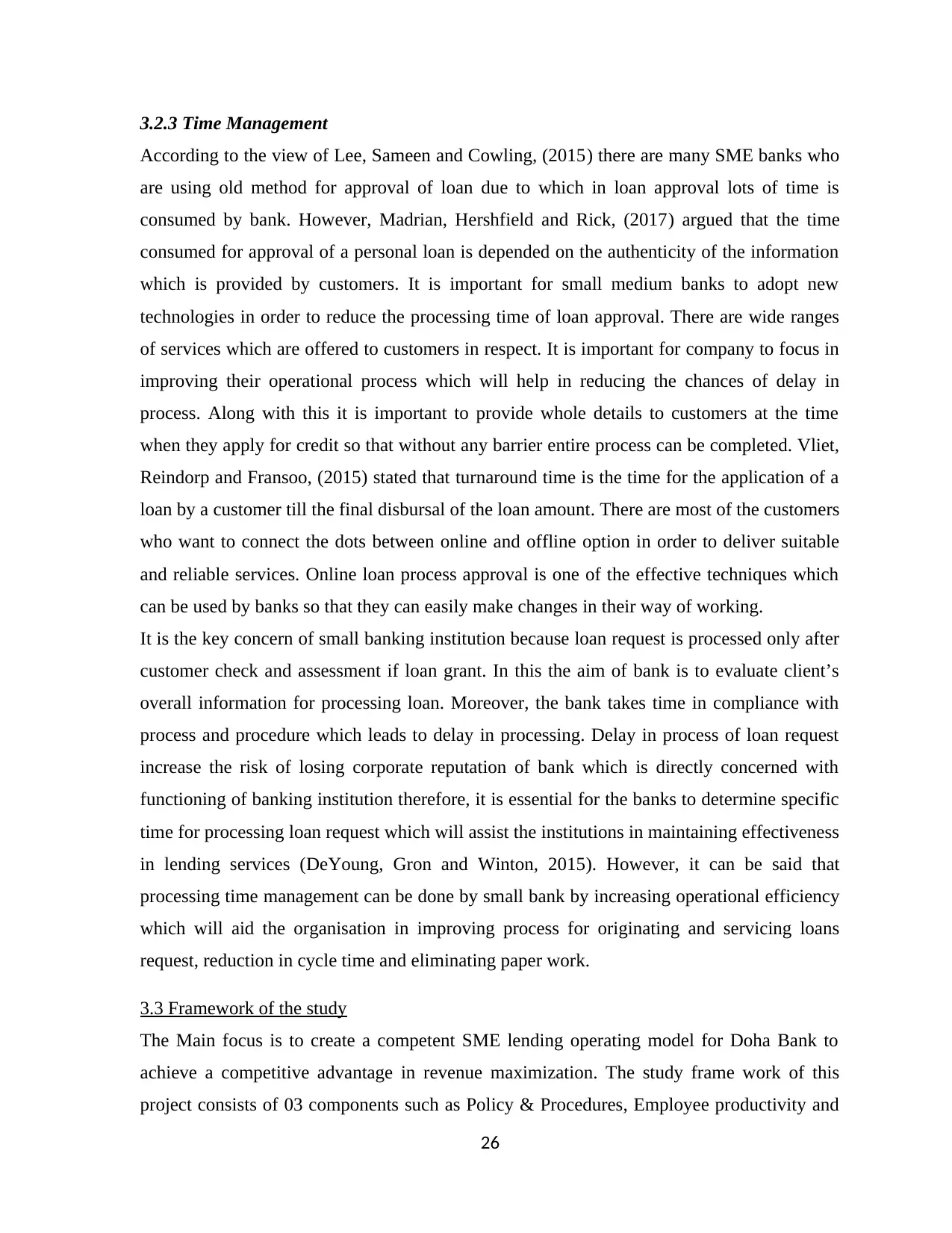
3.2.3 Time Management
According to the view of Lee, Sameen and Cowling, (2015) there are many SME banks who
are using old method for approval of loan due to which in loan approval lots of time is
consumed by bank. However, Madrian, Hershfield and Rick, (2017) argued that the time
consumed for approval of a personal loan is depended on the authenticity of the information
which is provided by customers. It is important for small medium banks to adopt new
technologies in order to reduce the processing time of loan approval. There are wide ranges
of services which are offered to customers in respect. It is important for company to focus in
improving their operational process which will help in reducing the chances of delay in
process. Along with this it is important to provide whole details to customers at the time
when they apply for credit so that without any barrier entire process can be completed. Vliet,
Reindorp and Fransoo, (2015) stated that turnaround time is the time for the application of a
loan by a customer till the final disbursal of the loan amount. There are most of the customers
who want to connect the dots between online and offline option in order to deliver suitable
and reliable services. Online loan process approval is one of the effective techniques which
can be used by banks so that they can easily make changes in their way of working.
It is the key concern of small banking institution because loan request is processed only after
customer check and assessment if loan grant. In this the aim of bank is to evaluate client’s
overall information for processing loan. Moreover, the bank takes time in compliance with
process and procedure which leads to delay in processing. Delay in process of loan request
increase the risk of losing corporate reputation of bank which is directly concerned with
functioning of banking institution therefore, it is essential for the banks to determine specific
time for processing loan request which will assist the institutions in maintaining effectiveness
in lending services (DeYoung, Gron and Winton, 2015). However, it can be said that
processing time management can be done by small bank by increasing operational efficiency
which will aid the organisation in improving process for originating and servicing loans
request, reduction in cycle time and eliminating paper work.
3.3 Framework of the study
The Main focus is to create a competent SME lending operating model for Doha Bank to
achieve a competitive advantage in revenue maximization. The study frame work of this
project consists of 03 components such as Policy & Procedures, Employee productivity and
26
According to the view of Lee, Sameen and Cowling, (2015) there are many SME banks who
are using old method for approval of loan due to which in loan approval lots of time is
consumed by bank. However, Madrian, Hershfield and Rick, (2017) argued that the time
consumed for approval of a personal loan is depended on the authenticity of the information
which is provided by customers. It is important for small medium banks to adopt new
technologies in order to reduce the processing time of loan approval. There are wide ranges
of services which are offered to customers in respect. It is important for company to focus in
improving their operational process which will help in reducing the chances of delay in
process. Along with this it is important to provide whole details to customers at the time
when they apply for credit so that without any barrier entire process can be completed. Vliet,
Reindorp and Fransoo, (2015) stated that turnaround time is the time for the application of a
loan by a customer till the final disbursal of the loan amount. There are most of the customers
who want to connect the dots between online and offline option in order to deliver suitable
and reliable services. Online loan process approval is one of the effective techniques which
can be used by banks so that they can easily make changes in their way of working.
It is the key concern of small banking institution because loan request is processed only after
customer check and assessment if loan grant. In this the aim of bank is to evaluate client’s
overall information for processing loan. Moreover, the bank takes time in compliance with
process and procedure which leads to delay in processing. Delay in process of loan request
increase the risk of losing corporate reputation of bank which is directly concerned with
functioning of banking institution therefore, it is essential for the banks to determine specific
time for processing loan request which will assist the institutions in maintaining effectiveness
in lending services (DeYoung, Gron and Winton, 2015). However, it can be said that
processing time management can be done by small bank by increasing operational efficiency
which will aid the organisation in improving process for originating and servicing loans
request, reduction in cycle time and eliminating paper work.
3.3 Framework of the study
The Main focus is to create a competent SME lending operating model for Doha Bank to
achieve a competitive advantage in revenue maximization. The study frame work of this
project consists of 03 components such as Policy & Procedures, Employee productivity and
26
Secure Best Marks with AI Grader
Need help grading? Try our AI Grader for instant feedback on your assignments.
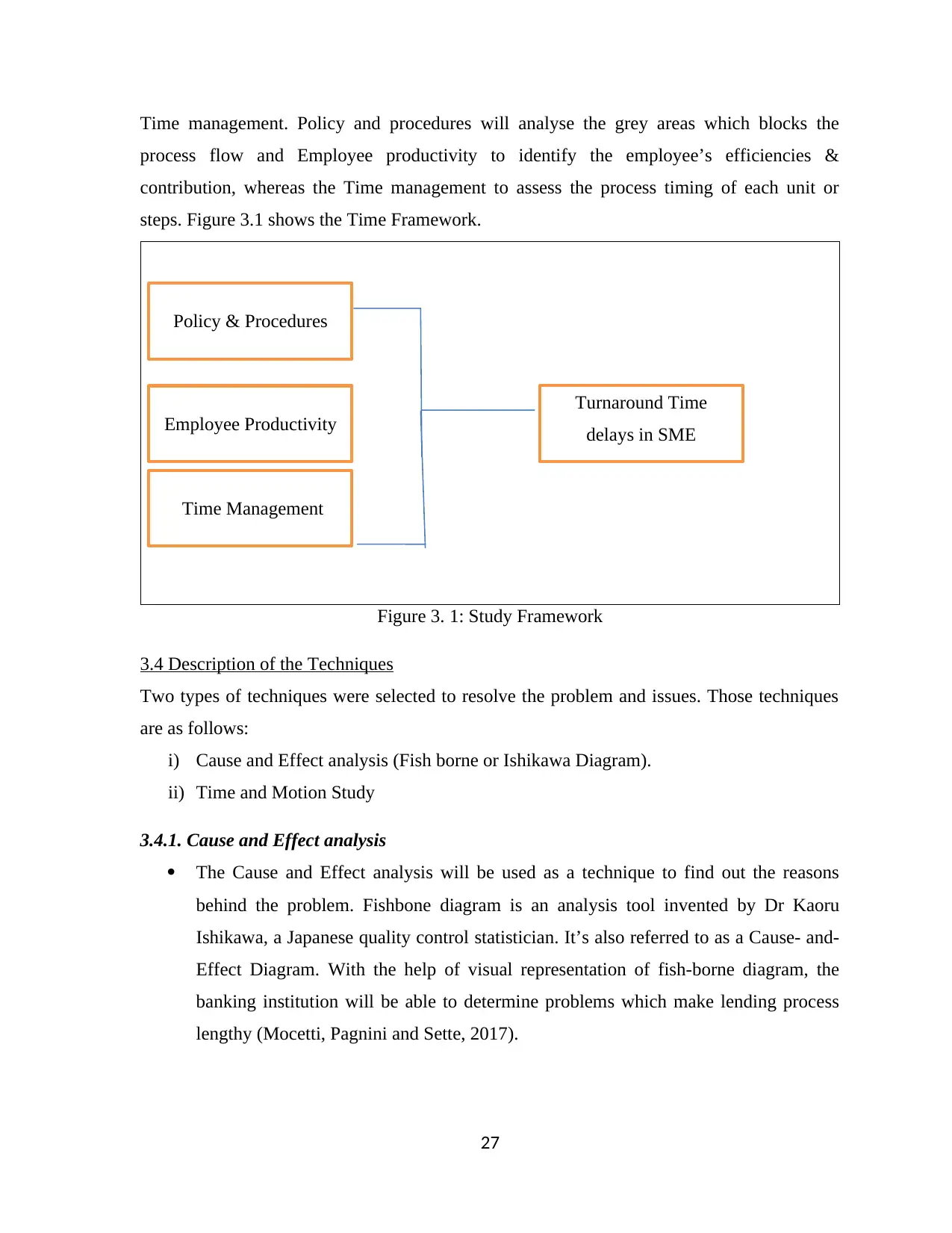
Time management. Policy and procedures will analyse the grey areas which blocks the
process flow and Employee productivity to identify the employee’s efficiencies &
contribution, whereas the Time management to assess the process timing of each unit or
steps. Figure 3.1 shows the Time Framework.
Figure 3. 1: Study Framework
3.4 Description of the Techniques
Two types of techniques were selected to resolve the problem and issues. Those techniques
are as follows:
i) Cause and Effect analysis (Fish borne or Ishikawa Diagram).
ii) Time and Motion Study
3.4.1. Cause and Effect analysis
The Cause and Effect analysis will be used as a technique to find out the reasons
behind the problem. Fishbone diagram is an analysis tool invented by Dr Kaoru
Ishikawa, a Japanese quality control statistician. It’s also referred to as a Cause- and-
Effect Diagram. With the help of visual representation of fish-borne diagram, the
banking institution will be able to determine problems which make lending process
lengthy (Mocetti, Pagnini and Sette, 2017).
27
Policy & Procedures
Time Management
Turnaround Time
delays in SME
operational Model
Employee Productivity
process flow and Employee productivity to identify the employee’s efficiencies &
contribution, whereas the Time management to assess the process timing of each unit or
steps. Figure 3.1 shows the Time Framework.
Figure 3. 1: Study Framework
3.4 Description of the Techniques
Two types of techniques were selected to resolve the problem and issues. Those techniques
are as follows:
i) Cause and Effect analysis (Fish borne or Ishikawa Diagram).
ii) Time and Motion Study
3.4.1. Cause and Effect analysis
The Cause and Effect analysis will be used as a technique to find out the reasons
behind the problem. Fishbone diagram is an analysis tool invented by Dr Kaoru
Ishikawa, a Japanese quality control statistician. It’s also referred to as a Cause- and-
Effect Diagram. With the help of visual representation of fish-borne diagram, the
banking institution will be able to determine problems which make lending process
lengthy (Mocetti, Pagnini and Sette, 2017).
27
Policy & Procedures
Time Management
Turnaround Time
delays in SME
operational Model
Employee Productivity
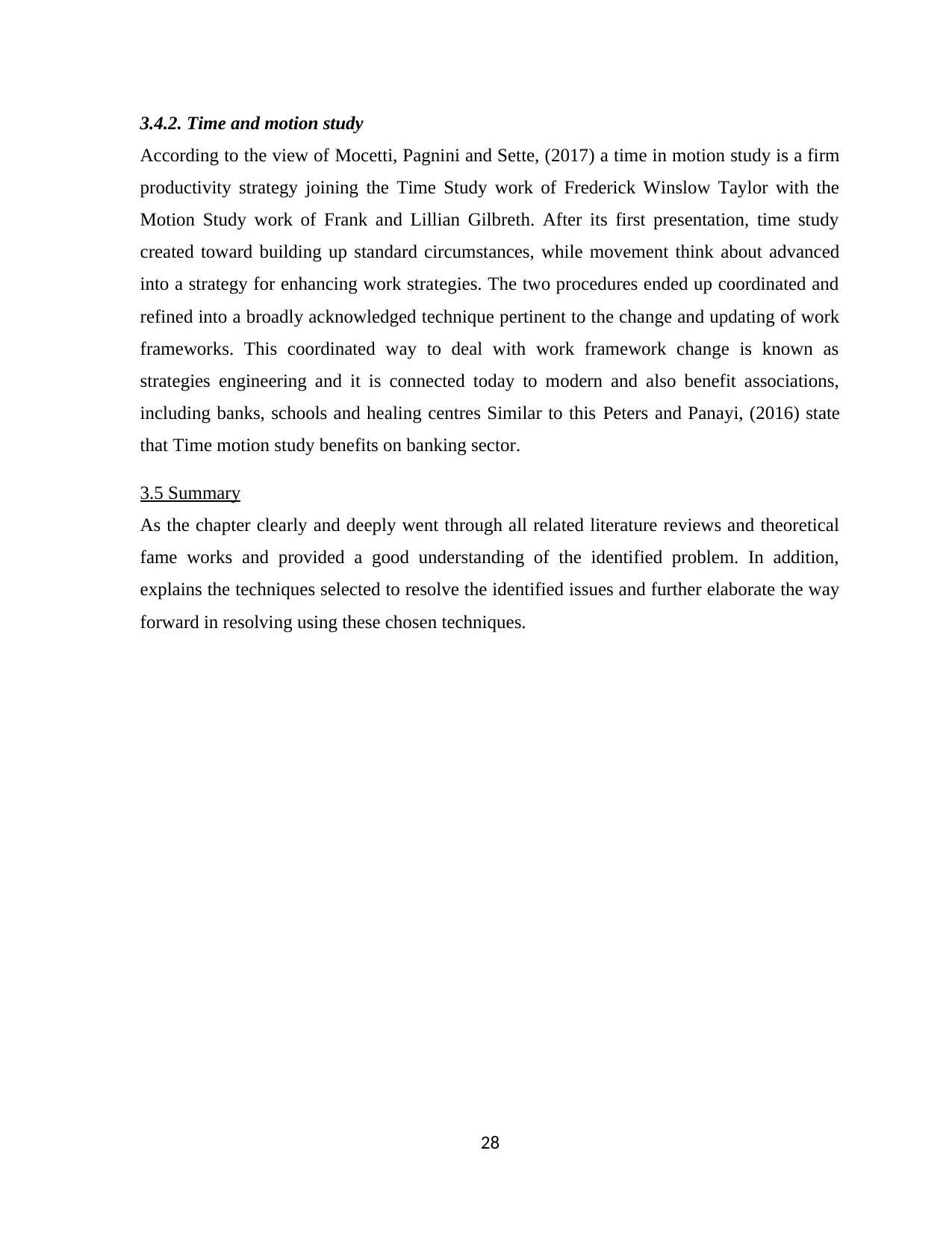
3.4.2. Time and motion study
According to the view of Mocetti, Pagnini and Sette, (2017) a time in motion study is a firm
productivity strategy joining the Time Study work of Frederick Winslow Taylor with the
Motion Study work of Frank and Lillian Gilbreth. After its first presentation, time study
created toward building up standard circumstances, while movement think about advanced
into a strategy for enhancing work strategies. The two procedures ended up coordinated and
refined into a broadly acknowledged technique pertinent to the change and updating of work
frameworks. This coordinated way to deal with work framework change is known as
strategies engineering and it is connected today to modern and also benefit associations,
including banks, schools and healing centres Similar to this Peters and Panayi, (2016) state
that Time motion study benefits on banking sector.
3.5 Summary
As the chapter clearly and deeply went through all related literature reviews and theoretical
fame works and provided a good understanding of the identified problem. In addition,
explains the techniques selected to resolve the identified issues and further elaborate the way
forward in resolving using these chosen techniques.
28
According to the view of Mocetti, Pagnini and Sette, (2017) a time in motion study is a firm
productivity strategy joining the Time Study work of Frederick Winslow Taylor with the
Motion Study work of Frank and Lillian Gilbreth. After its first presentation, time study
created toward building up standard circumstances, while movement think about advanced
into a strategy for enhancing work strategies. The two procedures ended up coordinated and
refined into a broadly acknowledged technique pertinent to the change and updating of work
frameworks. This coordinated way to deal with work framework change is known as
strategies engineering and it is connected today to modern and also benefit associations,
including banks, schools and healing centres Similar to this Peters and Panayi, (2016) state
that Time motion study benefits on banking sector.
3.5 Summary
As the chapter clearly and deeply went through all related literature reviews and theoretical
fame works and provided a good understanding of the identified problem. In addition,
explains the techniques selected to resolve the identified issues and further elaborate the way
forward in resolving using these chosen techniques.
28
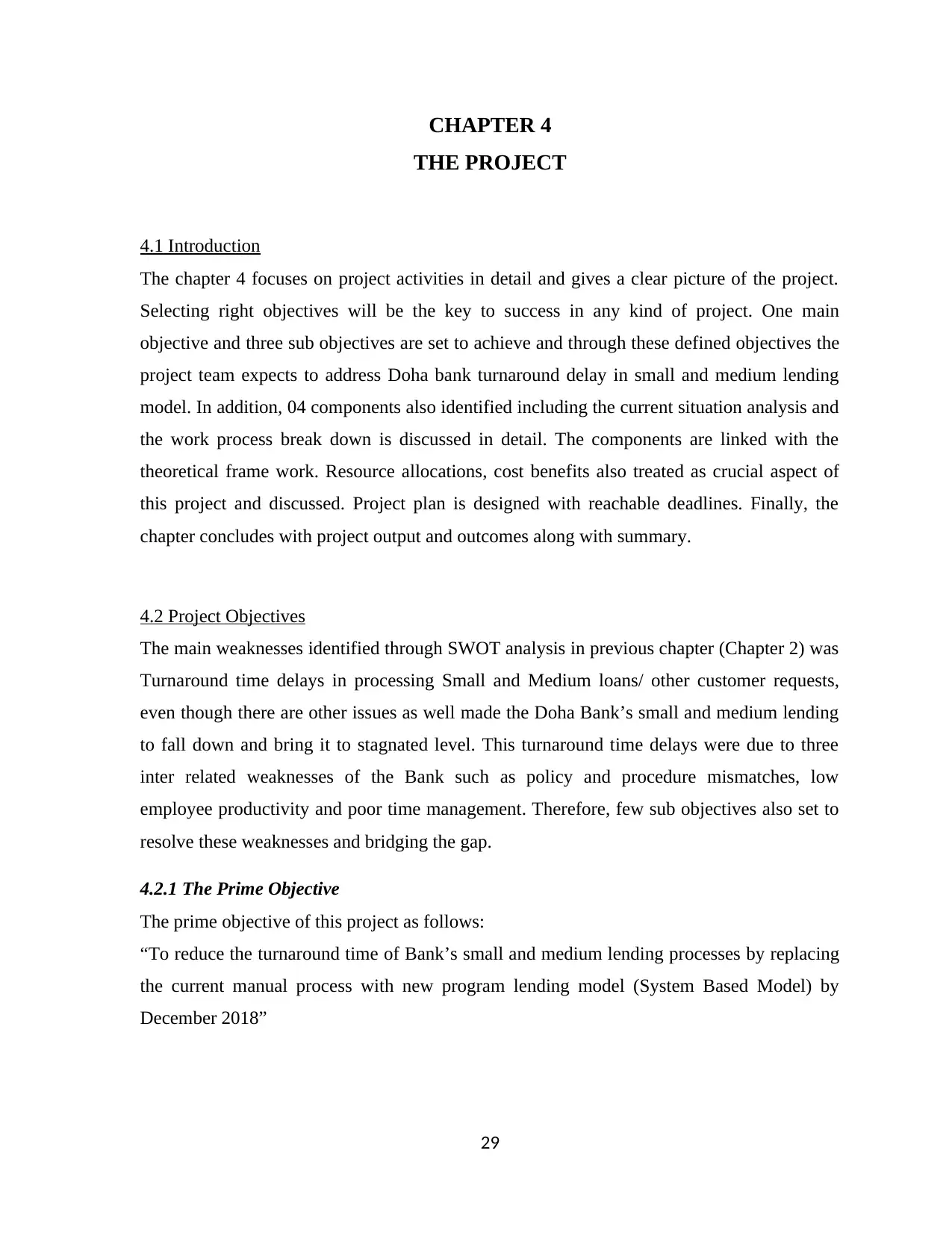
CHAPTER 4
THE PROJECT
4.1 Introduction
The chapter 4 focuses on project activities in detail and gives a clear picture of the project.
Selecting right objectives will be the key to success in any kind of project. One main
objective and three sub objectives are set to achieve and through these defined objectives the
project team expects to address Doha bank turnaround delay in small and medium lending
model. In addition, 04 components also identified including the current situation analysis and
the work process break down is discussed in detail. The components are linked with the
theoretical frame work. Resource allocations, cost benefits also treated as crucial aspect of
this project and discussed. Project plan is designed with reachable deadlines. Finally, the
chapter concludes with project output and outcomes along with summary.
4.2 Project Objectives
The main weaknesses identified through SWOT analysis in previous chapter (Chapter 2) was
Turnaround time delays in processing Small and Medium loans/ other customer requests,
even though there are other issues as well made the Doha Bank’s small and medium lending
to fall down and bring it to stagnated level. This turnaround time delays were due to three
inter related weaknesses of the Bank such as policy and procedure mismatches, low
employee productivity and poor time management. Therefore, few sub objectives also set to
resolve these weaknesses and bridging the gap.
4.2.1 The Prime Objective
The prime objective of this project as follows:
“To reduce the turnaround time of Bank’s small and medium lending processes by replacing
the current manual process with new program lending model (System Based Model) by
December 2018”
29
THE PROJECT
4.1 Introduction
The chapter 4 focuses on project activities in detail and gives a clear picture of the project.
Selecting right objectives will be the key to success in any kind of project. One main
objective and three sub objectives are set to achieve and through these defined objectives the
project team expects to address Doha bank turnaround delay in small and medium lending
model. In addition, 04 components also identified including the current situation analysis and
the work process break down is discussed in detail. The components are linked with the
theoretical frame work. Resource allocations, cost benefits also treated as crucial aspect of
this project and discussed. Project plan is designed with reachable deadlines. Finally, the
chapter concludes with project output and outcomes along with summary.
4.2 Project Objectives
The main weaknesses identified through SWOT analysis in previous chapter (Chapter 2) was
Turnaround time delays in processing Small and Medium loans/ other customer requests,
even though there are other issues as well made the Doha Bank’s small and medium lending
to fall down and bring it to stagnated level. This turnaround time delays were due to three
inter related weaknesses of the Bank such as policy and procedure mismatches, low
employee productivity and poor time management. Therefore, few sub objectives also set to
resolve these weaknesses and bridging the gap.
4.2.1 The Prime Objective
The prime objective of this project as follows:
“To reduce the turnaround time of Bank’s small and medium lending processes by replacing
the current manual process with new program lending model (System Based Model) by
December 2018”
29
Paraphrase This Document
Need a fresh take? Get an instant paraphrase of this document with our AI Paraphraser
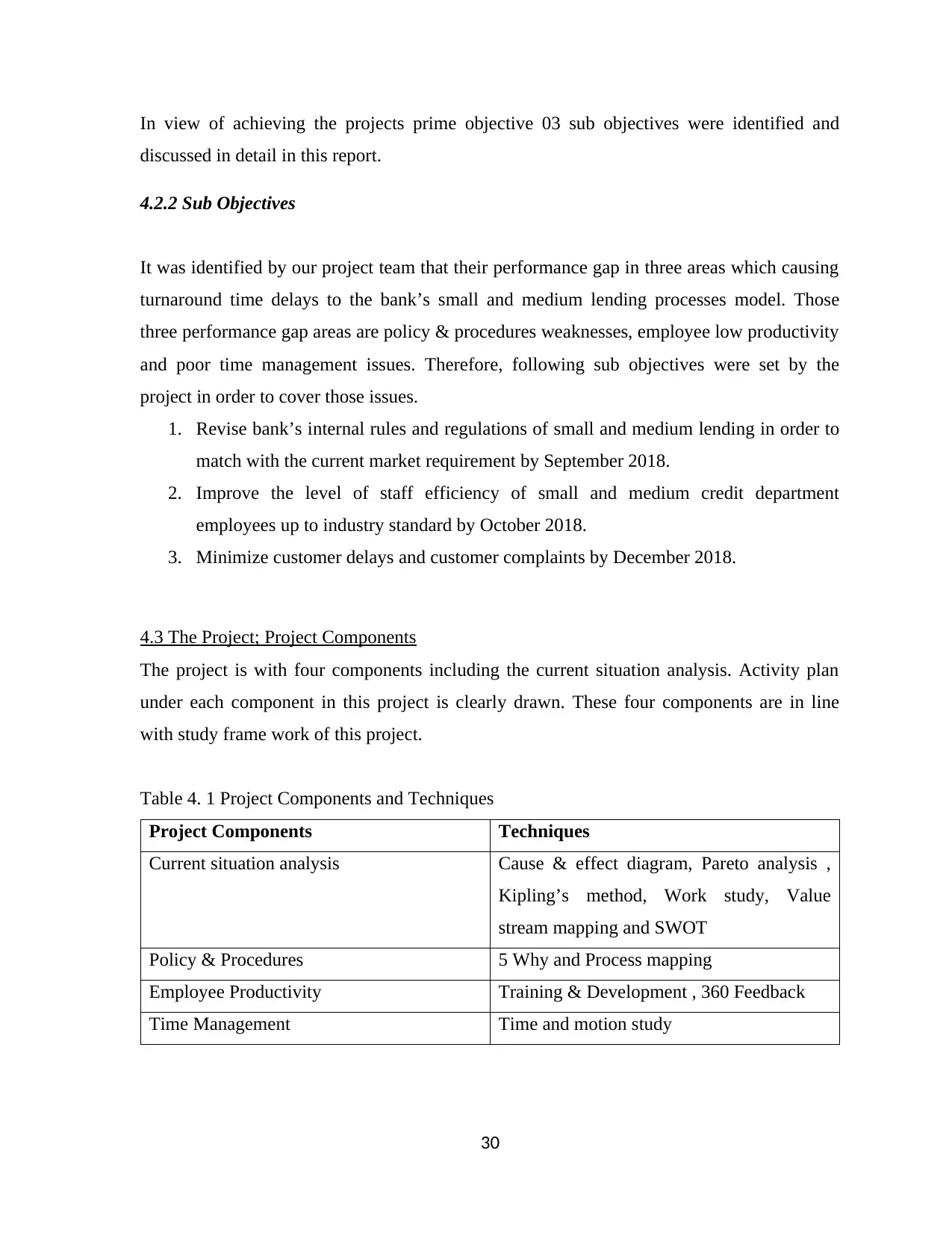
In view of achieving the projects prime objective 03 sub objectives were identified and
discussed in detail in this report.
4.2.2 Sub Objectives
It was identified by our project team that their performance gap in three areas which causing
turnaround time delays to the bank’s small and medium lending processes model. Those
three performance gap areas are policy & procedures weaknesses, employee low productivity
and poor time management issues. Therefore, following sub objectives were set by the
project in order to cover those issues.
1. Revise bank’s internal rules and regulations of small and medium lending in order to
match with the current market requirement by September 2018.
2. Improve the level of staff efficiency of small and medium credit department
employees up to industry standard by October 2018.
3. Minimize customer delays and customer complaints by December 2018.
4.3 The Project; Project Components
The project is with four components including the current situation analysis. Activity plan
under each component in this project is clearly drawn. These four components are in line
with study frame work of this project.
Table 4. 1 Project Components and Techniques
Project Components Techniques
Current situation analysis Cause & effect diagram, Pareto analysis ,
Kipling’s method, Work study, Value
stream mapping and SWOT
Policy & Procedures 5 Why and Process mapping
Employee Productivity Training & Development , 360 Feedback
Time Management Time and motion study
30
discussed in detail in this report.
4.2.2 Sub Objectives
It was identified by our project team that their performance gap in three areas which causing
turnaround time delays to the bank’s small and medium lending processes model. Those
three performance gap areas are policy & procedures weaknesses, employee low productivity
and poor time management issues. Therefore, following sub objectives were set by the
project in order to cover those issues.
1. Revise bank’s internal rules and regulations of small and medium lending in order to
match with the current market requirement by September 2018.
2. Improve the level of staff efficiency of small and medium credit department
employees up to industry standard by October 2018.
3. Minimize customer delays and customer complaints by December 2018.
4.3 The Project; Project Components
The project is with four components including the current situation analysis. Activity plan
under each component in this project is clearly drawn. These four components are in line
with study frame work of this project.
Table 4. 1 Project Components and Techniques
Project Components Techniques
Current situation analysis Cause & effect diagram, Pareto analysis ,
Kipling’s method, Work study, Value
stream mapping and SWOT
Policy & Procedures 5 Why and Process mapping
Employee Productivity Training & Development , 360 Feedback
Time Management Time and motion study
30
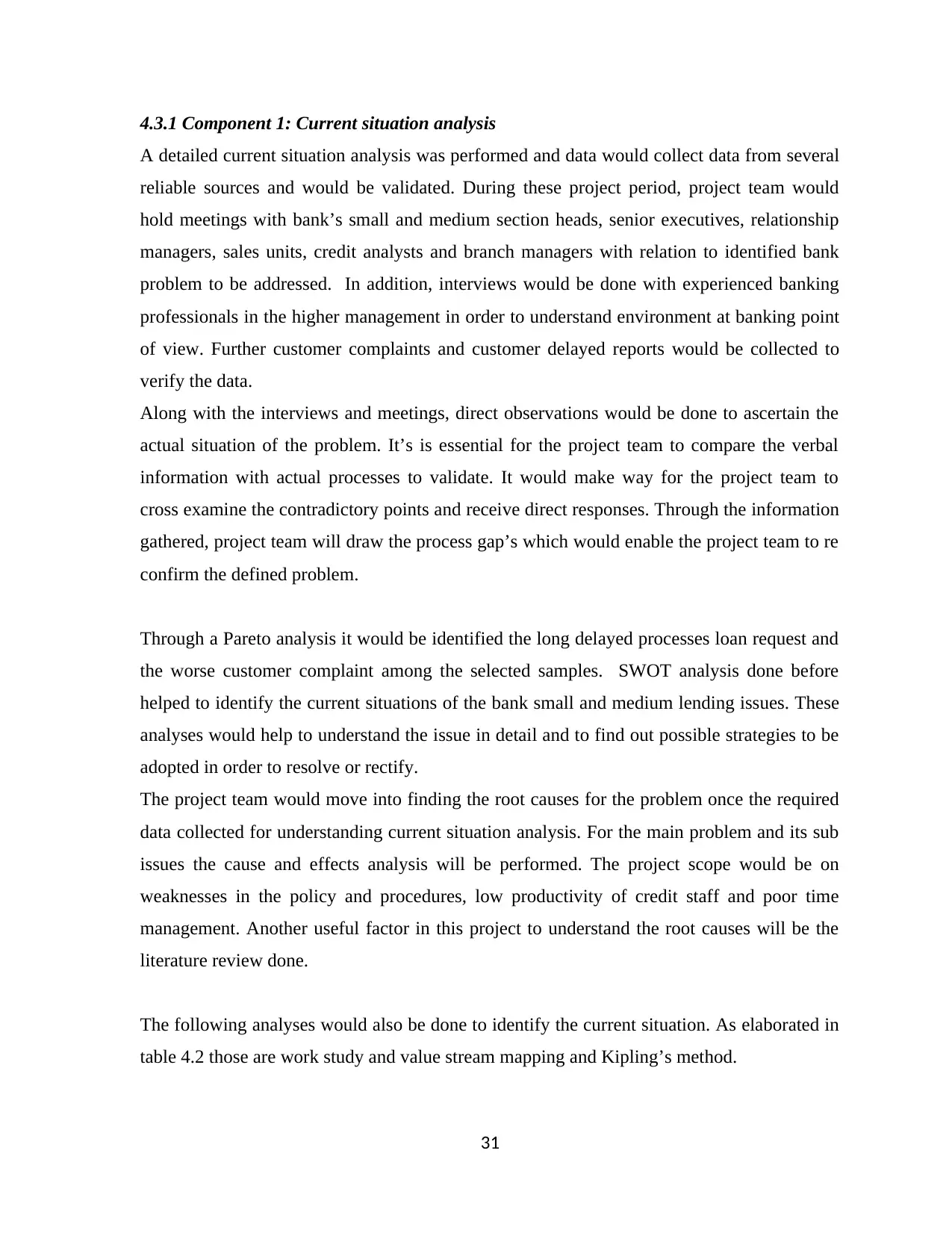
4.3.1 Component 1: Current situation analysis
A detailed current situation analysis was performed and data would collect data from several
reliable sources and would be validated. During these project period, project team would
hold meetings with bank’s small and medium section heads, senior executives, relationship
managers, sales units, credit analysts and branch managers with relation to identified bank
problem to be addressed. In addition, interviews would be done with experienced banking
professionals in the higher management in order to understand environment at banking point
of view. Further customer complaints and customer delayed reports would be collected to
verify the data.
Along with the interviews and meetings, direct observations would be done to ascertain the
actual situation of the problem. It’s is essential for the project team to compare the verbal
information with actual processes to validate. It would make way for the project team to
cross examine the contradictory points and receive direct responses. Through the information
gathered, project team will draw the process gap’s which would enable the project team to re
confirm the defined problem.
Through a Pareto analysis it would be identified the long delayed processes loan request and
the worse customer complaint among the selected samples. SWOT analysis done before
helped to identify the current situations of the bank small and medium lending issues. These
analyses would help to understand the issue in detail and to find out possible strategies to be
adopted in order to resolve or rectify.
The project team would move into finding the root causes for the problem once the required
data collected for understanding current situation analysis. For the main problem and its sub
issues the cause and effects analysis will be performed. The project scope would be on
weaknesses in the policy and procedures, low productivity of credit staff and poor time
management. Another useful factor in this project to understand the root causes will be the
literature review done.
The following analyses would also be done to identify the current situation. As elaborated in
table 4.2 those are work study and value stream mapping and Kipling’s method.
31
A detailed current situation analysis was performed and data would collect data from several
reliable sources and would be validated. During these project period, project team would
hold meetings with bank’s small and medium section heads, senior executives, relationship
managers, sales units, credit analysts and branch managers with relation to identified bank
problem to be addressed. In addition, interviews would be done with experienced banking
professionals in the higher management in order to understand environment at banking point
of view. Further customer complaints and customer delayed reports would be collected to
verify the data.
Along with the interviews and meetings, direct observations would be done to ascertain the
actual situation of the problem. It’s is essential for the project team to compare the verbal
information with actual processes to validate. It would make way for the project team to
cross examine the contradictory points and receive direct responses. Through the information
gathered, project team will draw the process gap’s which would enable the project team to re
confirm the defined problem.
Through a Pareto analysis it would be identified the long delayed processes loan request and
the worse customer complaint among the selected samples. SWOT analysis done before
helped to identify the current situations of the bank small and medium lending issues. These
analyses would help to understand the issue in detail and to find out possible strategies to be
adopted in order to resolve or rectify.
The project team would move into finding the root causes for the problem once the required
data collected for understanding current situation analysis. For the main problem and its sub
issues the cause and effects analysis will be performed. The project scope would be on
weaknesses in the policy and procedures, low productivity of credit staff and poor time
management. Another useful factor in this project to understand the root causes will be the
literature review done.
The following analyses would also be done to identify the current situation. As elaborated in
table 4.2 those are work study and value stream mapping and Kipling’s method.
31
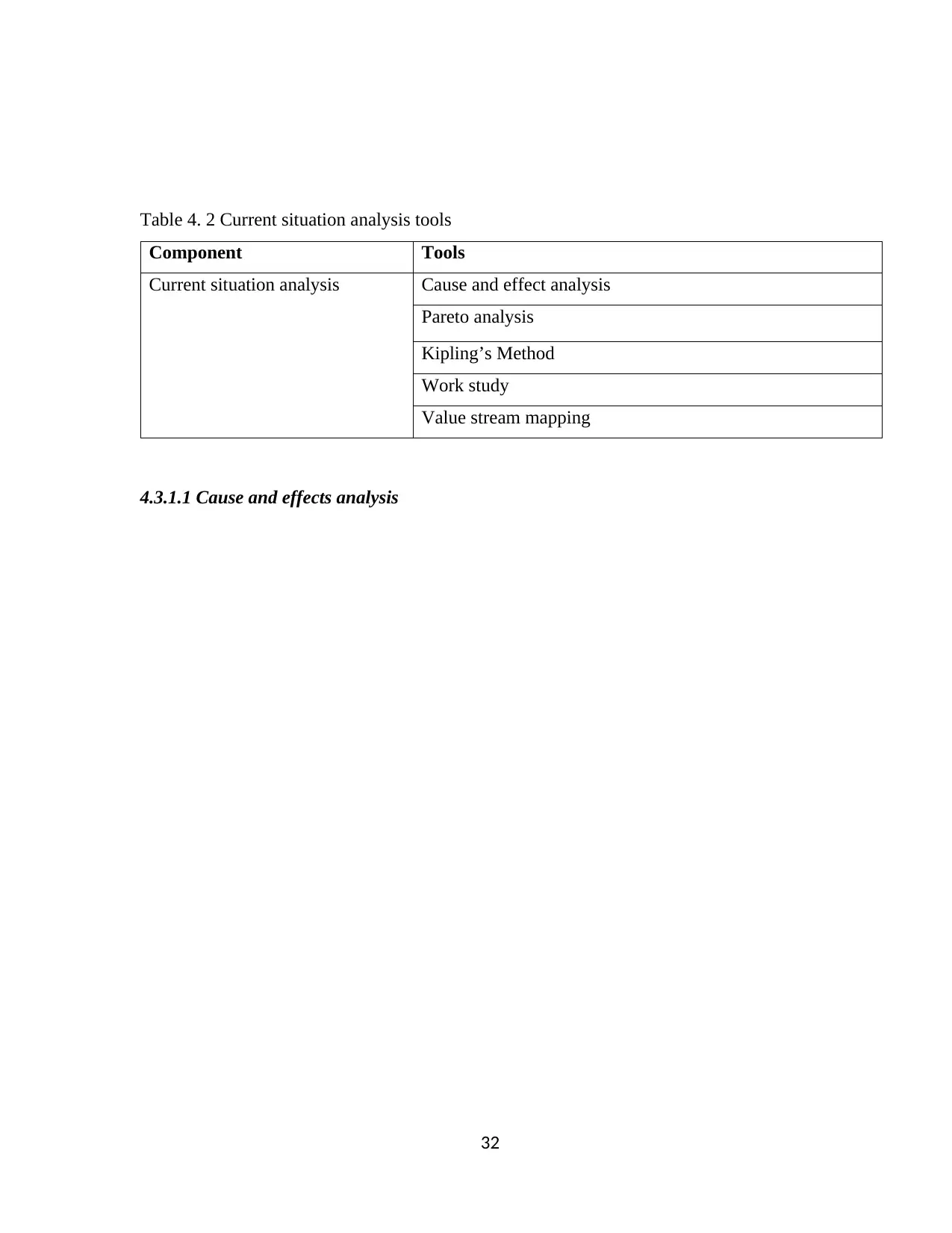
Table 4. 2 Current situation analysis tools
Component Tools
Current situation analysis Cause and effect analysis
Pareto analysis
Kipling’s Method
Work study
Value stream mapping
4.3.1.1 Cause and effects analysis
32
Component Tools
Current situation analysis Cause and effect analysis
Pareto analysis
Kipling’s Method
Work study
Value stream mapping
4.3.1.1 Cause and effects analysis
32
Secure Best Marks with AI Grader
Need help grading? Try our AI Grader for instant feedback on your assignments.
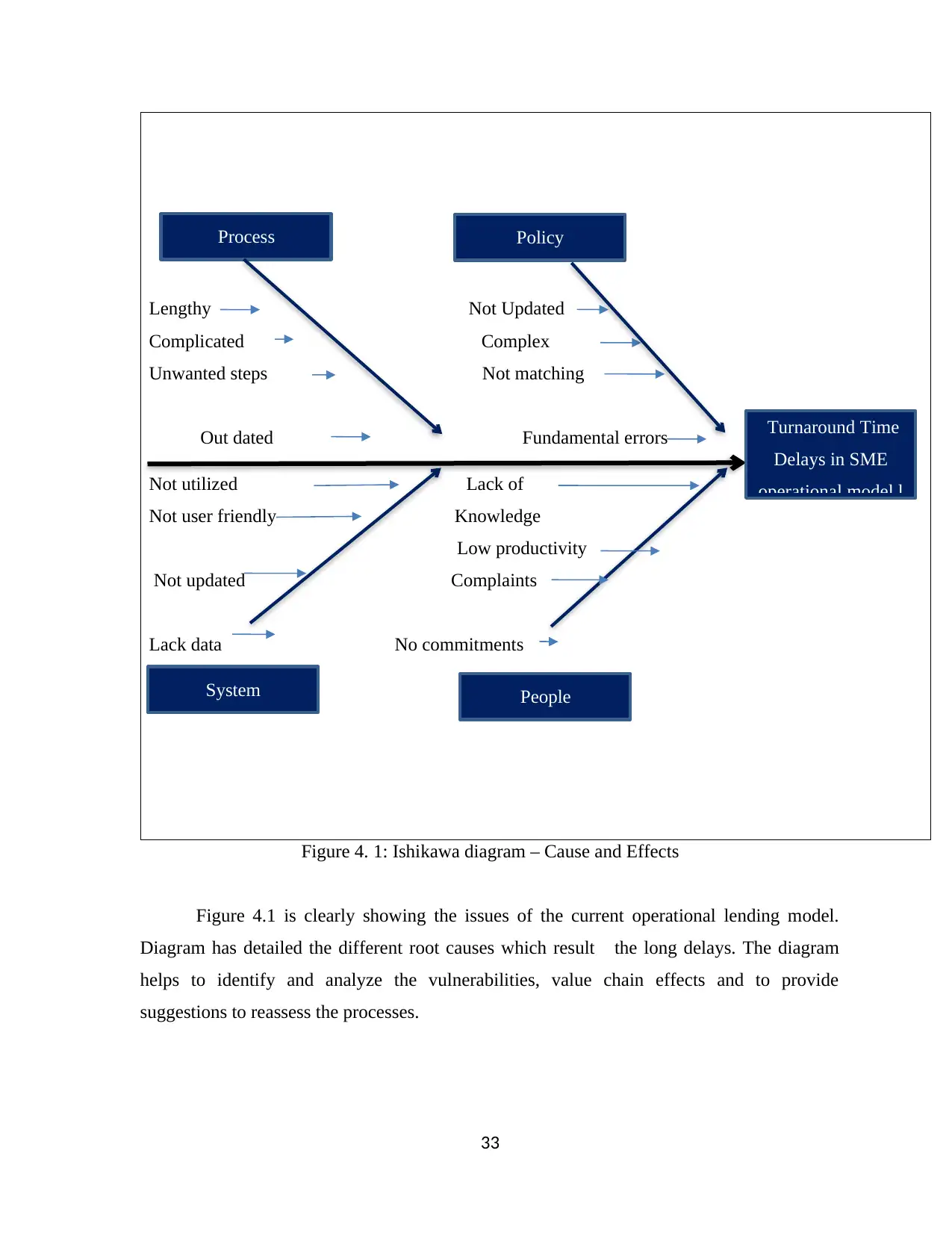
Lengthy Not Updated
Complicated Complex
Unwanted steps Not matching
Out dated Fundamental errors
Not utilized Lack of s
Not user friendly Knowledge
Low productivity
Not updated Complaints
Lack data No commitments
Figure 4. 1: Ishikawa diagram – Cause and Effects
Figure 4.1 is clearly showing the issues of the current operational lending model.
Diagram has detailed the different root causes which result the long delays. The diagram
helps to identify and analyze the vulnerabilities, value chain effects and to provide
suggestions to reassess the processes.
33
Process Policy
Turnaround Time
Delays in SME
operational model l
System People
Complicated Complex
Unwanted steps Not matching
Out dated Fundamental errors
Not utilized Lack of s
Not user friendly Knowledge
Low productivity
Not updated Complaints
Lack data No commitments
Figure 4. 1: Ishikawa diagram – Cause and Effects
Figure 4.1 is clearly showing the issues of the current operational lending model.
Diagram has detailed the different root causes which result the long delays. The diagram
helps to identify and analyze the vulnerabilities, value chain effects and to provide
suggestions to reassess the processes.
33
Process Policy
Turnaround Time
Delays in SME
operational model l
System People

4.3.1.2 Kipling’s Method
The following out comes were recorded through Kipling method analysis. Table 4.3
describes the outcomes.
Table 4. 3: Kipling’s Method
Kipling’s Method
What is the problem? Long Delay in loan process
When does it
happening?
All the time of processing loan request.
Where is it happening? In SME loan department of Doha Bank
Why is it happening? Lengthy processes, strict policies and procedures of bank, time
consuming activities like those of documentation, employees
are not productive.
Who do you need to get
involved?
The entire upstream from the inbound officers like SCM, sales
and finance and loan department, IT department
How can you overcome
this problem?
By reinvent the operational model and developing a system
based processes which will be helping company to reduce their
work and operations.
4.3.1.3 Value stream mapping
The value stream map would be drawn via studying the steps of the loan request process. The
total 9 to 10 step process of small and medium lending model is examined. Those are from
collecting point, analyzing, approving stages, documentations and finally the disbursement.
The project team would observe the processes along with time line by making field visits.
Project team would be identifying the non- value adding steps or activities upon completion
of value steam mapping and take necessary steps to eliminate them and stream line the whole
process.
34
The following out comes were recorded through Kipling method analysis. Table 4.3
describes the outcomes.
Table 4. 3: Kipling’s Method
Kipling’s Method
What is the problem? Long Delay in loan process
When does it
happening?
All the time of processing loan request.
Where is it happening? In SME loan department of Doha Bank
Why is it happening? Lengthy processes, strict policies and procedures of bank, time
consuming activities like those of documentation, employees
are not productive.
Who do you need to get
involved?
The entire upstream from the inbound officers like SCM, sales
and finance and loan department, IT department
How can you overcome
this problem?
By reinvent the operational model and developing a system
based processes which will be helping company to reduce their
work and operations.
4.3.1.3 Value stream mapping
The value stream map would be drawn via studying the steps of the loan request process. The
total 9 to 10 step process of small and medium lending model is examined. Those are from
collecting point, analyzing, approving stages, documentations and finally the disbursement.
The project team would observe the processes along with time line by making field visits.
Project team would be identifying the non- value adding steps or activities upon completion
of value steam mapping and take necessary steps to eliminate them and stream line the whole
process.
34
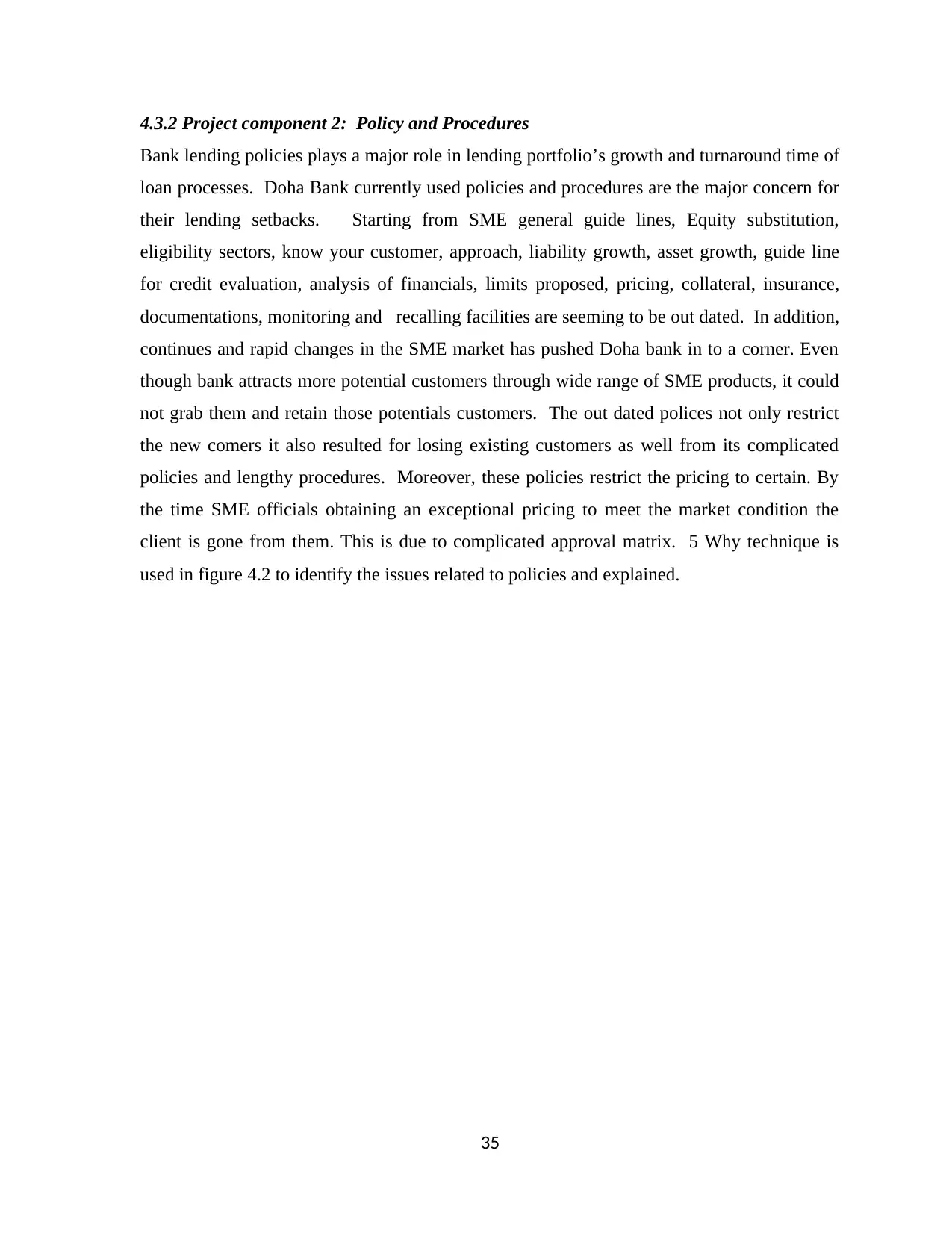
4.3.2 Project component 2: Policy and Procedures
Bank lending policies plays a major role in lending portfolio’s growth and turnaround time of
loan processes. Doha Bank currently used policies and procedures are the major concern for
their lending setbacks. Starting from SME general guide lines, Equity substitution,
eligibility sectors, know your customer, approach, liability growth, asset growth, guide line
for credit evaluation, analysis of financials, limits proposed, pricing, collateral, insurance,
documentations, monitoring and recalling facilities are seeming to be out dated. In addition,
continues and rapid changes in the SME market has pushed Doha bank in to a corner. Even
though bank attracts more potential customers through wide range of SME products, it could
not grab them and retain those potentials customers. The out dated polices not only restrict
the new comers it also resulted for losing existing customers as well from its complicated
policies and lengthy procedures. Moreover, these policies restrict the pricing to certain. By
the time SME officials obtaining an exceptional pricing to meet the market condition the
client is gone from them. This is due to complicated approval matrix. 5 Why technique is
used in figure 4.2 to identify the issues related to policies and explained.
35
Bank lending policies plays a major role in lending portfolio’s growth and turnaround time of
loan processes. Doha Bank currently used policies and procedures are the major concern for
their lending setbacks. Starting from SME general guide lines, Equity substitution,
eligibility sectors, know your customer, approach, liability growth, asset growth, guide line
for credit evaluation, analysis of financials, limits proposed, pricing, collateral, insurance,
documentations, monitoring and recalling facilities are seeming to be out dated. In addition,
continues and rapid changes in the SME market has pushed Doha bank in to a corner. Even
though bank attracts more potential customers through wide range of SME products, it could
not grab them and retain those potentials customers. The out dated polices not only restrict
the new comers it also resulted for losing existing customers as well from its complicated
policies and lengthy procedures. Moreover, these policies restrict the pricing to certain. By
the time SME officials obtaining an exceptional pricing to meet the market condition the
client is gone from them. This is due to complicated approval matrix. 5 Why technique is
used in figure 4.2 to identify the issues related to policies and explained.
35
Paraphrase This Document
Need a fresh take? Get an instant paraphrase of this document with our AI Paraphraser

Figure 4. 2: 5Why’s
The current workflow process in Doha bank’s SME unit is a lengthy one and a loan proposal
has to go through nearly 10 stages to get it formally approved. Once credit proposal is
approved the documentation parts starts and thereafter the disbursement activity to end the
whole cycle of a small and medium loan received by the customer. In general, it takes 4 to 6
36
Problem
Bank SME policies restrict the lending
growth
Why?
Counter Measure
Bank SME polices need to be updated
Policies are not matching the current
SME Lending requirement
Policies written mostly on secured base
lending
These are old policies
Why
?
No periodical review or update not
done
SME polices consist more rules and
regulation
The current workflow process in Doha bank’s SME unit is a lengthy one and a loan proposal
has to go through nearly 10 stages to get it formally approved. Once credit proposal is
approved the documentation parts starts and thereafter the disbursement activity to end the
whole cycle of a small and medium loan received by the customer. In general, it takes 4 to 6
36
Problem
Bank SME policies restrict the lending
growth
Why?
Counter Measure
Bank SME polices need to be updated
Policies are not matching the current
SME Lending requirement
Policies written mostly on secured base
lending
These are old policies
Why
?
No periodical review or update not
done
SME polices consist more rules and
regulation
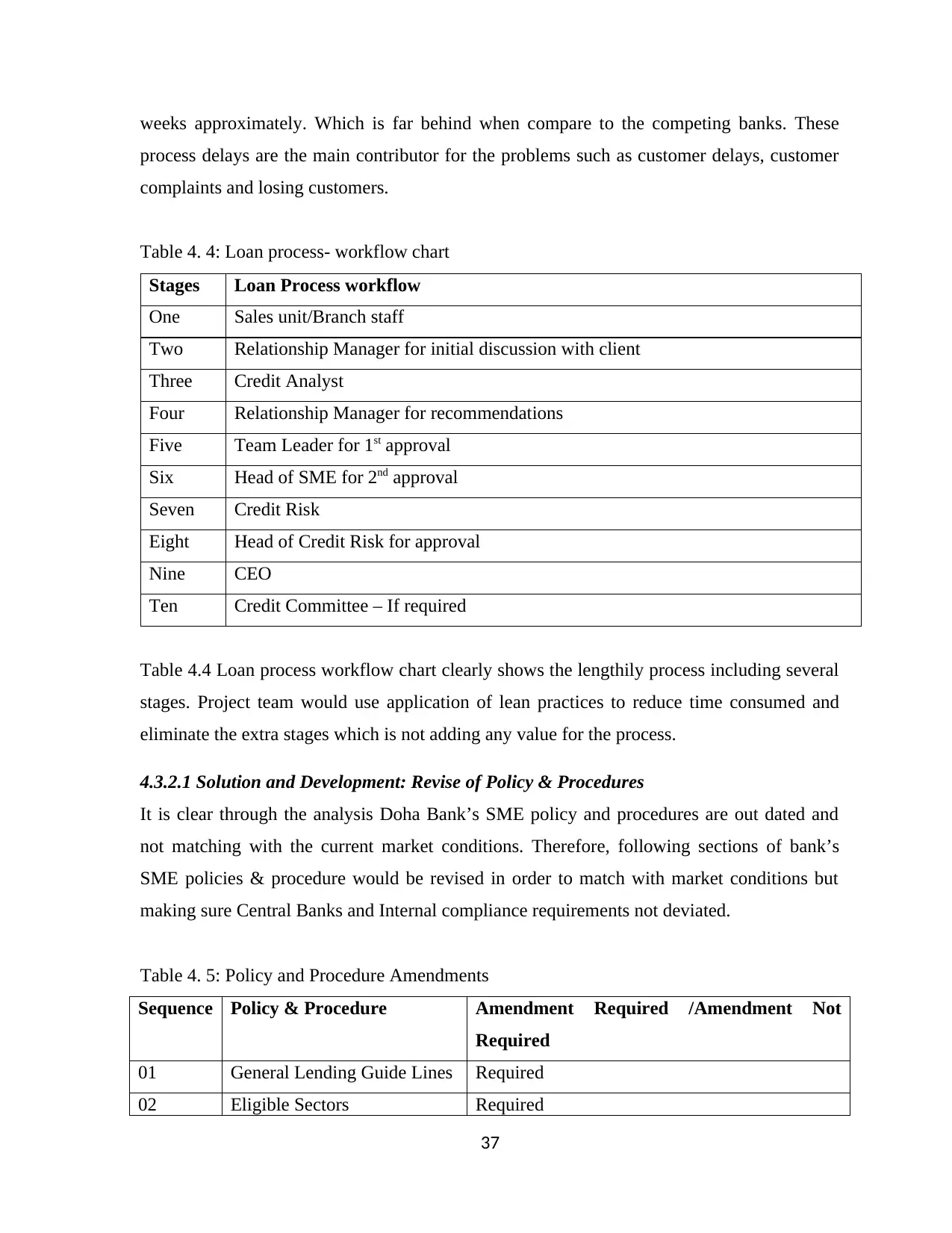
weeks approximately. Which is far behind when compare to the competing banks. These
process delays are the main contributor for the problems such as customer delays, customer
complaints and losing customers.
Table 4. 4: Loan process- workflow chart
Stages Loan Process workflow
One Sales unit/Branch staff
Two Relationship Manager for initial discussion with client
Three Credit Analyst
Four Relationship Manager for recommendations
Five Team Leader for 1st approval
Six Head of SME for 2nd approval
Seven Credit Risk
Eight Head of Credit Risk for approval
Nine CEO
Ten Credit Committee – If required
Table 4.4 Loan process workflow chart clearly shows the lengthily process including several
stages. Project team would use application of lean practices to reduce time consumed and
eliminate the extra stages which is not adding any value for the process.
4.3.2.1 Solution and Development: Revise of Policy & Procedures
It is clear through the analysis Doha Bank’s SME policy and procedures are out dated and
not matching with the current market conditions. Therefore, following sections of bank’s
SME policies & procedure would be revised in order to match with market conditions but
making sure Central Banks and Internal compliance requirements not deviated.
Table 4. 5: Policy and Procedure Amendments
Sequence Policy & Procedure Amendment Required /Amendment Not
Required
01 General Lending Guide Lines Required
02 Eligible Sectors Required
37
process delays are the main contributor for the problems such as customer delays, customer
complaints and losing customers.
Table 4. 4: Loan process- workflow chart
Stages Loan Process workflow
One Sales unit/Branch staff
Two Relationship Manager for initial discussion with client
Three Credit Analyst
Four Relationship Manager for recommendations
Five Team Leader for 1st approval
Six Head of SME for 2nd approval
Seven Credit Risk
Eight Head of Credit Risk for approval
Nine CEO
Ten Credit Committee – If required
Table 4.4 Loan process workflow chart clearly shows the lengthily process including several
stages. Project team would use application of lean practices to reduce time consumed and
eliminate the extra stages which is not adding any value for the process.
4.3.2.1 Solution and Development: Revise of Policy & Procedures
It is clear through the analysis Doha Bank’s SME policy and procedures are out dated and
not matching with the current market conditions. Therefore, following sections of bank’s
SME policies & procedure would be revised in order to match with market conditions but
making sure Central Banks and Internal compliance requirements not deviated.
Table 4. 5: Policy and Procedure Amendments
Sequence Policy & Procedure Amendment Required /Amendment Not
Required
01 General Lending Guide Lines Required
02 Eligible Sectors Required
37
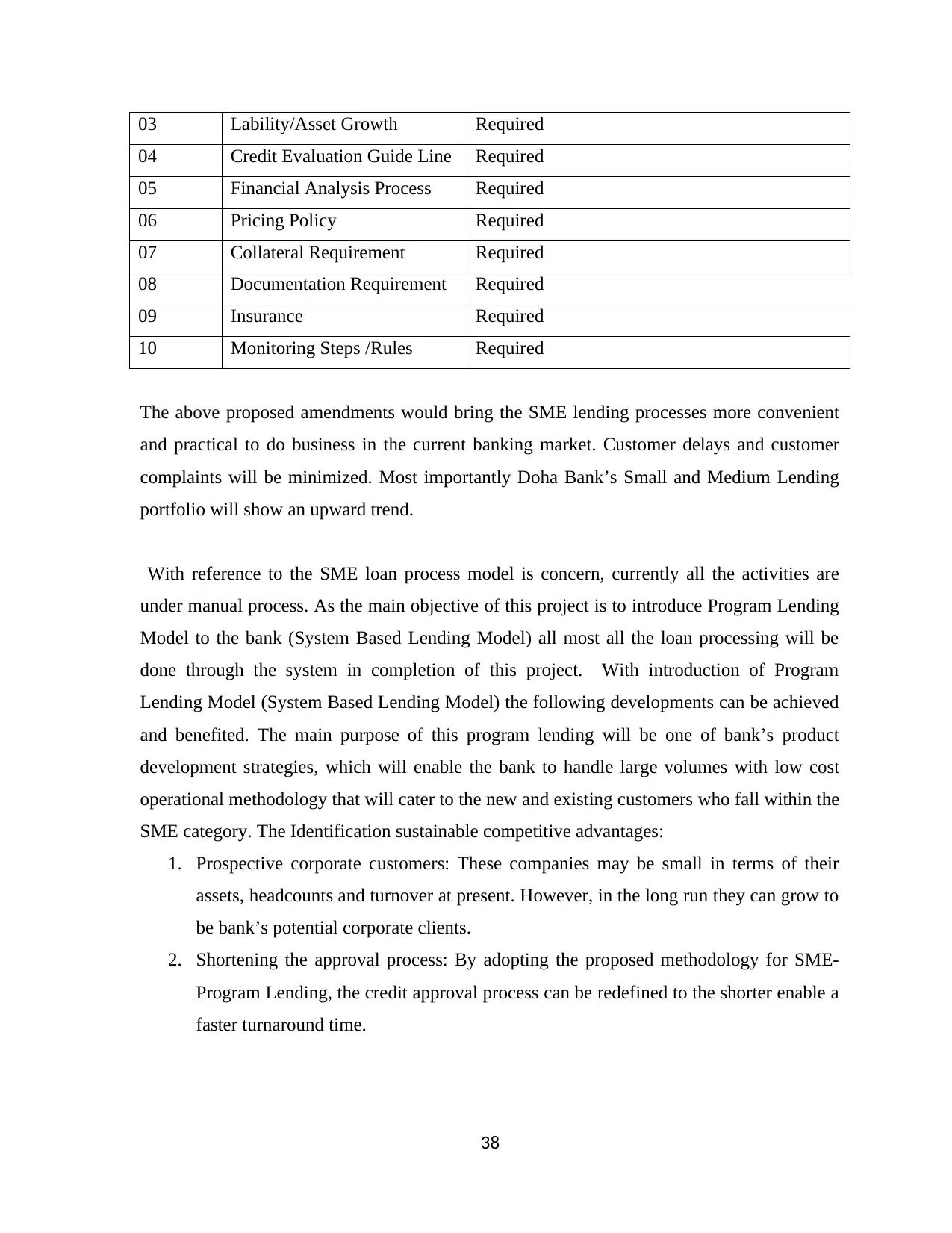
03 Lability/Asset Growth Required
04 Credit Evaluation Guide Line Required
05 Financial Analysis Process Required
06 Pricing Policy Required
07 Collateral Requirement Required
08 Documentation Requirement Required
09 Insurance Required
10 Monitoring Steps /Rules Required
The above proposed amendments would bring the SME lending processes more convenient
and practical to do business in the current banking market. Customer delays and customer
complaints will be minimized. Most importantly Doha Bank’s Small and Medium Lending
portfolio will show an upward trend.
With reference to the SME loan process model is concern, currently all the activities are
under manual process. As the main objective of this project is to introduce Program Lending
Model to the bank (System Based Lending Model) all most all the loan processing will be
done through the system in completion of this project. With introduction of Program
Lending Model (System Based Lending Model) the following developments can be achieved
and benefited. The main purpose of this program lending will be one of bank’s product
development strategies, which will enable the bank to handle large volumes with low cost
operational methodology that will cater to the new and existing customers who fall within the
SME category. The Identification sustainable competitive advantages:
1. Prospective corporate customers: These companies may be small in terms of their
assets, headcounts and turnover at present. However, in the long run they can grow to
be bank’s potential corporate clients.
2. Shortening the approval process: By adopting the proposed methodology for SME-
Program Lending, the credit approval process can be redefined to the shorter enable a
faster turnaround time.
38
04 Credit Evaluation Guide Line Required
05 Financial Analysis Process Required
06 Pricing Policy Required
07 Collateral Requirement Required
08 Documentation Requirement Required
09 Insurance Required
10 Monitoring Steps /Rules Required
The above proposed amendments would bring the SME lending processes more convenient
and practical to do business in the current banking market. Customer delays and customer
complaints will be minimized. Most importantly Doha Bank’s Small and Medium Lending
portfolio will show an upward trend.
With reference to the SME loan process model is concern, currently all the activities are
under manual process. As the main objective of this project is to introduce Program Lending
Model to the bank (System Based Lending Model) all most all the loan processing will be
done through the system in completion of this project. With introduction of Program
Lending Model (System Based Lending Model) the following developments can be achieved
and benefited. The main purpose of this program lending will be one of bank’s product
development strategies, which will enable the bank to handle large volumes with low cost
operational methodology that will cater to the new and existing customers who fall within the
SME category. The Identification sustainable competitive advantages:
1. Prospective corporate customers: These companies may be small in terms of their
assets, headcounts and turnover at present. However, in the long run they can grow to
be bank’s potential corporate clients.
2. Shortening the approval process: By adopting the proposed methodology for SME-
Program Lending, the credit approval process can be redefined to the shorter enable a
faster turnaround time.
38
Secure Best Marks with AI Grader
Need help grading? Try our AI Grader for instant feedback on your assignments.
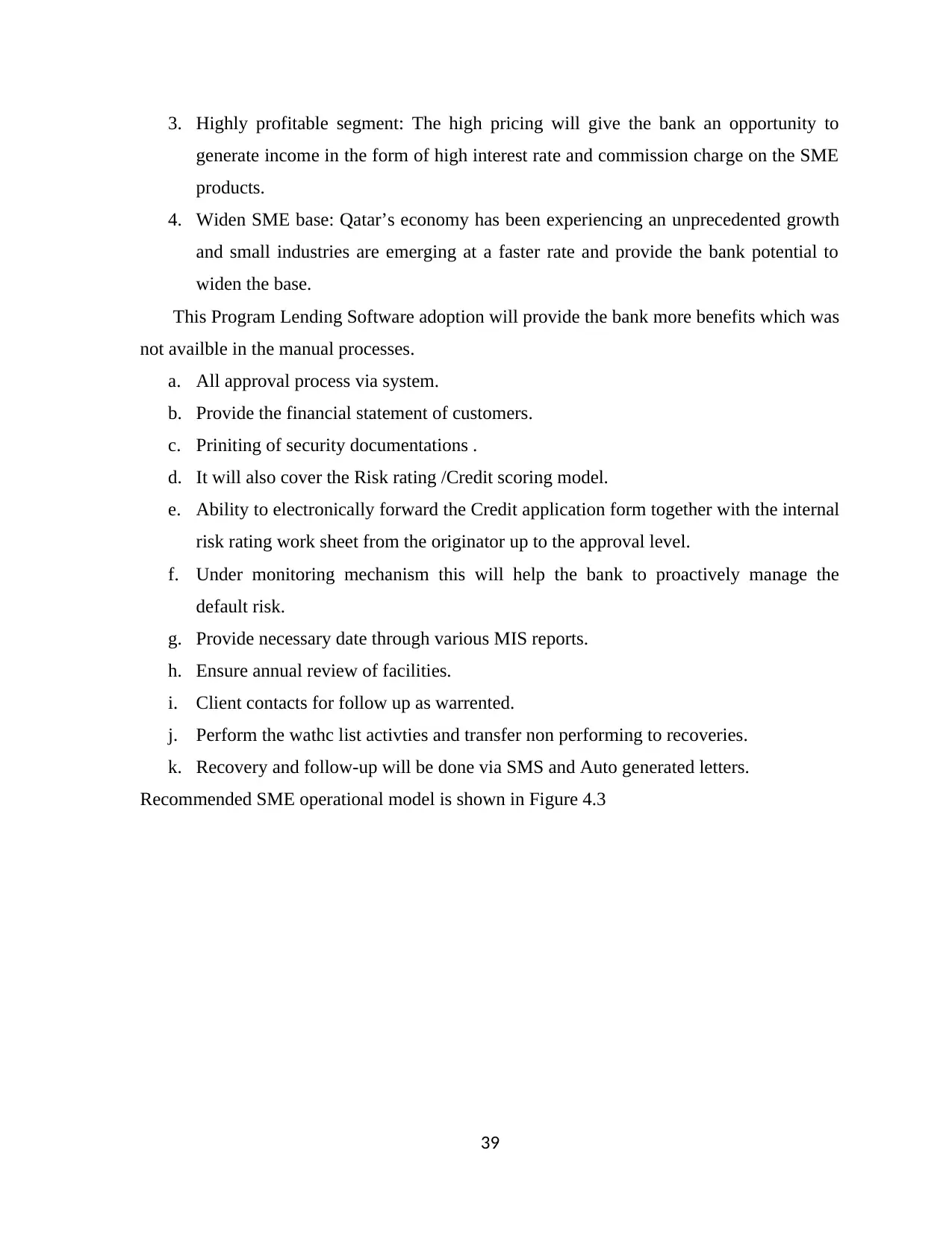
3. Highly profitable segment: The high pricing will give the bank an opportunity to
generate income in the form of high interest rate and commission charge on the SME
products.
4. Widen SME base: Qatar’s economy has been experiencing an unprecedented growth
and small industries are emerging at a faster rate and provide the bank potential to
widen the base.
This Program Lending Software adoption will provide the bank more benefits which was
not availble in the manual processes.
a. All approval process via system.
b. Provide the financial statement of customers.
c. Priniting of security documentations .
d. It will also cover the Risk rating /Credit scoring model.
e. Ability to electronically forward the Credit application form together with the internal
risk rating work sheet from the originator up to the approval level.
f. Under monitoring mechanism this will help the bank to proactively manage the
default risk.
g. Provide necessary date through various MIS reports.
h. Ensure annual review of facilities.
i. Client contacts for follow up as warrented.
j. Perform the wathc list activties and transfer non performing to recoveries.
k. Recovery and follow-up will be done via SMS and Auto generated letters.
Recommended SME operational model is shown in Figure 4.3
39
generate income in the form of high interest rate and commission charge on the SME
products.
4. Widen SME base: Qatar’s economy has been experiencing an unprecedented growth
and small industries are emerging at a faster rate and provide the bank potential to
widen the base.
This Program Lending Software adoption will provide the bank more benefits which was
not availble in the manual processes.
a. All approval process via system.
b. Provide the financial statement of customers.
c. Priniting of security documentations .
d. It will also cover the Risk rating /Credit scoring model.
e. Ability to electronically forward the Credit application form together with the internal
risk rating work sheet from the originator up to the approval level.
f. Under monitoring mechanism this will help the bank to proactively manage the
default risk.
g. Provide necessary date through various MIS reports.
h. Ensure annual review of facilities.
i. Client contacts for follow up as warrented.
j. Perform the wathc list activties and transfer non performing to recoveries.
k. Recovery and follow-up will be done via SMS and Auto generated letters.
Recommended SME operational model is shown in Figure 4.3
39

Market Research Direct Sales Agents Relationship Managers
for data collection
System Based
System Based
40
Cross Sell SME Policy
& Guidelines
Approved / Declined
Credit
Information
Bureau + Qatar
Central Bank
for Credit
SME Credit RISK and Credit Administration
Facility Screening & Approval Process
Facility Monitoring
Documentation Preparation Handling
Credit
Guarantee
Programme
(Al Dhameen)
SME Head Office Desk
Facility Origination (Detailed Credit Assessment) for over QR10M facilities
Use Al Dhameen for Industrial Loans
SME Desk through Branch Network
Facility Origination at Branch Level
PRL Model for SB (revenue up to QR25M) &MB (revenue from QR25M to QR50M)
Lending Cap: QR2.5M for SB & QR5M for MB
Simplified Lending Model for Medium Business for over QR5M
Lending Cap: QR10M
Facilities above QR10M & Industrial Development Financing to be handled by HO Desk
Bank MIS
SME Specific
Product
Creation
Medium
Businesses (MB)
Small Businesses (SB)
Multiple Product
Clients
Small Businesses (SB)
Single Product
Clients
SME Industry
Figure 5: SME Program Lending ModelFigure 4. 3: SME Program Lending Model
for data collection
System Based
System Based
40
Cross Sell SME Policy
& Guidelines
Approved / Declined
Credit
Information
Bureau + Qatar
Central Bank
for Credit
SME Credit RISK and Credit Administration
Facility Screening & Approval Process
Facility Monitoring
Documentation Preparation Handling
Credit
Guarantee
Programme
(Al Dhameen)
SME Head Office Desk
Facility Origination (Detailed Credit Assessment) for over QR10M facilities
Use Al Dhameen for Industrial Loans
SME Desk through Branch Network
Facility Origination at Branch Level
PRL Model for SB (revenue up to QR25M) &MB (revenue from QR25M to QR50M)
Lending Cap: QR2.5M for SB & QR5M for MB
Simplified Lending Model for Medium Business for over QR5M
Lending Cap: QR10M
Facilities above QR10M & Industrial Development Financing to be handled by HO Desk
Bank MIS
SME Specific
Product
Creation
Medium
Businesses (MB)
Small Businesses (SB)
Multiple Product
Clients
Small Businesses (SB)
Single Product
Clients
SME Industry
Figure 5: SME Program Lending ModelFigure 4. 3: SME Program Lending Model
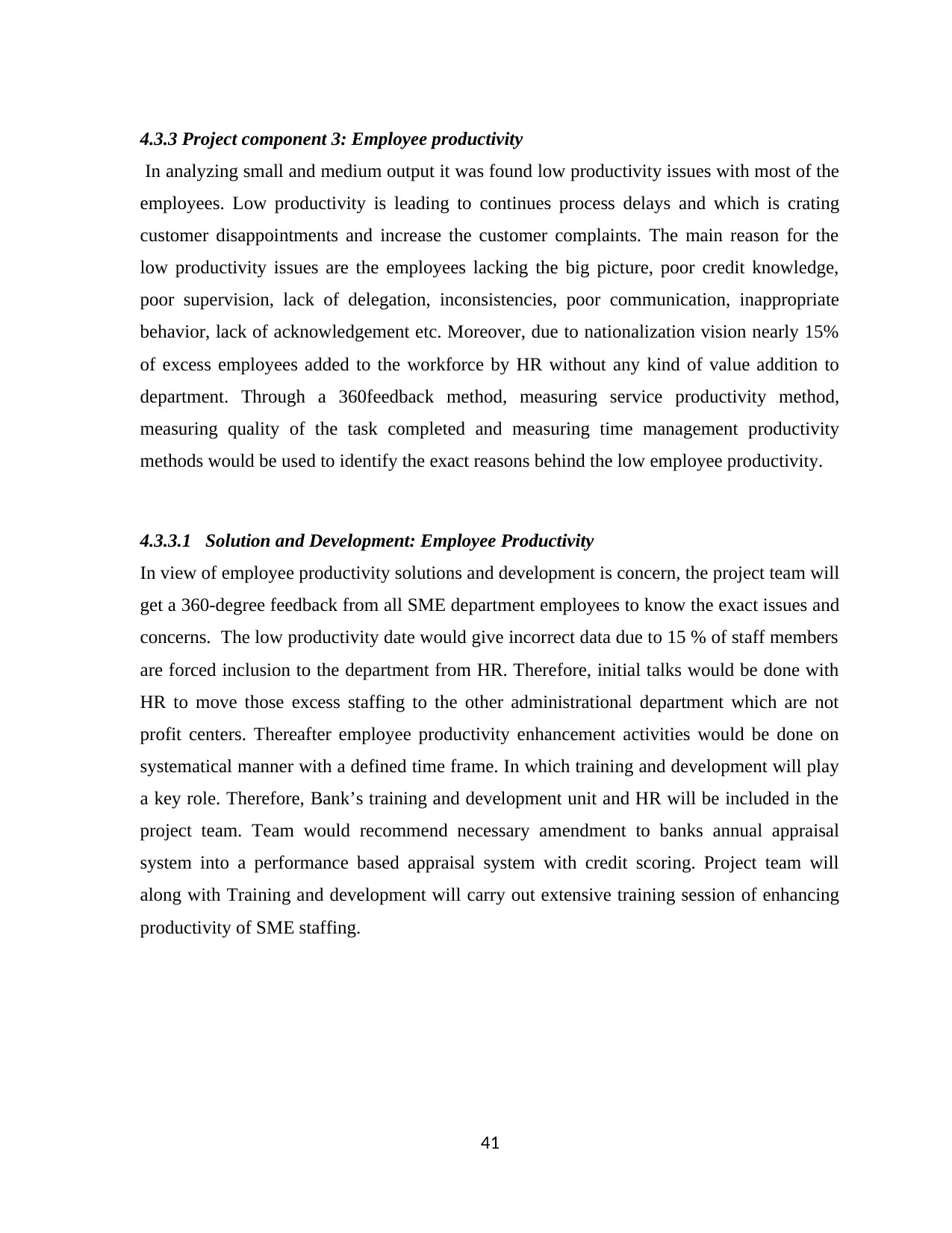
4.3.3 Project component 3: Employee productivity
In analyzing small and medium output it was found low productivity issues with most of the
employees. Low productivity is leading to continues process delays and which is crating
customer disappointments and increase the customer complaints. The main reason for the
low productivity issues are the employees lacking the big picture, poor credit knowledge,
poor supervision, lack of delegation, inconsistencies, poor communication, inappropriate
behavior, lack of acknowledgement etc. Moreover, due to nationalization vision nearly 15%
of excess employees added to the workforce by HR without any kind of value addition to
department. Through a 360feedback method, measuring service productivity method,
measuring quality of the task completed and measuring time management productivity
methods would be used to identify the exact reasons behind the low employee productivity.
4.3.3.1 Solution and Development: Employee Productivity
In view of employee productivity solutions and development is concern, the project team will
get a 360-degree feedback from all SME department employees to know the exact issues and
concerns. The low productivity date would give incorrect data due to 15 % of staff members
are forced inclusion to the department from HR. Therefore, initial talks would be done with
HR to move those excess staffing to the other administrational department which are not
profit centers. Thereafter employee productivity enhancement activities would be done on
systematical manner with a defined time frame. In which training and development will play
a key role. Therefore, Bank’s training and development unit and HR will be included in the
project team. Team would recommend necessary amendment to banks annual appraisal
system into a performance based appraisal system with credit scoring. Project team will
along with Training and development will carry out extensive training session of enhancing
productivity of SME staffing.
41
In analyzing small and medium output it was found low productivity issues with most of the
employees. Low productivity is leading to continues process delays and which is crating
customer disappointments and increase the customer complaints. The main reason for the
low productivity issues are the employees lacking the big picture, poor credit knowledge,
poor supervision, lack of delegation, inconsistencies, poor communication, inappropriate
behavior, lack of acknowledgement etc. Moreover, due to nationalization vision nearly 15%
of excess employees added to the workforce by HR without any kind of value addition to
department. Through a 360feedback method, measuring service productivity method,
measuring quality of the task completed and measuring time management productivity
methods would be used to identify the exact reasons behind the low employee productivity.
4.3.3.1 Solution and Development: Employee Productivity
In view of employee productivity solutions and development is concern, the project team will
get a 360-degree feedback from all SME department employees to know the exact issues and
concerns. The low productivity date would give incorrect data due to 15 % of staff members
are forced inclusion to the department from HR. Therefore, initial talks would be done with
HR to move those excess staffing to the other administrational department which are not
profit centers. Thereafter employee productivity enhancement activities would be done on
systematical manner with a defined time frame. In which training and development will play
a key role. Therefore, Bank’s training and development unit and HR will be included in the
project team. Team would recommend necessary amendment to banks annual appraisal
system into a performance based appraisal system with credit scoring. Project team will
along with Training and development will carry out extensive training session of enhancing
productivity of SME staffing.
41
Paraphrase This Document
Need a fresh take? Get an instant paraphrase of this document with our AI Paraphraser
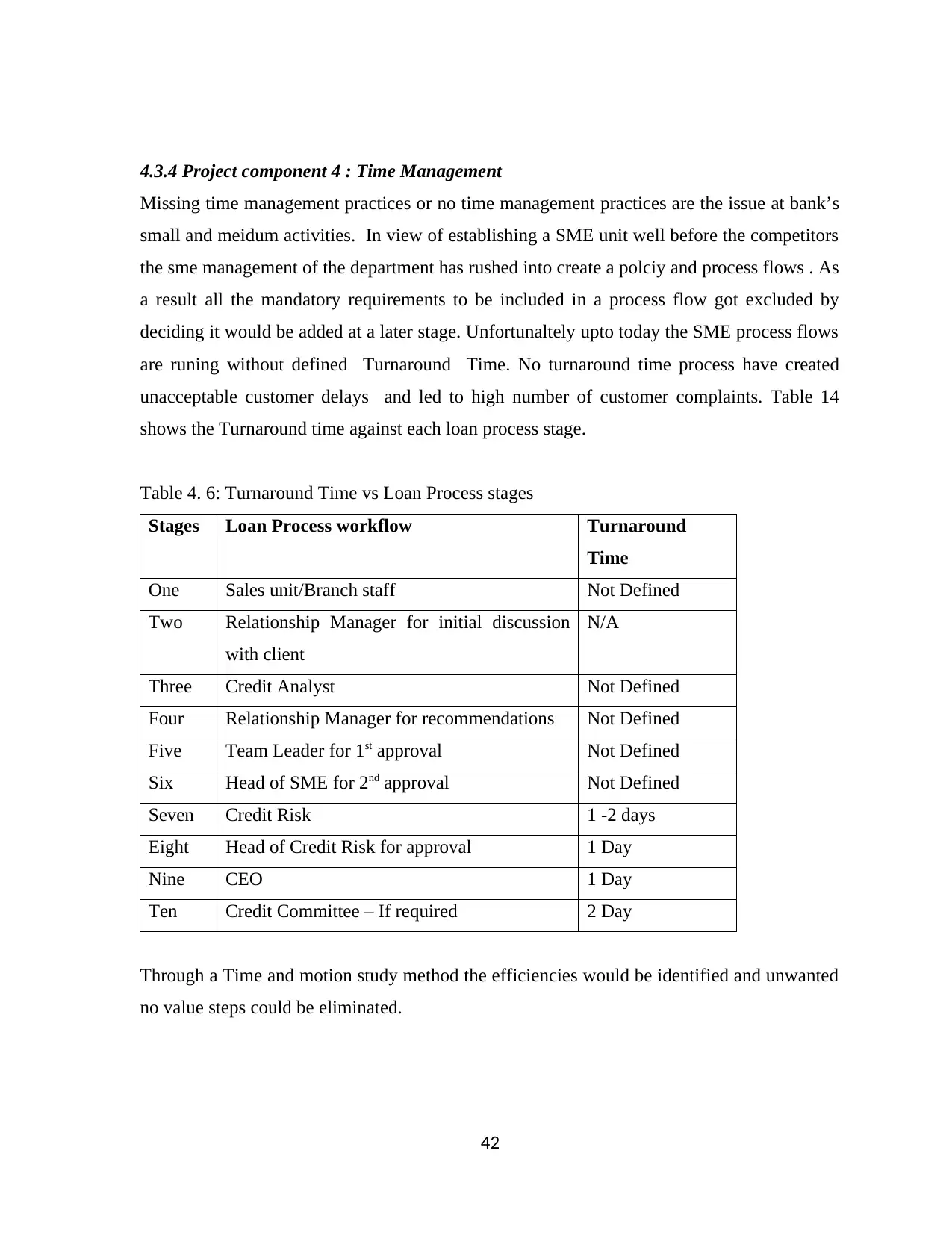
4.3.4 Project component 4 : Time Management
Missing time management practices or no time management practices are the issue at bank’s
small and meidum activities. In view of establishing a SME unit well before the competitors
the sme management of the department has rushed into create a polciy and process flows . As
a result all the mandatory requirements to be included in a process flow got excluded by
deciding it would be added at a later stage. Unfortunaltely upto today the SME process flows
are runing without defined Turnaround Time. No turnaround time process have created
unacceptable customer delays and led to high number of customer complaints. Table 14
shows the Turnaround time against each loan process stage.
Table 4. 6: Turnaround Time vs Loan Process stages
Stages Loan Process workflow Turnaround
Time
One Sales unit/Branch staff Not Defined
Two Relationship Manager for initial discussion
with client
N/A
Three Credit Analyst Not Defined
Four Relationship Manager for recommendations Not Defined
Five Team Leader for 1st approval Not Defined
Six Head of SME for 2nd approval Not Defined
Seven Credit Risk 1 -2 days
Eight Head of Credit Risk for approval 1 Day
Nine CEO 1 Day
Ten Credit Committee – If required 2 Day
Through a Time and motion study method the efficiencies would be identified and unwanted
no value steps could be eliminated.
42
Missing time management practices or no time management practices are the issue at bank’s
small and meidum activities. In view of establishing a SME unit well before the competitors
the sme management of the department has rushed into create a polciy and process flows . As
a result all the mandatory requirements to be included in a process flow got excluded by
deciding it would be added at a later stage. Unfortunaltely upto today the SME process flows
are runing without defined Turnaround Time. No turnaround time process have created
unacceptable customer delays and led to high number of customer complaints. Table 14
shows the Turnaround time against each loan process stage.
Table 4. 6: Turnaround Time vs Loan Process stages
Stages Loan Process workflow Turnaround
Time
One Sales unit/Branch staff Not Defined
Two Relationship Manager for initial discussion
with client
N/A
Three Credit Analyst Not Defined
Four Relationship Manager for recommendations Not Defined
Five Team Leader for 1st approval Not Defined
Six Head of SME for 2nd approval Not Defined
Seven Credit Risk 1 -2 days
Eight Head of Credit Risk for approval 1 Day
Nine CEO 1 Day
Ten Credit Committee – If required 2 Day
Through a Time and motion study method the efficiencies would be identified and unwanted
no value steps could be eliminated.
42
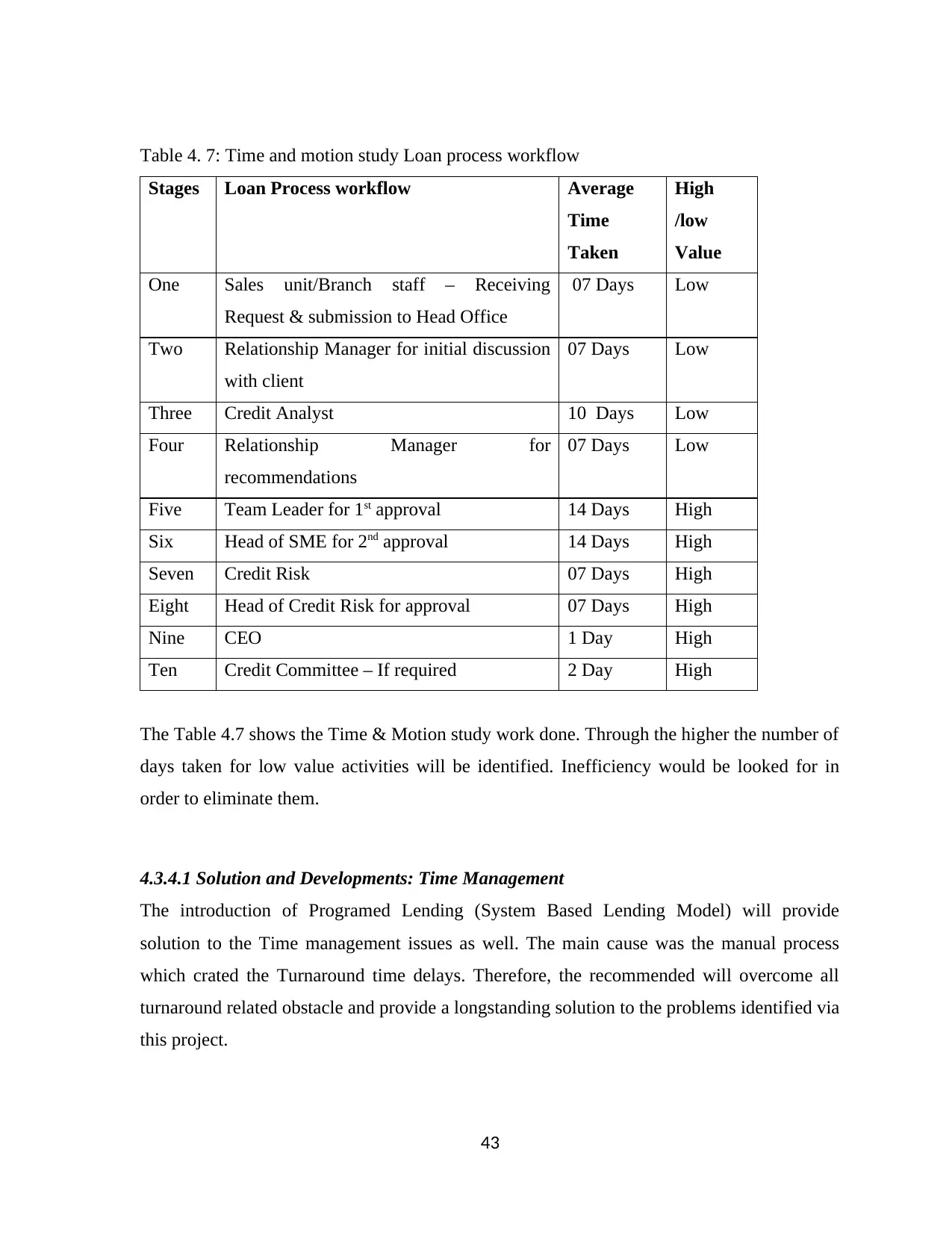
Table 4. 7: Time and motion study Loan process workflow
Stages Loan Process workflow Average
Time
Taken
High
/low
Value
One Sales unit/Branch staff – Receiving
Request & submission to Head Office
07 Days Low
Two Relationship Manager for initial discussion
with client
07 Days Low
Three Credit Analyst 10 Days Low
Four Relationship Manager for
recommendations
07 Days Low
Five Team Leader for 1st approval 14 Days High
Six Head of SME for 2nd approval 14 Days High
Seven Credit Risk 07 Days High
Eight Head of Credit Risk for approval 07 Days High
Nine CEO 1 Day High
Ten Credit Committee – If required 2 Day High
The Table 4.7 shows the Time & Motion study work done. Through the higher the number of
days taken for low value activities will be identified. Inefficiency would be looked for in
order to eliminate them.
4.3.4.1 Solution and Developments: Time Management
The introduction of Programed Lending (System Based Lending Model) will provide
solution to the Time management issues as well. The main cause was the manual process
which crated the Turnaround time delays. Therefore, the recommended will overcome all
turnaround related obstacle and provide a longstanding solution to the problems identified via
this project.
43
Stages Loan Process workflow Average
Time
Taken
High
/low
Value
One Sales unit/Branch staff – Receiving
Request & submission to Head Office
07 Days Low
Two Relationship Manager for initial discussion
with client
07 Days Low
Three Credit Analyst 10 Days Low
Four Relationship Manager for
recommendations
07 Days Low
Five Team Leader for 1st approval 14 Days High
Six Head of SME for 2nd approval 14 Days High
Seven Credit Risk 07 Days High
Eight Head of Credit Risk for approval 07 Days High
Nine CEO 1 Day High
Ten Credit Committee – If required 2 Day High
The Table 4.7 shows the Time & Motion study work done. Through the higher the number of
days taken for low value activities will be identified. Inefficiency would be looked for in
order to eliminate them.
4.3.4.1 Solution and Developments: Time Management
The introduction of Programed Lending (System Based Lending Model) will provide
solution to the Time management issues as well. The main cause was the manual process
which crated the Turnaround time delays. Therefore, the recommended will overcome all
turnaround related obstacle and provide a longstanding solution to the problems identified via
this project.
43
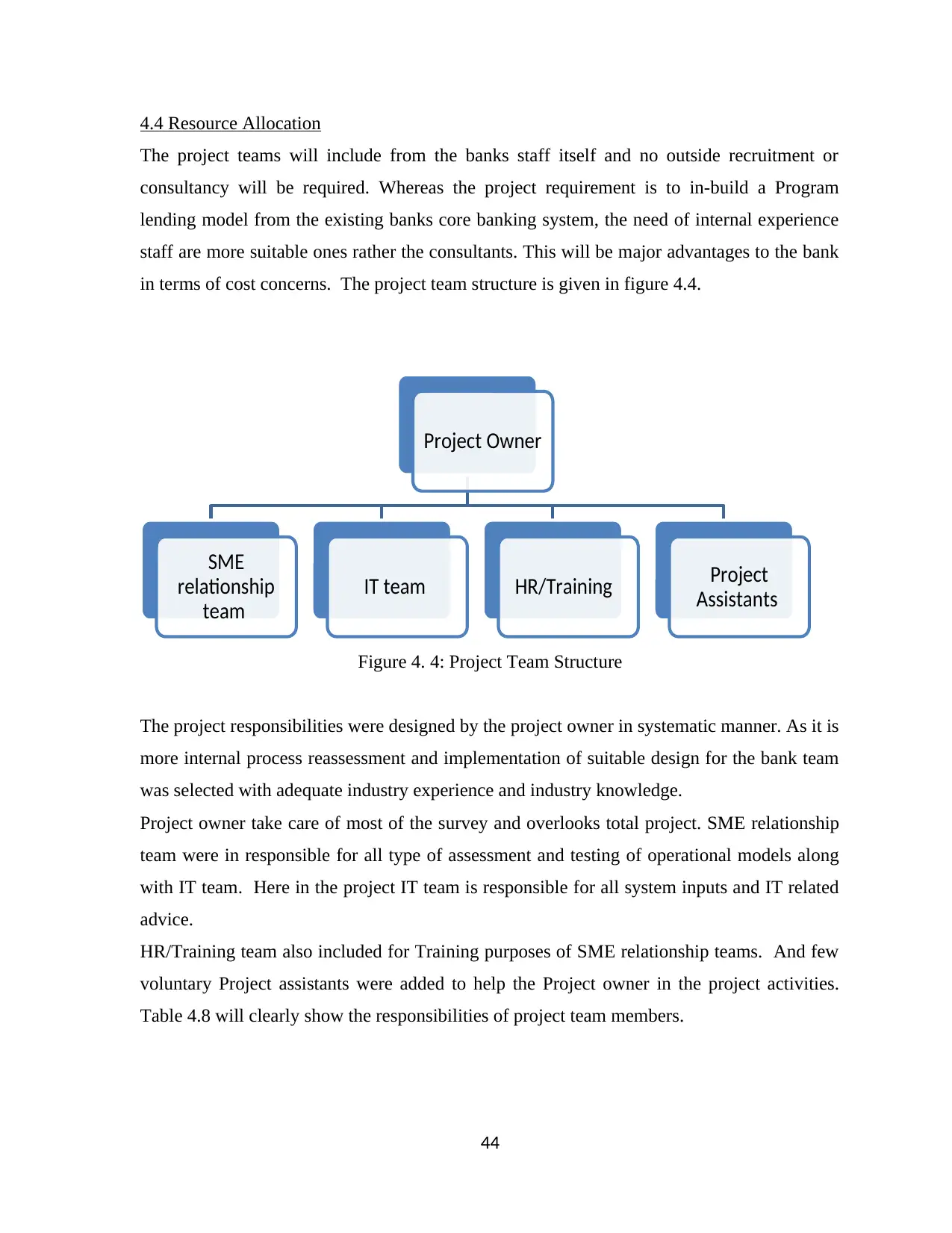
4.4 Resource Allocation
The project teams will include from the banks staff itself and no outside recruitment or
consultancy will be required. Whereas the project requirement is to in-build a Program
lending model from the existing banks core banking system, the need of internal experience
staff are more suitable ones rather the consultants. This will be major advantages to the bank
in terms of cost concerns. The project team structure is given in figure 4.4.
Figure 4. 4: Project Team Structure
The project responsibilities were designed by the project owner in systematic manner. As it is
more internal process reassessment and implementation of suitable design for the bank team
was selected with adequate industry experience and industry knowledge.
Project owner take care of most of the survey and overlooks total project. SME relationship
team were in responsible for all type of assessment and testing of operational models along
with IT team. Here in the project IT team is responsible for all system inputs and IT related
advice.
HR/Training team also included for Training purposes of SME relationship teams. And few
voluntary Project assistants were added to help the Project owner in the project activities.
Table 4.8 will clearly show the responsibilities of project team members.
44
Project Owner
SME
relationship
team
IT team HR/Training Project
Assistants
The project teams will include from the banks staff itself and no outside recruitment or
consultancy will be required. Whereas the project requirement is to in-build a Program
lending model from the existing banks core banking system, the need of internal experience
staff are more suitable ones rather the consultants. This will be major advantages to the bank
in terms of cost concerns. The project team structure is given in figure 4.4.
Figure 4. 4: Project Team Structure
The project responsibilities were designed by the project owner in systematic manner. As it is
more internal process reassessment and implementation of suitable design for the bank team
was selected with adequate industry experience and industry knowledge.
Project owner take care of most of the survey and overlooks total project. SME relationship
team were in responsible for all type of assessment and testing of operational models along
with IT team. Here in the project IT team is responsible for all system inputs and IT related
advice.
HR/Training team also included for Training purposes of SME relationship teams. And few
voluntary Project assistants were added to help the Project owner in the project activities.
Table 4.8 will clearly show the responsibilities of project team members.
44
Project Owner
SME
relationship
team
IT team HR/Training Project
Assistants
Secure Best Marks with AI Grader
Need help grading? Try our AI Grader for instant feedback on your assignments.
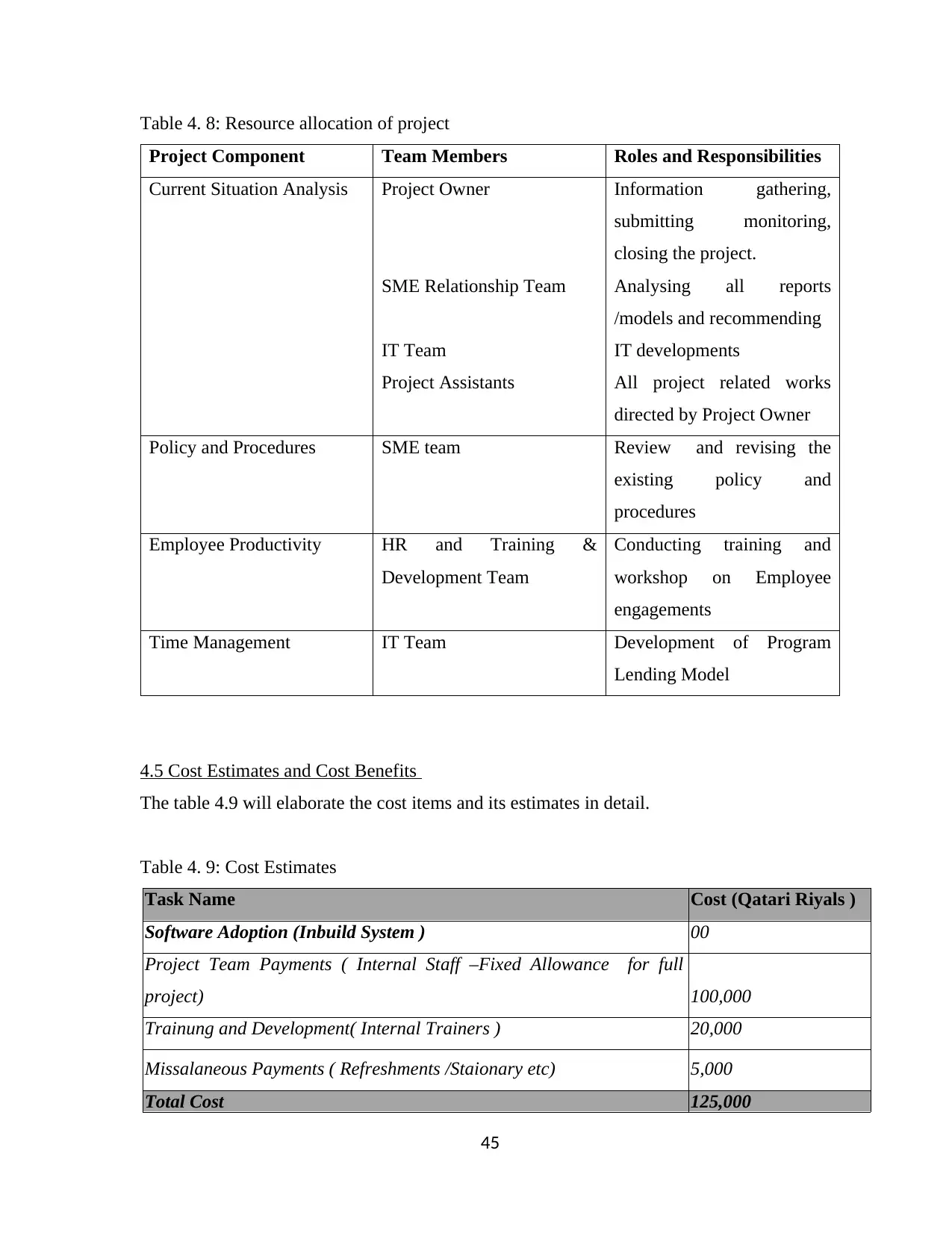
Table 4. 8: Resource allocation of project
Project Component Team Members Roles and Responsibilities
Current Situation Analysis Project Owner
SME Relationship Team
IT Team
Project Assistants
Information gathering,
submitting monitoring,
closing the project.
Analysing all reports
/models and recommending
IT developments
All project related works
directed by Project Owner
Policy and Procedures SME team Review and revising the
existing policy and
procedures
Employee Productivity HR and Training &
Development Team
Conducting training and
workshop on Employee
engagements
Time Management IT Team Development of Program
Lending Model
4.5 Cost Estimates and Cost Benefits
The table 4.9 will elaborate the cost items and its estimates in detail.
Table 4. 9: Cost Estimates
Task Name Cost (Qatari Riyals )
Software Adoption (Inbuild System ) 00
Project Team Payments ( Internal Staff –Fixed Allowance for full
project) 100,000
Trainung and Development( Internal Trainers ) 20,000
Missalaneous Payments ( Refreshments /Staionary etc) 5,000
Total Cost 125,000
45
Project Component Team Members Roles and Responsibilities
Current Situation Analysis Project Owner
SME Relationship Team
IT Team
Project Assistants
Information gathering,
submitting monitoring,
closing the project.
Analysing all reports
/models and recommending
IT developments
All project related works
directed by Project Owner
Policy and Procedures SME team Review and revising the
existing policy and
procedures
Employee Productivity HR and Training &
Development Team
Conducting training and
workshop on Employee
engagements
Time Management IT Team Development of Program
Lending Model
4.5 Cost Estimates and Cost Benefits
The table 4.9 will elaborate the cost items and its estimates in detail.
Table 4. 9: Cost Estimates
Task Name Cost (Qatari Riyals )
Software Adoption (Inbuild System ) 00
Project Team Payments ( Internal Staff –Fixed Allowance for full
project) 100,000
Trainung and Development( Internal Trainers ) 20,000
Missalaneous Payments ( Refreshments /Staionary etc) 5,000
Total Cost 125,000
45

Table 4.10 will explain the cost benefits from this project to the bank. Here in this project the
cost benefit will be assessed not in direct terms of money value rather it’s provides indirect
cost benefit and profit increase to the bank.
Table 4. 10: Cost benefits
Before Start of
Project
Qatari Riyals After Completion of
Project
Qatari
Riyals
Cost Benefits
per annum
(Qatari Riyals )
Software
Adoption through
outside vendor
( If requested)
1.5million Software adoption
from internal staff
100 k 1.4 million
Excess 15% Staff
salaries paid by
SME department
1.2mio per
annum
Relocation of Excess
staff salary savings
1.2mio 1.2mio
Total Benefit 2.6 million
4.6 Project output and outcomes
Table 4.11 will provide the details of the project outputs and outcomes.
Table 4. 11: Project output /outcomes
Components Output Outcome
Current Situation Analysis software adoption and
redesigned processes
No delays in Turnaround
time
Low Customer complaints
Policy & Procedures Revised Polciy &
Procedures
Growth in SME lending
Employee Productivity Training & Devlopments Highly groomed employees
46
cost benefit will be assessed not in direct terms of money value rather it’s provides indirect
cost benefit and profit increase to the bank.
Table 4. 10: Cost benefits
Before Start of
Project
Qatari Riyals After Completion of
Project
Qatari
Riyals
Cost Benefits
per annum
(Qatari Riyals )
Software
Adoption through
outside vendor
( If requested)
1.5million Software adoption
from internal staff
100 k 1.4 million
Excess 15% Staff
salaries paid by
SME department
1.2mio per
annum
Relocation of Excess
staff salary savings
1.2mio 1.2mio
Total Benefit 2.6 million
4.6 Project output and outcomes
Table 4.11 will provide the details of the project outputs and outcomes.
Table 4. 11: Project output /outcomes
Components Output Outcome
Current Situation Analysis software adoption and
redesigned processes
No delays in Turnaround
time
Low Customer complaints
Policy & Procedures Revised Polciy &
Procedures
Growth in SME lending
Employee Productivity Training & Devlopments Highly groomed employees
46
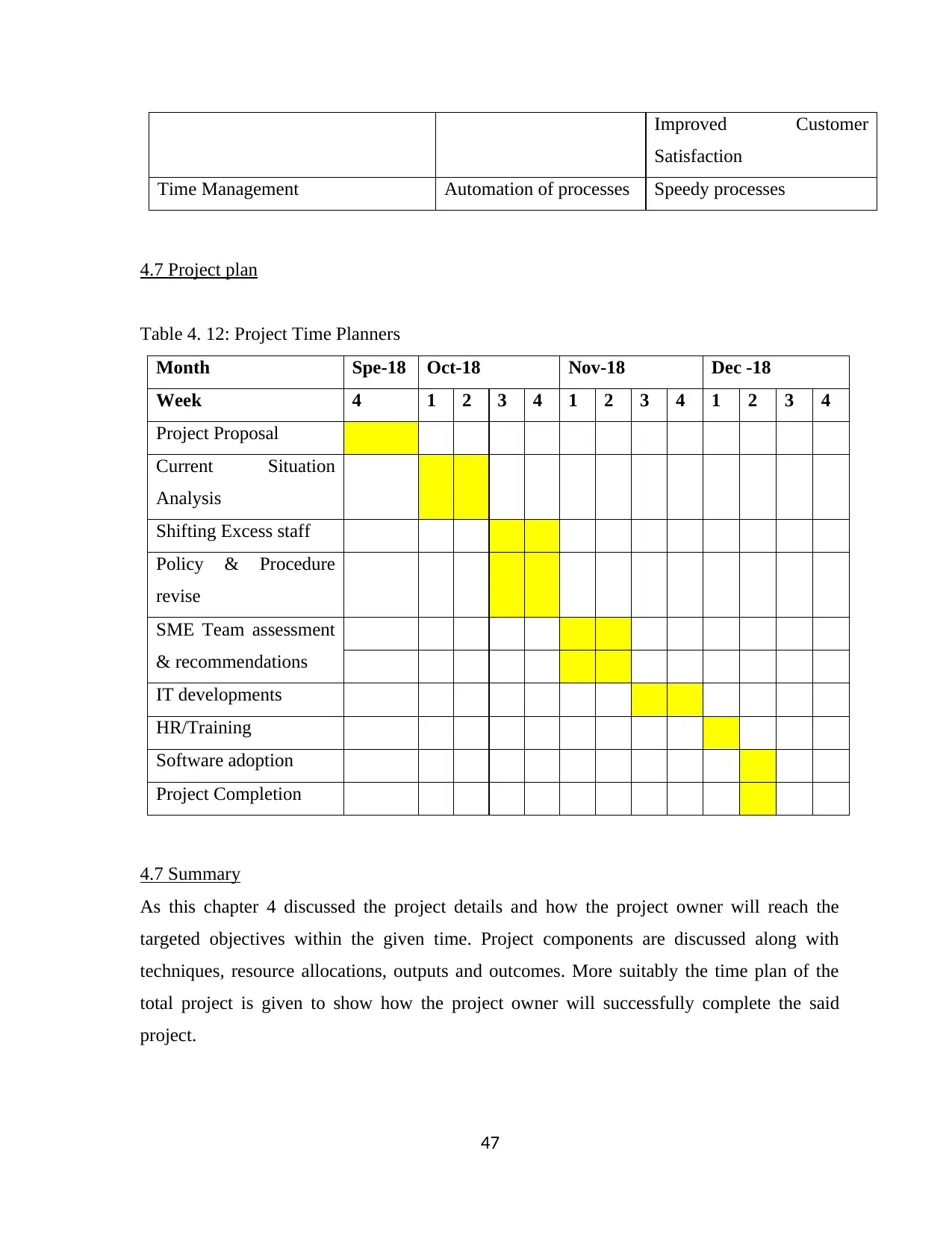
Improved Customer
Satisfaction
Time Management Automation of processes Speedy processes
4.7 Project plan
Table 4. 12: Project Time Planners
Month Spe-18 Oct-18 Nov-18 Dec -18
Week 4 1 2 3 4 1 2 3 4 1 2 3 4
Project Proposal
Current Situation
Analysis
Shifting Excess staff
Policy & Procedure
revise
SME Team assessment
& recommendations
IT developments
HR/Training
Software adoption
Project Completion
4.7 Summary
As this chapter 4 discussed the project details and how the project owner will reach the
targeted objectives within the given time. Project components are discussed along with
techniques, resource allocations, outputs and outcomes. More suitably the time plan of the
total project is given to show how the project owner will successfully complete the said
project.
47
Satisfaction
Time Management Automation of processes Speedy processes
4.7 Project plan
Table 4. 12: Project Time Planners
Month Spe-18 Oct-18 Nov-18 Dec -18
Week 4 1 2 3 4 1 2 3 4 1 2 3 4
Project Proposal
Current Situation
Analysis
Shifting Excess staff
Policy & Procedure
revise
SME Team assessment
& recommendations
IT developments
HR/Training
Software adoption
Project Completion
4.7 Summary
As this chapter 4 discussed the project details and how the project owner will reach the
targeted objectives within the given time. Project components are discussed along with
techniques, resource allocations, outputs and outcomes. More suitably the time plan of the
total project is given to show how the project owner will successfully complete the said
project.
47
Paraphrase This Document
Need a fresh take? Get an instant paraphrase of this document with our AI Paraphraser

48
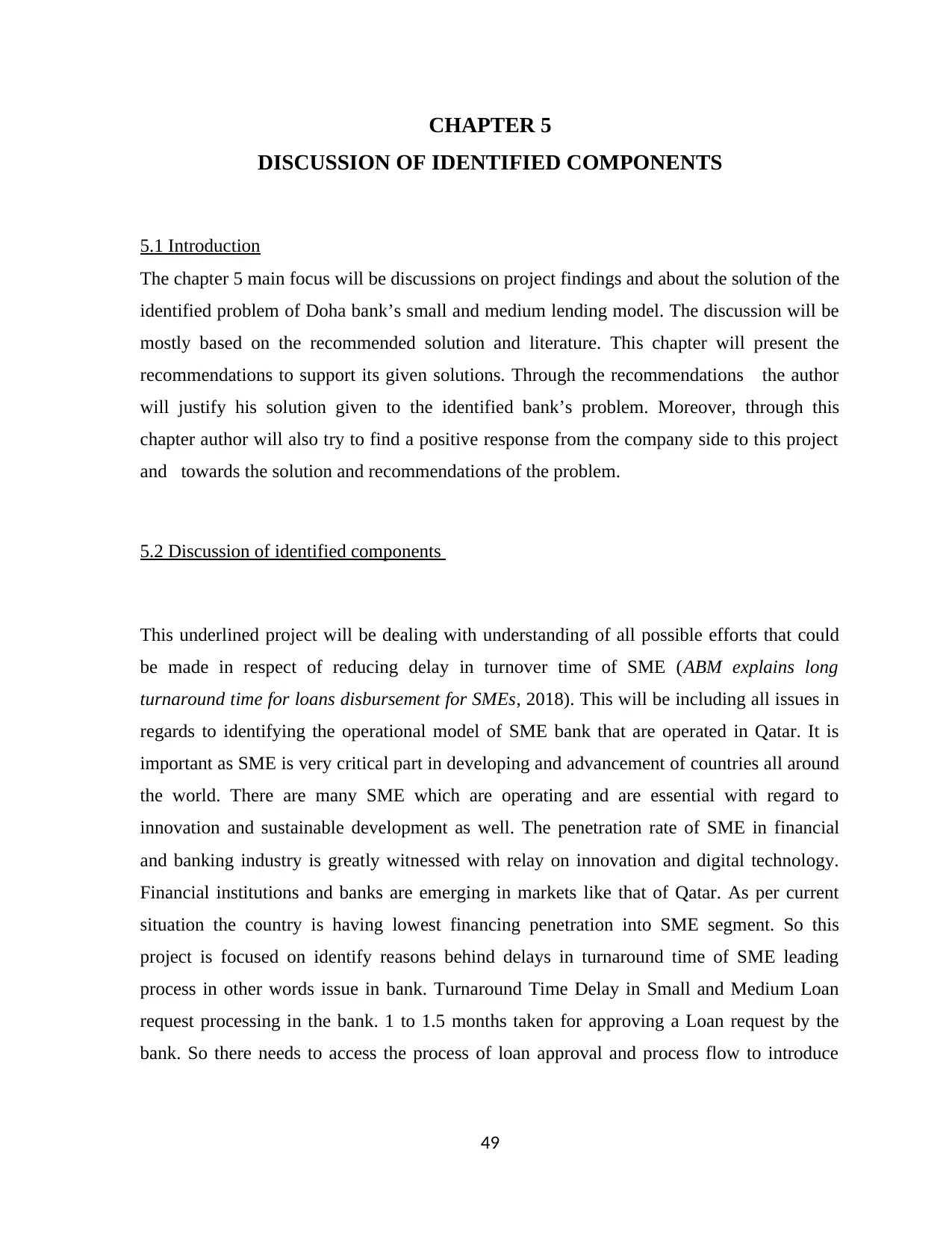
CHAPTER 5
DISCUSSION OF IDENTIFIED COMPONENTS
5.1 Introduction
The chapter 5 main focus will be discussions on project findings and about the solution of the
identified problem of Doha bank’s small and medium lending model. The discussion will be
mostly based on the recommended solution and literature. This chapter will present the
recommendations to support its given solutions. Through the recommendations the author
will justify his solution given to the identified bank’s problem. Moreover, through this
chapter author will also try to find a positive response from the company side to this project
and towards the solution and recommendations of the problem.
5.2 Discussion of identified components
This underlined project will be dealing with understanding of all possible efforts that could
be made in respect of reducing delay in turnover time of SME (ABM explains long
turnaround time for loans disbursement for SMEs, 2018). This will be including all issues in
regards to identifying the operational model of SME bank that are operated in Qatar. It is
important as SME is very critical part in developing and advancement of countries all around
the world. There are many SME which are operating and are essential with regard to
innovation and sustainable development as well. The penetration rate of SME in financial
and banking industry is greatly witnessed with relay on innovation and digital technology.
Financial institutions and banks are emerging in markets like that of Qatar. As per current
situation the country is having lowest financing penetration into SME segment. So this
project is focused on identify reasons behind delays in turnaround time of SME leading
process in other words issue in bank. Turnaround Time Delay in Small and Medium Loan
request processing in the bank. 1 to 1.5 months taken for approving a Loan request by the
bank. So there needs to access the process of loan approval and process flow to introduce
49
DISCUSSION OF IDENTIFIED COMPONENTS
5.1 Introduction
The chapter 5 main focus will be discussions on project findings and about the solution of the
identified problem of Doha bank’s small and medium lending model. The discussion will be
mostly based on the recommended solution and literature. This chapter will present the
recommendations to support its given solutions. Through the recommendations the author
will justify his solution given to the identified bank’s problem. Moreover, through this
chapter author will also try to find a positive response from the company side to this project
and towards the solution and recommendations of the problem.
5.2 Discussion of identified components
This underlined project will be dealing with understanding of all possible efforts that could
be made in respect of reducing delay in turnover time of SME (ABM explains long
turnaround time for loans disbursement for SMEs, 2018). This will be including all issues in
regards to identifying the operational model of SME bank that are operated in Qatar. It is
important as SME is very critical part in developing and advancement of countries all around
the world. There are many SME which are operating and are essential with regard to
innovation and sustainable development as well. The penetration rate of SME in financial
and banking industry is greatly witnessed with relay on innovation and digital technology.
Financial institutions and banks are emerging in markets like that of Qatar. As per current
situation the country is having lowest financing penetration into SME segment. So this
project is focused on identify reasons behind delays in turnaround time of SME leading
process in other words issue in bank. Turnaround Time Delay in Small and Medium Loan
request processing in the bank. 1 to 1.5 months taken for approving a Loan request by the
bank. So there needs to access the process of loan approval and process flow to introduce
49

automated loan processing system that is helping in reducing delay in time by 1 day from 2
days.
5.2.1 Project Component 1: Current Situation Analysis
In this current scenario SMEs are playing vital role in terms of sustainable development,
innovation and advancement so that globalisation could be increased and competition is
stronger as well. Banking and financial sector is also developing and growing in market of
Qatar where there is more SME’s operating. Moreover, Qatar is having lower penetration of
financial organisations while there is also very much interference of state to develop the
SMEs within country (Duchin and Sosyura, 2014). According to the current situation of
SMEs in country like that of disruption in technology which is hindering customers and they
are having number of complaints in regard to increase on time of activities. Doha bank is the
very first growing company of banking sector of Qatar which is able to understand the role
SMEs that is huge contributor of development of economy. In this respect Doha bank during
the year 2008 launched “Tatweer” that was in relationship with SME.
One of the major issues in this respect will be decrease in speed at which banking institutions
are operating and still not able to achieve excellence in its customer service. Moreover,
banking institution like Doha bank is facing Turnaround Time (TAT) for each and every
activity that is performed in firm. Like time duration for resolving issue of customer, printing
up of their documents, filing them, approval of loan amount then sanction of loan all these
activities or service are having its own time (Gutiérrez-Nieto, Serrano-Cinca and Camón-
Cala, 2016). But huge disruption in technologies resulted in increased in customer complaint
impacted processing and profits of banking institution.
5.2.2 Project Component 2: Policy & Procedures
Apart from all these things, there is paper work and documentations that need to be present
before resolving any issues related with customers. At the time when client visits bank for
taking any kind of loan, it is delayed due to number of policies and procedures. All the credit
application needs to undergo many formalities and approval from number of senior
50
days.
5.2.1 Project Component 1: Current Situation Analysis
In this current scenario SMEs are playing vital role in terms of sustainable development,
innovation and advancement so that globalisation could be increased and competition is
stronger as well. Banking and financial sector is also developing and growing in market of
Qatar where there is more SME’s operating. Moreover, Qatar is having lower penetration of
financial organisations while there is also very much interference of state to develop the
SMEs within country (Duchin and Sosyura, 2014). According to the current situation of
SMEs in country like that of disruption in technology which is hindering customers and they
are having number of complaints in regard to increase on time of activities. Doha bank is the
very first growing company of banking sector of Qatar which is able to understand the role
SMEs that is huge contributor of development of economy. In this respect Doha bank during
the year 2008 launched “Tatweer” that was in relationship with SME.
One of the major issues in this respect will be decrease in speed at which banking institutions
are operating and still not able to achieve excellence in its customer service. Moreover,
banking institution like Doha bank is facing Turnaround Time (TAT) for each and every
activity that is performed in firm. Like time duration for resolving issue of customer, printing
up of their documents, filing them, approval of loan amount then sanction of loan all these
activities or service are having its own time (Gutiérrez-Nieto, Serrano-Cinca and Camón-
Cala, 2016). But huge disruption in technologies resulted in increased in customer complaint
impacted processing and profits of banking institution.
5.2.2 Project Component 2: Policy & Procedures
Apart from all these things, there is paper work and documentations that need to be present
before resolving any issues related with customers. At the time when client visits bank for
taking any kind of loan, it is delayed due to number of policies and procedures. All the credit
application needs to undergo many formalities and approval from number of senior
50
Secure Best Marks with AI Grader
Need help grading? Try our AI Grader for instant feedback on your assignments.

authorities which takes time to approve a loan which consumes maximum time and results in
complaints from customers. So in regard to this senior or higher authority of bank should be
make their own efforts which need to be maintained at adequate level of organisation (Lee,
Sameen and Cowling, 2015). Thus, there are many situations when customers complain for
delay in addressing their issues and problems which generally occur due to policies and
procedures of bank.
Moreover, there is need in adherence to effective loan policies and procedures that bank
should be following. But then also they could be making their efforts in reducing the time
taken to resolve the issue of public and lengthy policies and procedures as well. As there is
doubtfully credit risk which arise at time of approving loan of clients without identification
and verification of their existence. Nevertheless, for this they should be using latest and
modern technologies and software which could help them in lowering down these risks
5.2.3 Project Component 3: Employee Productivity
Every bank and financial institutions are majorly operated and profit is generated by their
employees so bank need to regulate and develop the productivity of their staff. If the
productivity of employees is improved and developed, then this will help company to have
reduced chance of delays within lending process. In this respect bank can use various
motivational techniques and tools so that company could be improving or motivating their
employees. Thus, this will increase productivity of all staff members working within
operational framework. This productivity will determine individual working capabilities and
performance to make efforts in increasing profits and revenue of company.
Increasing capabilities of employee’s firm is helping themselves in its own way out that is
helping in reducing delay in time taken to conduct all their activities.
5.2.4 Project Component 4: Time Management
This is the most important factor of banking institution that is not allowing company to
perform in way it wants to. All sorts of approval and documentation will be based upon time
that is taken to perform each of the activities within banks. There is lot of time which is
51
complaints from customers. So in regard to this senior or higher authority of bank should be
make their own efforts which need to be maintained at adequate level of organisation (Lee,
Sameen and Cowling, 2015). Thus, there are many situations when customers complain for
delay in addressing their issues and problems which generally occur due to policies and
procedures of bank.
Moreover, there is need in adherence to effective loan policies and procedures that bank
should be following. But then also they could be making their efforts in reducing the time
taken to resolve the issue of public and lengthy policies and procedures as well. As there is
doubtfully credit risk which arise at time of approving loan of clients without identification
and verification of their existence. Nevertheless, for this they should be using latest and
modern technologies and software which could help them in lowering down these risks
5.2.3 Project Component 3: Employee Productivity
Every bank and financial institutions are majorly operated and profit is generated by their
employees so bank need to regulate and develop the productivity of their staff. If the
productivity of employees is improved and developed, then this will help company to have
reduced chance of delays within lending process. In this respect bank can use various
motivational techniques and tools so that company could be improving or motivating their
employees. Thus, this will increase productivity of all staff members working within
operational framework. This productivity will determine individual working capabilities and
performance to make efforts in increasing profits and revenue of company.
Increasing capabilities of employee’s firm is helping themselves in its own way out that is
helping in reducing delay in time taken to conduct all their activities.
5.2.4 Project Component 4: Time Management
This is the most important factor of banking institution that is not allowing company to
perform in way it wants to. All sorts of approval and documentation will be based upon time
that is taken to perform each of the activities within banks. There is lot of time which is
51
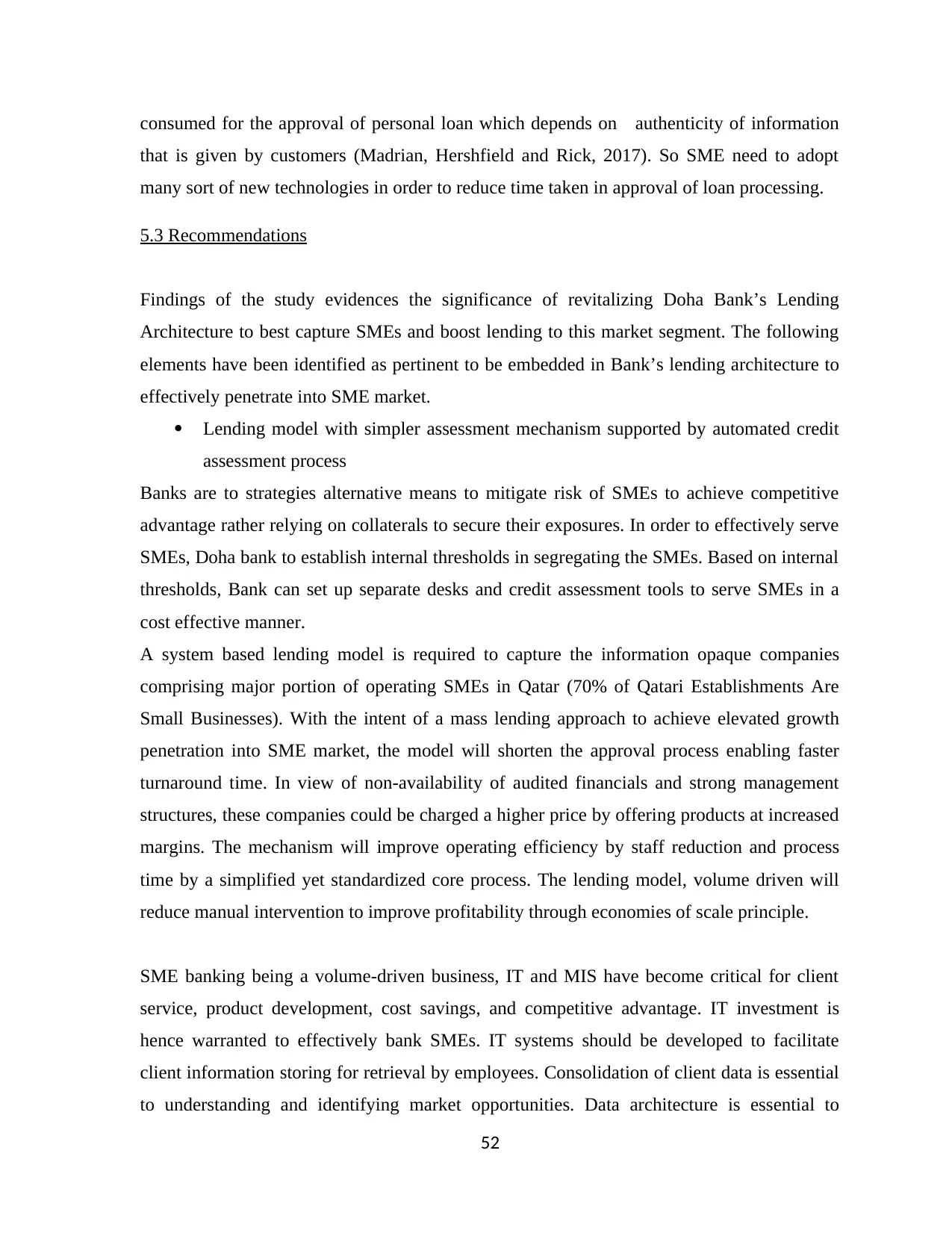
consumed for the approval of personal loan which depends on authenticity of information
that is given by customers (Madrian, Hershfield and Rick, 2017). So SME need to adopt
many sort of new technologies in order to reduce time taken in approval of loan processing.
5.3 Recommendations
Findings of the study evidences the significance of revitalizing Doha Bank’s Lending
Architecture to best capture SMEs and boost lending to this market segment. The following
elements have been identified as pertinent to be embedded in Bank’s lending architecture to
effectively penetrate into SME market.
Lending model with simpler assessment mechanism supported by automated credit
assessment process
Banks are to strategies alternative means to mitigate risk of SMEs to achieve competitive
advantage rather relying on collaterals to secure their exposures. In order to effectively serve
SMEs, Doha bank to establish internal thresholds in segregating the SMEs. Based on internal
thresholds, Bank can set up separate desks and credit assessment tools to serve SMEs in a
cost effective manner.
A system based lending model is required to capture the information opaque companies
comprising major portion of operating SMEs in Qatar (70% of Qatari Establishments Are
Small Businesses). With the intent of a mass lending approach to achieve elevated growth
penetration into SME market, the model will shorten the approval process enabling faster
turnaround time. In view of non-availability of audited financials and strong management
structures, these companies could be charged a higher price by offering products at increased
margins. The mechanism will improve operating efficiency by staff reduction and process
time by a simplified yet standardized core process. The lending model, volume driven will
reduce manual intervention to improve profitability through economies of scale principle.
SME banking being a volume-driven business, IT and MIS have become critical for client
service, product development, cost savings, and competitive advantage. IT investment is
hence warranted to effectively bank SMEs. IT systems should be developed to facilitate
client information storing for retrieval by employees. Consolidation of client data is essential
to understanding and identifying market opportunities. Data architecture is essential to
52
that is given by customers (Madrian, Hershfield and Rick, 2017). So SME need to adopt
many sort of new technologies in order to reduce time taken in approval of loan processing.
5.3 Recommendations
Findings of the study evidences the significance of revitalizing Doha Bank’s Lending
Architecture to best capture SMEs and boost lending to this market segment. The following
elements have been identified as pertinent to be embedded in Bank’s lending architecture to
effectively penetrate into SME market.
Lending model with simpler assessment mechanism supported by automated credit
assessment process
Banks are to strategies alternative means to mitigate risk of SMEs to achieve competitive
advantage rather relying on collaterals to secure their exposures. In order to effectively serve
SMEs, Doha bank to establish internal thresholds in segregating the SMEs. Based on internal
thresholds, Bank can set up separate desks and credit assessment tools to serve SMEs in a
cost effective manner.
A system based lending model is required to capture the information opaque companies
comprising major portion of operating SMEs in Qatar (70% of Qatari Establishments Are
Small Businesses). With the intent of a mass lending approach to achieve elevated growth
penetration into SME market, the model will shorten the approval process enabling faster
turnaround time. In view of non-availability of audited financials and strong management
structures, these companies could be charged a higher price by offering products at increased
margins. The mechanism will improve operating efficiency by staff reduction and process
time by a simplified yet standardized core process. The lending model, volume driven will
reduce manual intervention to improve profitability through economies of scale principle.
SME banking being a volume-driven business, IT and MIS have become critical for client
service, product development, cost savings, and competitive advantage. IT investment is
hence warranted to effectively bank SMEs. IT systems should be developed to facilitate
client information storing for retrieval by employees. Consolidation of client data is essential
to understanding and identifying market opportunities. Data architecture is essential to
52
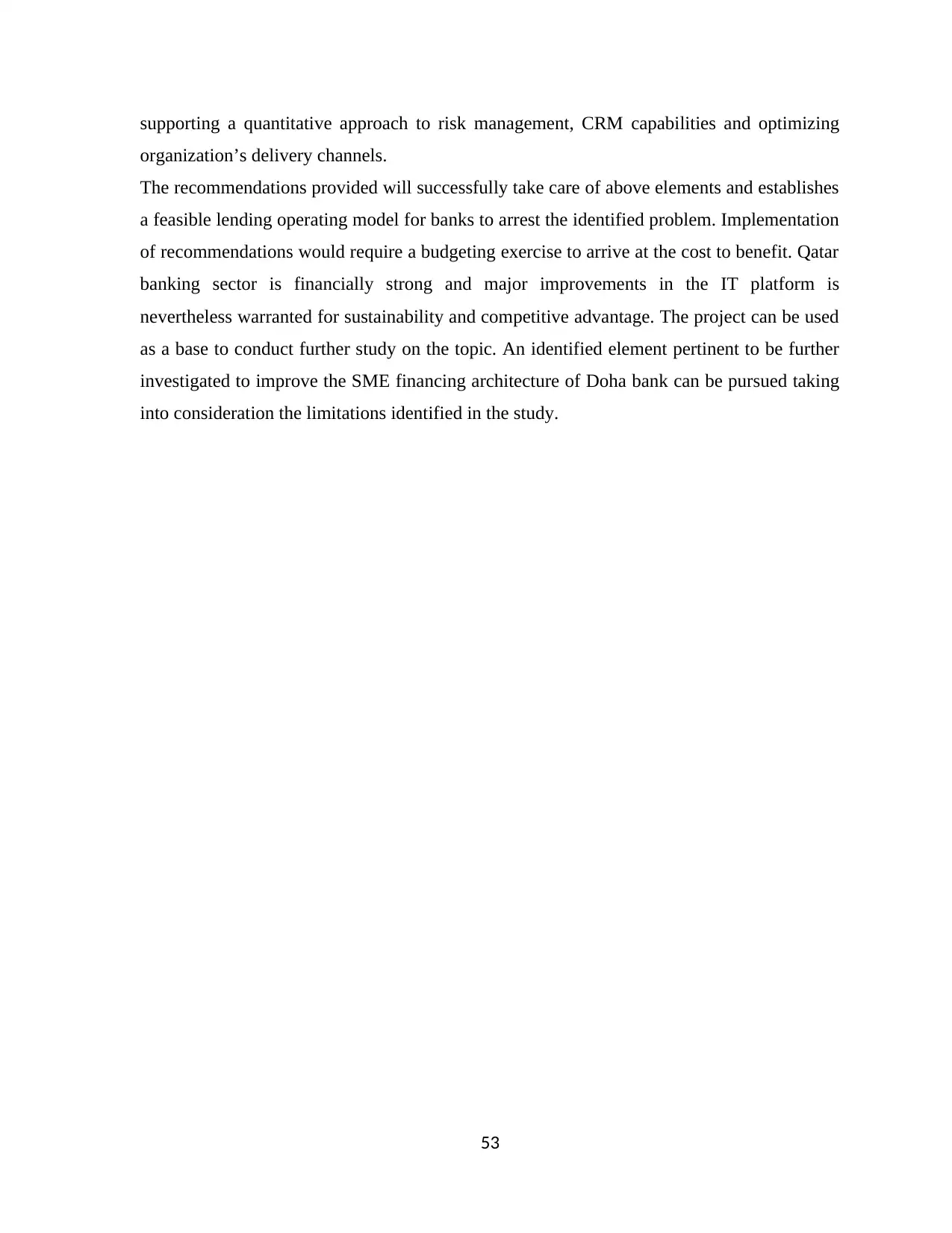
supporting a quantitative approach to risk management, CRM capabilities and optimizing
organization’s delivery channels.
The recommendations provided will successfully take care of above elements and establishes
a feasible lending operating model for banks to arrest the identified problem. Implementation
of recommendations would require a budgeting exercise to arrive at the cost to benefit. Qatar
banking sector is financially strong and major improvements in the IT platform is
nevertheless warranted for sustainability and competitive advantage. The project can be used
as a base to conduct further study on the topic. An identified element pertinent to be further
investigated to improve the SME financing architecture of Doha bank can be pursued taking
into consideration the limitations identified in the study.
53
organization’s delivery channels.
The recommendations provided will successfully take care of above elements and establishes
a feasible lending operating model for banks to arrest the identified problem. Implementation
of recommendations would require a budgeting exercise to arrive at the cost to benefit. Qatar
banking sector is financially strong and major improvements in the IT platform is
nevertheless warranted for sustainability and competitive advantage. The project can be used
as a base to conduct further study on the topic. An identified element pertinent to be further
investigated to improve the SME financing architecture of Doha bank can be pursued taking
into consideration the limitations identified in the study.
53
1 out of 61
Related Documents
Your All-in-One AI-Powered Toolkit for Academic Success.
+13062052269
info@desklib.com
Available 24*7 on WhatsApp / Email
![[object Object]](/_next/static/media/star-bottom.7253800d.svg)
Unlock your academic potential
© 2024 | Zucol Services PVT LTD | All rights reserved.





